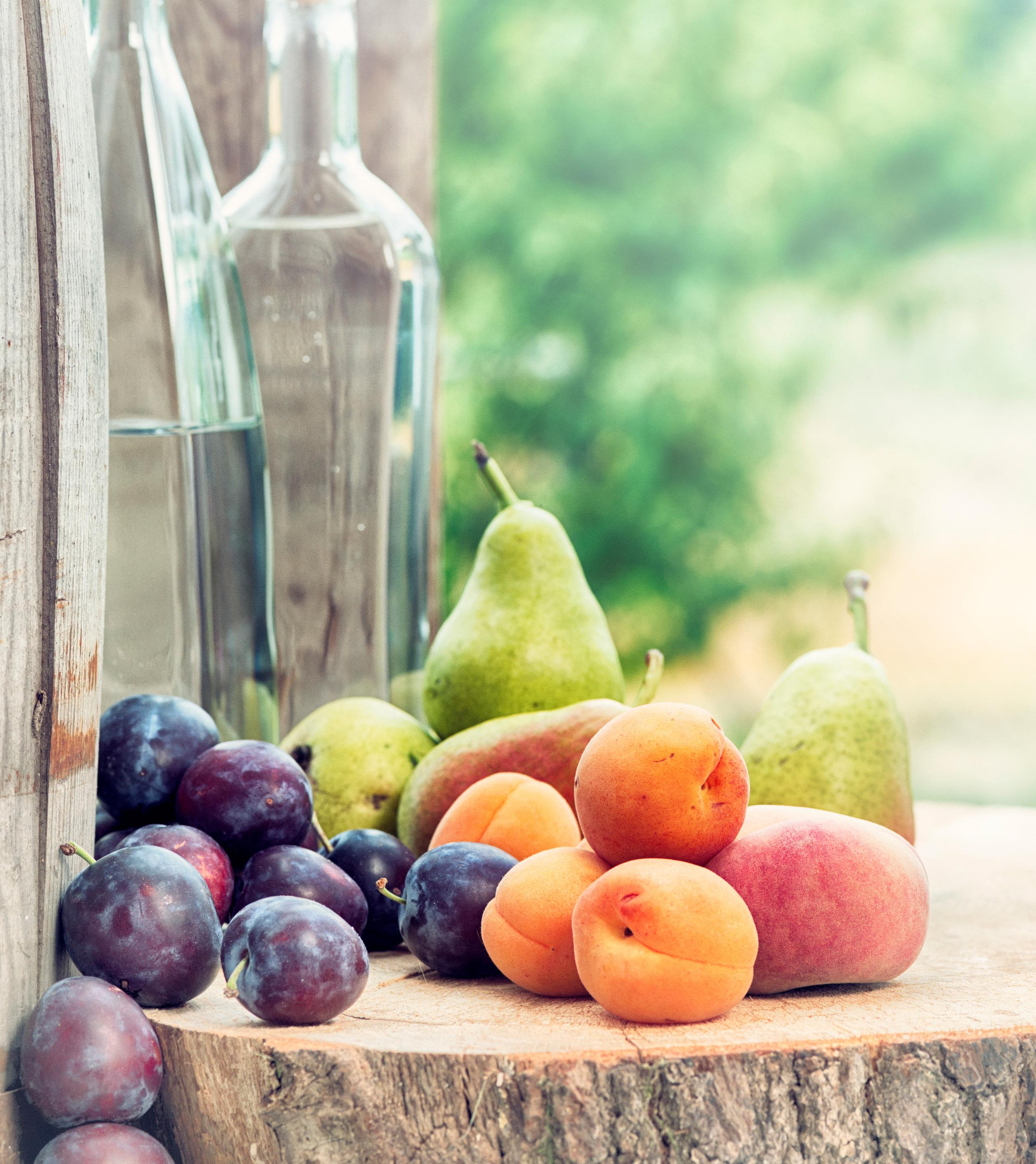
A PUBLICATION OF THE AMERICAN CRAFT SPIRITS ASSOCIATION THE ART, SCIENCE AND BUSINESS OF DISTILLING CRAFT SPIRITS VOL. 5, ISSUE 5 | SEPTEMBER/OCTOBER 2023 DISTRIBUTION & LOGISTICS OND 2023 OUTLOOK RAW MATERIALS THIS IS THE WHEY FRUIT-FORWARD WHY CRAFT BRANDY MAKERS DO WHAT THEY DO
WHERE SCIENCE MEETS ART
Yeasts, Nutrients, Enzymes and Bacteria
Our single source philosophy provides the highest quality ingredients, tailored technical service and education, and industry leading experience to support your needs. Your spirits are our passion, your needs are our motivation.
www.lallemanddistilling.com
www.lbds.com
distilledspirits@lallemand.com
 BY JEFF CIOLETTI
BY JON PAGE
BY JEFF CIOLETTI
BY JON PAGE
Chicago Won’t Let You Down
From dive bars to fine dining, spirits rooted in the Windy City are winning over locals and bringing in tourists.

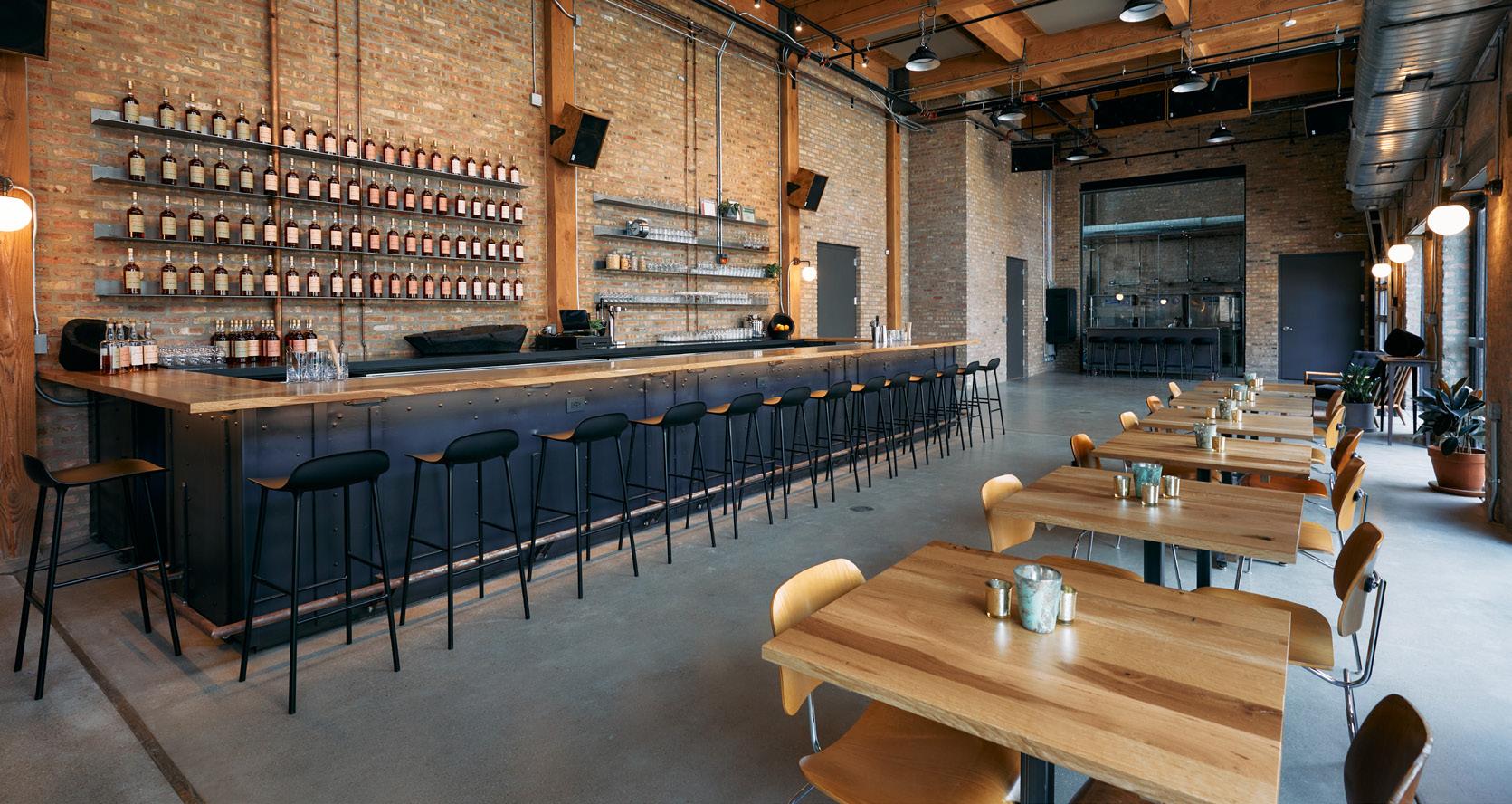
 BY JOHN HOLL
BY JOHN HOLL
SEPTEMBER/OCTOBER 2023 | 3 36 CONTENTS SEPTEMBER/OCTOBER 2023 44 48 FEATURES
The Fruit Stand
36
What keeps brandy makers in such a difficult category?
MEMBER SPOTLIGHT
the
Spirits
Spirits Distillery
harvests
award-winning spirits.
44
Betting
Farm on Craft
Stumpy’s
grows and
nearly all of its own grain to produce
DESTINATIONS
48 DISTILLING
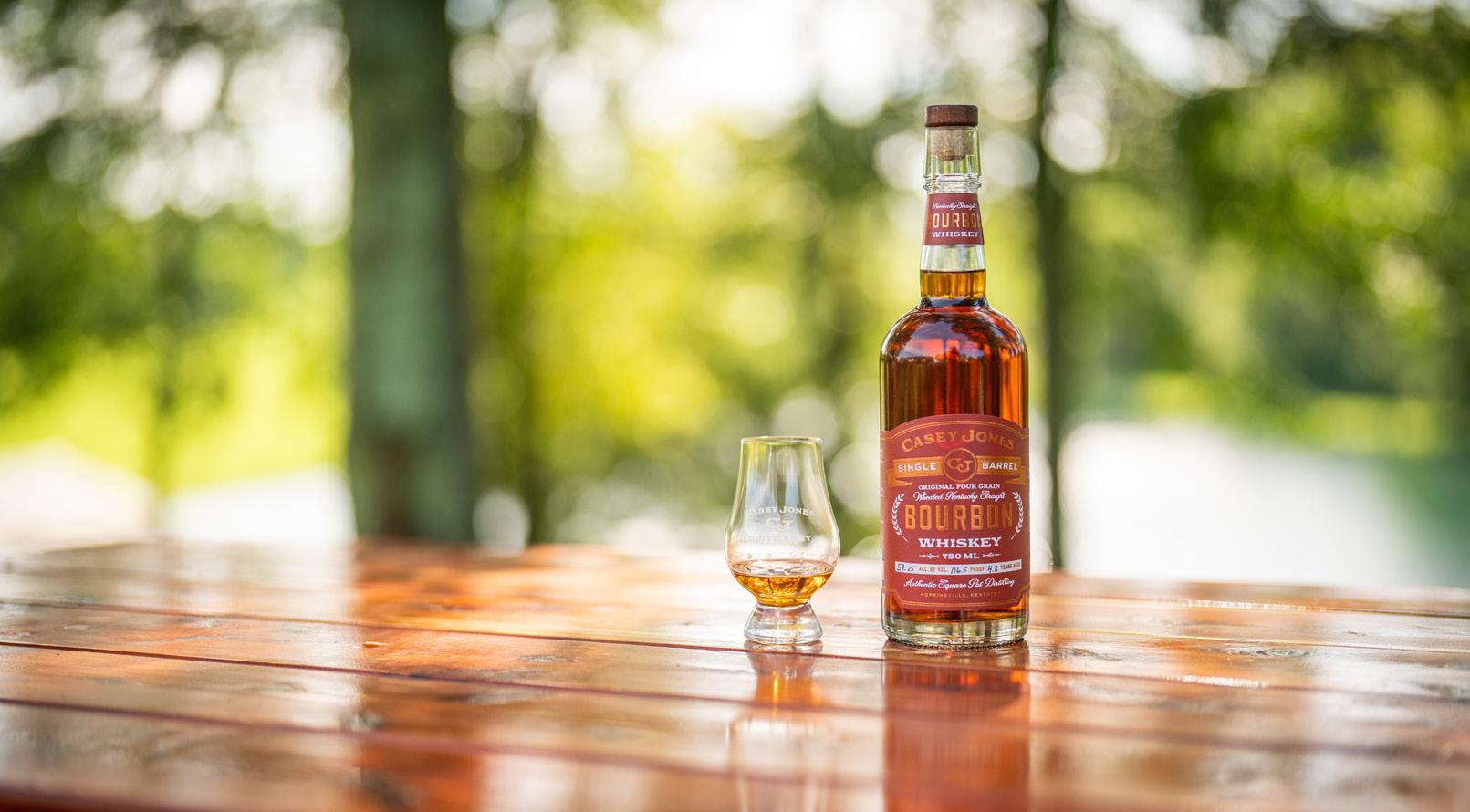

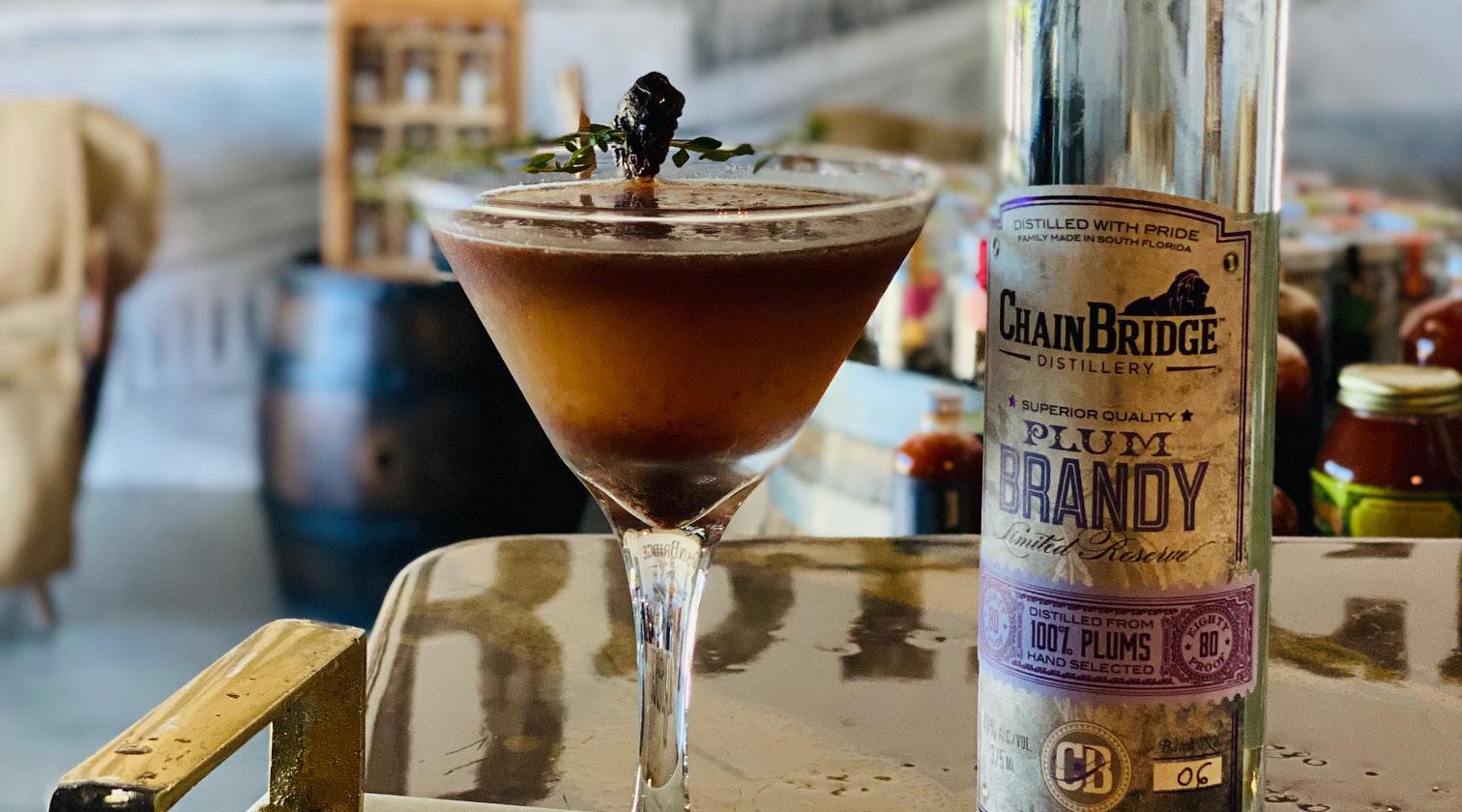
4 | SEPTEMBER/OCTOBER 2023 CRAFTSPIRITSMAG.COM 8 Editor’s Note 9 Contributors NEW SPIRITS 12 Recent releases from As Above So Below Distillery, Iron Fish Distillery and more INDUSTRY UPDATE 18 WOW (Women of Whiskey) Awards Winners Honored at Bourbon SIPosium IMBIBER ’ S BOOKSHELF 28 LEW ’ S BOTTOM SHELF 29 Legal, Ethical, Responsible BY LEW BRYSON STEPUP 30 Stepping Up to Better the Craft ACSA AFFAIRS 32 Take Part in the Craft Spirits Data Project Survey ACSA Announces 2023 Heartland Whiskey Competition Awards DATA DISTILLED 34 Brandy Volume Trends WHAT ’ S STIRRING 52 Flavorful concoctions from ACSA members DEPARTMENTS 12 32 52
RAW MATERIALS
56
The Way to Distill with Whey
The owners of Wisconsin’s Copper Crow Distillery break down the steps to working with the state’s plentiful cheese byproduct.
BY JERRY POLING AND STEVE NOLD
BUSINESS SENSE
58
From the Ground Up
The founders of pod architecture + design of Chapel Hill, North Carolinla, offer key considerations for building a distillery.
 BY DOUG PIERSON AND YOUN CHOI
BY DOUG PIERSON AND YOUN CHOI
DISTRIBUTION & LOGISTICS
62
The SOPs of OND
Distillers and distributors share advice on navigating the months of October, November and December.
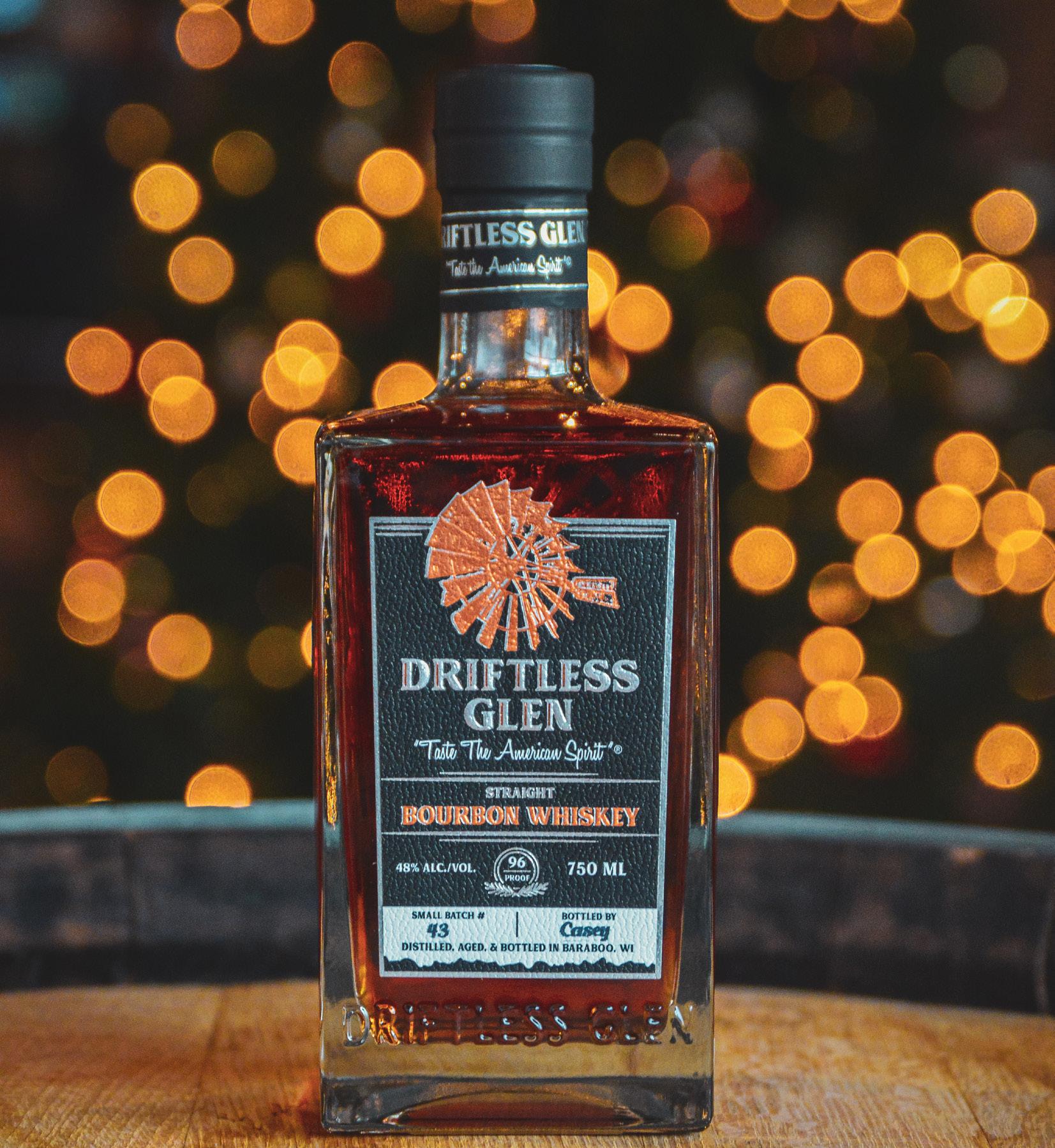 BY JOHN HOLL
BY JOHN HOLL
LEGAL CORNER
64
Social Media Footprints
Where are you leading the government and others?
BY TERI QUIMBY
TECHNOLOGY & E - COMMERCE
68
The E-Commerce Ecosystem
A Bar Convent Brooklyn panel ponders the digital marketing landscape.
BY JEFF CIOLETTI
SNAPSHOTS
70 Images from Tales of the Cocktail
CRAFTSPIRITSMAG.COM SEPTEMBER/OCTOBER 2023 | 5
62 58
CRAFT SPIRITS MAGAZINE
CEO, AMERICAN CRAFT SPIRITS ASSOCIATION | Margie A.S. Lehrman, margie@americancraftspirits.org
EDITOR IN CHIEF | Jeff Cioletti, jeff@americancraftspirits.org
SENIOR EDITOR | Jon Page, jon@americancraftspirits.org
ART DIRECTOR | Michelle Villas
MEDIA SALES REPRESENTATIVE | Annette Schnur, sales@americancraftspirits.org
CONTRIBUTORS | Lew Bryson, Youn Choi, John Holl, Steve Nold, Doug Pierson, Jerry Poling and Teri Quimby
AMERICAN CRAFT SPIRITS ASSOCIATION
IT STRATEGIST AND TECHNOLOGY IMPLEMENTATION MANAGER | Akshay Anikhindi, akshay@americancraftspirits.org
EDUCATION MANAGER | Kirstin Brooks, kirstin@americancraftspirits.org
DIRECTOR, MARKETING AND MEMBERSHIP | Anna Klainbaum, anna@americancraftspirits.org
ADMINISTRATIVE ASSISTANT | Albab Melaku, albab@americancraftspirits.org
DIRECTOR OF MEETINGS & EVENTS | Stephanie Sadri, stephanie@americancraftspirits.org
ACSA ADVISORS
STRATEGIC COMMUNICATIONS | Alexandra S. Clough, GATHER PR LEGAL | Ryan Malkin, Malkin Law, P.A.
PUBLIC POLICY | Jim Hyland, The Pennsylvania Avenue Group STATE POLICY | Michael Walker, The Walker Group, LLC
ACSA BOARD OF DIRECTORS, 2022-2023
PRESIDENT | Gina Holman, J. Carver Distillery (MN)
VICE PRESIDENT | Kelly Woodcock, Westward Whiskey (OR)
SECRETARY/TREASURER | Jessica J. Lemmon, Cart/Horse Distilling (PA)
EAST
Jordan Cotton, Cotton & Reed (DC)
Becky Harris, Catoctin Creek Distilling Co. (VA)
Jessica J. Lemmon, Cart/Horse Distilling (PA)
Tom Potter, New York Distilling Co. (NY)
Colin Spoelman, Kings County Distillery (NY)
Jaime Windon, Windon Distilling Co. (MD)
EX OFFICIO
Thomas Jensen, New Liberty Distillery (PA)
CENTRAL & MOUNTAIN
Gina Holman, J. Carver Distillery (MN)
Colin Keegan, Santa Fe Spirits (NM)
Amber Pollock, Backwards Distilling Company (WY)
Mark A. Vierthaler, Whiskey Del Bac (AZ)
Thomas Williams, Delta Dirt Distillery (AR)
ACSA PAST PRESIDENTS
2020-2023 | Becky Harris, Catoctin Creek Distilling Co.
2018-2020 | Chris Montana, Du Nord Craft Spirits
2017-2018 | Mark Shilling, Genius Liquids/Big Thirst
2016-2017 | Paul Hletko, FEW Spirits
2014-2016 | Tom Mooney, House Spirits
CRAFT SPIRITS MAGAZINE EDITORIAL BOARD
PACIFIC
Lucy Farber, St. George Spirits (CA)
Jake Holshue, Spirit Works Distillery (CA)
Jeff Kanof, Copperworks Distilling Co. (WA)
Kelly Woodcock, Westward Whiskey (OR)
ACSA PAC
Jordan Cotton, Cotton & Reed (DC)
Lew Bryson, Alexandra Clough, Sly Cosmopoulos, Dr. Dawn Maskell, Teri Quimby
For advertising inquiries, please contact sales@americancraftspirits.org For editorial inquiries or to send a news release, contact news@americancraftspirits.org
P.O. Box 470, Oakton, VA 22124
© 2023 CRAFT SPIRITS magazine is a publication of the American Craft Spirits Association.
FREE TO MEMBERS

Quench your thirst for knowledge in ACSA’s Craft Spirits Classroom.
For more information or to register, visit our website at https://americancraftspirits.org/education/webinars.
KNOWLEDGE IS POWER
YOU’RE A FINE DRINK
Journalism has changed dramatically since I studied it in college. For one thing, I would have never predicted back then that I’d be editing something called “a digital magazine”—nor that you’d be reading one, as you’re doing right now. But the fundamentals of reporting haven’t changed, as they hadn’t for generations before I even got into the game. I’d imagine one of the first items on a journalism 101 syllabus remains the concept of the five Ws and H. It’s such a universal concept that I’d suggest applying it to other facets of life—including spirits marketing. It’s especially applicable to the category featured on the cover of this issue. Brandy—and under this catch-all term, I include aged grape and apple products, as well as eau de vie/schnaps/palinka and grappa—is complicated business to say the least. And boiling it down to six, catch-all, media-inspired words is a fool’s errand. But I’m going to try it anyway.
WHO
“Who” exactly is the brandy consumer? Many are still trying to figure that out, but, for starters, it could be someone connected to it through their heritage—European expats and their descendants with strong cultural ties to the products. But, more broadly, it’s anyone with a sense of adventure who wants to explore beyond their comfort zone of, say, whiskey or any of the other leading categories.
WHAT
Lesson number one for any consumer just entering the category will always have to be “What on earth is brandy?”
It’s one of the most misunderstood spirits, with so many misconceptions. Giving consumers a working knowledge of the category is practically half the battle.
WHERE
The “where” of brandy is a key selling point. It’s a spirit with a sense of place, whether it’s those aforementioned cultural ties to foreign lands or its history right here in the U.S. After all, it was America’s first native spirit, before anyone had even heard the word “whiskey.” In a more modern sense, it’s very much linked to where its raw materials are sourced—whether the apple orchards of the Pacific Northwest, the grapes of the Golden State, the berries of New England or the peaches of the Southeast. One might even be tempted to use the “t”
word (terroir) when describing it.
WHEN

Part of any great spirits marketing story is its category’s origin. There’s four centuries of brandy history dating back to pre-Colonial America. Overseas, that tale stretches at least three quarters of a millennium.
WHY
Why does anyone make brandy, when its ingredients are hyper-seasonal and often difficult to source and so few mainstream consumers are familiar with it? That’s the overall focus of the cover story. Some of the country’s top producers of both brown and clear brandies share their stories on just what keeps them going.
HOW
This goes back to the ingredients. As is the case with any spirit, one of the proven means of getting consumers to embrace their products is to show them how it’s made on a distillery tour. I think that’s doubly true for fruit-based distillates, as it is for grain-based products. Raw fruits are a much larger part of consumers day-to-day lives than raw, unprocessed grains. Not only are they much more relatable, they’re undeniably more colorful!
Again, this is a massive oversimplification of a category that is anything but simple. For something a little more in-depth, I invite you to head over to page 36. As this is our first issue of fall 2023, we hope you’re able to harvest some actionable insights. ■
Jeff Cioletti Editor in Chief

8 | SEPTEMBER/OCTOBER 2023 CRAFTSPIRITSMAG.COM Editor ’ s Note
Lew Bryson has been writing about beer and spirits full-time since 1995. He was the managing editor of Whisky Advocate from 1996 through 2015, where he also wrote the American Spirits column, and reviewed whiskeys. He is currently a Senior Drinks Writer for the Daily Beast, and also writes for WhiskeyWash.com, American Whiskey and Bourbon+. He is the author of “Tasting Whiskey” (Storey Publishing, 2014), a broad survey of the whiskeys of the world, their history and manufacture. He has also written four regional brewery guidebooks.
Steve Nold is a biology professor at University of Wisconsin-Stout who works with Curt Basina of Copper Crow Distillery to improve cheese whey fermentation. He and his microbiology students work to improve ethanol yield. His students now work to characterize the components of new Copper Crow products using high-end chemistry instruments. When not sampling Copper Crow products, Steve can be found building timber frames, constructing boats, wiring high fidelity tube amplifiers and restoring old woodworking machinery.
Jerry Poling is the communications manager at University of Wisconsin-Stout. He writes about students, faculty, staff and alumni and how they embrace the university’s polytechnic mission, which includes applied learning, collaboration with business and industry, and career outcomes. Poling, a former journalist, has authored two books on the Green Bay Packers, one on Henry Aaron and one about the history of UW-Stout.


John Holl is a journalist covering the beer industry. He’s the author of several books including “Drink Beer, Think Beer: Getting to the Bottom of Every Pint” and “The American Craft Beer Cookbook.” He is the co-host of the podcast Steal This Beer, and his work has appeared in The New York Times, The Washington Post, Wine Enthusiast and more. John has lectured on the culture and history of beer and judged beer competitions around the world.


In 2016, architect Doug Pierson founded pod architecture + design with his partner in work and life, international experiential designer Youn Choi. Together, they lead a studio that provides services in architecture, interiors, environmental and experiential graphics, urban design, and master planning. After they relocated their firm and family from Los Angeles to Chapel Hill, North Carolina, Doug became a professor of architecture at N.C. State University’s College of Design and a member of the Triangle Architecture & Design Society.

Teri Quimby, JD, LLM is an attorney, president of Quimby Consulting Group and a former state alcohol regulator. She is known for her outspoken position on the need to modernize alcohol laws and regulations. Writing on legal, compliance and alcohol issues, her work has appeared in places like USA Today, Detroit News, Governing, Reason and American Spectator. In 2017, Crain’s Detroit Business recognized Teri on its list of Most Notable Lawyers in Michigan.

Contributors CRAFTSPIRITSMAG.COM SEPTEMBER/OCTOBER 2023 | 9
Thank You , Sponsors !
ABE Equipment
ABE Equipment will drive cutting-edge innovations and industry-leading service to ensure entrepreneurs can maximize their opportunities to succeed. Our parent company is Norland International, a leading supplier of turn-key beverage equipment and more. abeequipment.com
ABM Equipment

ABM Equipment has been the leading provider of integrated grain handling solutions to craft distilling spaces for nearly 30 years. Their unique value proposition is “sturdy, creative layouts that are built to move and scale with your space.” abmequipment.com

Amoretti
Amoretti specializes in super concentrated natural infusions for artisan craft beverages. Amoretti sources the freshest and tastiest fruits, herbs, spices and more, paying attention to quality and consistency to ensure an impeccable, consistent brew in every barrel. amoretti.com
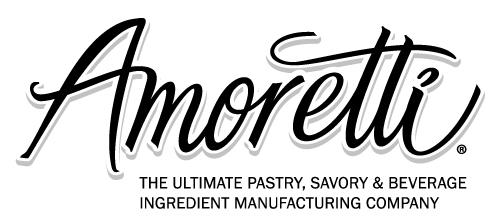
Fermentis
Fermentis is an agile and expanding company, dedicated to fermented beverages. It is a unit of Lesaffre Group, global key player in yeast for over 160 years. Our roots are strong while having an audacious spirit. As things happen during the fermentation … our goal is to discover them in terms of taste, flavor and pleasure. fermentis.com/en/
Malkin Law
Malkin Law focuses on serving the needs of the alcohol beverage industry. We regularly assist with licensing, review of industry specific agreements, trade practices and navigating state laws. Malkin Law is also honored to be Legal Counsel for ACSA. malkinlawfirm.com
FIVE x 5 Solutions
FIVE x 5 Solutions believes that distillery software should scale with you. We’re more than a service provider: we’re a committed partner in your distillery’s success and take pride in providing the most complete solution for your growing operation. We take your business as seriously as you do. Fx5solutions.com

The Barrel Mill
The Barrel Mill is a familyowned cooperage specializing in premium white oak aging barrels, infusion spirals, and more. Our products are made from the finest materials we can find, hand-selected, hand-crafted, and aged to perfection. thebarrelmill.com

Glencairn Crystal
Glencairn Crystal is a leading manufacturer of bespoke crystal and glass. For over three decades, this family business, based in Scotland, has gained an international reputation for fine crystal and glassware. Best known for the creation of the Glencairn Glass, the official glass for whisky. glencairn.co.uk
Berlin Packaging
Berlin Packaging, the only Hybrid Packaging Supplier® of plastic, glass and metal containers & closures, supplies billions of items annually, along with package design, financing, consulting, warehousing and logistics services. berlinpackaging.com

Harvest Hosts
Harvest Hosts connects over 225,000 self-contained RVers to a network of thousands of small businesses (hosts). Hosts simply offer RVers a one-night stay on their property, and, in return, RVers patronize the business while spending the night. Our program is a cost-free opportunity and 100% of the money spent onsite goes straight to the Host. harvesthosts.com

MGP


At MGP, every step of creating a premium distilled bourbon, whiskey, rye, gin and vodka is guided by a passion bordering on obsession. We tirelessly collaborate with our partners, regardless of size, to develop and consistently produce the exact flavor profile that’s right for their brand. And for their discerning consumers. mgpingredients.com/distilled-spirits
Moonshine University

The nation’s premier educational distillery, bringing together specialists from every facet of the industry to provide education, training and professional services to start-ups and existing companies. Moonshine University is housed next door to sister company Flavorman, an international custom beverage development company. moonshineuniversity.com
Park Street
Park Street delivers productivityenhancing and cost-saving back-office solutions, advisory services, working capital, compliance management, export solution, integrated accounting and human resources management solutions. parkstreet.com

Saverglass
Saverglass provides for premium and super-premium spirits, still & sparkling wines and craft beers. Recognized for its innovation, its glass-making expertise and the quality of its glass, products and designs, Saverglass is the partner of choice. saverglass.com

Supercap
Supercap has been producing closures for spirits since 1999. We are present in the United States with a great sales network with partners and agents, thus being able to help and advise you in the choice of the best stopper for your spirits. supercap.it
Tapì
Tapì is an international group specializing in the design and production of miniature packaging design masterpieces. Our closures are based on cutting-edge functionality and technology, with an exclusive style that elegantly showcases each product. tapigroup.com
Thousand Oaks Barrel Co.
Thousand Oak Barrel Co. manufactures barrels to age and serve your spirits. All products offer a variety of options for customizing and branding with your personalized design. 1000oaksbarrel.com

The American Craft Spirits Association would like to thank all of our annual sponsors and our key supporters of education. We are grateful for all of your support throughout the year. Cheers!
Briess Malt & Ingredients Co.
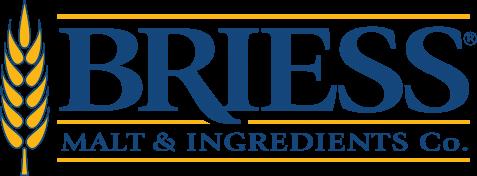
Since 1876, we’ve been supplying the highest quality malts in the industry. We’ve distinguished ourselves by developing the most extensive line of specialty malts made by any malting company in the world. We provide everything from malts to pure malt extracts, brewers flakes and filtering aids. briess.com
BSG Distilling

As the craft distilling industry grows, BSG Distilling has been focused on supplying distillers with the best ingredients from around the world. Today, the craft distilling market trusts BSG Distilling to deliver the finest ingredients at competitive prices, without sacrificing customer service. bsgdistilling.com
Chevalier Casks
Chevalier Casks is a distributor of high-end wine and whiskey casks and a broker of bulk spirits. chevaliercasks.com
CIE
CIE is a state-of-the-art, 75 million wine gallon, beverage and industrial graded, commercial scale, alcohol facility located in Marion, Indiana. CIE supplies pure and denatured alcohols to customers in the spirit, beauty, personal care, medical, food-flavor and industrial markets. cie.us

Independent Stave Co.
We’ve been in this industry for over 100 years, during which time we’ve learned a thing or two about what makes a great barrel to age great spirits. Partnering with distillers, we think outside the box to develop new products that push your vision forward. iscbarrels.com
ISTS
ISTS makes workplaces safer, employees ready and compliance uncomplicated. ISTS has extensive experience working with the spirits industry, so our programs are totally customized to address your site. istsky.com

Kason Corporation

Kason Corporation is the industry-leading global spent grain processing equipment manufacturer that distilleries can count on for efficiency, cost savings and reducing waste and disposal costs. kason.com
Kraftwork
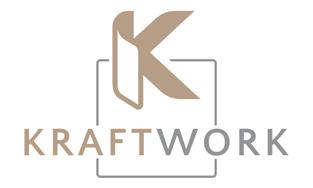
Kraftwork provides inexpensive and eco-friendly in-store displays for the beverage industry. Brands can choose from our extensive library of stock designs or request a custom design that is specific to their capacity or promotional needs. kraftwork.com
Lallemand Biofuels & Distilled Spirits
The leader in supplying fermentation products and services to the distilled spirits industry, we specialize in the research, development, production, and marketing of yeast, yeast nutrients, enzymes, and bacteria. lallemanddistilling.com
Soderstrom Architects
Soderstrom Architects’ Ferar Wine & Spirits Studio has been involved in the design and master planning of more than 70 wineries and distilleries. Our studio was founded with a passion for design that conveys the special sense of place inherent in the site. sdra.com
Sovos ShipCompliant
Sovos ShipCompliant has been the leader in automated alcohol beverage compliance tools for more than 15 years, providing a full suite of cloudbased solutions to distilleries, wineries, breweries, cideries, importers, distributors and retailers. sovos.com/shipcompliant
Specific Mechanical Systems
Since 1984, Specific Mechanical Systems has handcrafted brewing and distilling systems for the craft beer and spirits industries, in addition to supplying various industries with complex processing equipment. specificmechanical.com
Steric Systems
The Steric Systems PureSmooth process is a method of “polishing” distilled spirits to reduce alcohol burn, open up and balance flavors, and improve mouth feel. It works on both aged and unaged spirits. stericsystems.com
Ultra Pure
Signature Spirits, a division of Ultra Pure, is the leading independent supplier of bulk spirits in the U.S. and has the largest selection of alcohols stocked across its nine warehouses. We supply approximately 1,000 distilleries and brand owners with virtually every type of alcohol. ultrapure-usa.com

Whalen Insurance
Whalen Insurance is a second-generation insurance agency owned and operated by Peter Whalen. He started a program for craft breweries in the mid 1980s and expanded to craft distilleries almost 10 years ago. It provides all property and liability coverages needed to safely operate a distillery. whaleninsurance.com
Wine & Spirits Wholesalers of America
The Wine & Spirits Wholesalers of America (WSWA) is the national trade association representing the wholesale tier of the wine and spirits industry. It is dedicated to advancing the interests and independence of wholesale distributors and brokers of wine and spirits. wswa.org

WV Great Barrel Co.

The best-performing whiskey barrel on the market, precision built in the heart of Appalachia. Infrared toast and controlled char standard on every barrel.
wvgbc.com/
S PECIFIC brewing distilling
As Above So Below
Distillery of Santa Fe, New Mexico, announced the limited release of its Apricot Eau de Vie

With apricot trees in abundance producing plentiful stone fruit all around Santa Fe, the distillery has partnered with the local community to gather the apricot fruit, then ferment and distill it—making the 90-proof spirit.
To mark its seventh year, Thompsonville, Michigan-based Iron Fish Distillery will re-release the Mad Angler Bourbon, Rye and Bottled in Bond estate whiskies and celebrate completion of a major commitment to triple production capacity of its estate whiskey. Iron Fish is also releasing Toasted Godfather Old Fashioned Ready-to-Pour. The 77-proof offering is crafted with bourbon whiskey, estate-grown rye whiskey, amaretto and cherry maple smoked bitters.
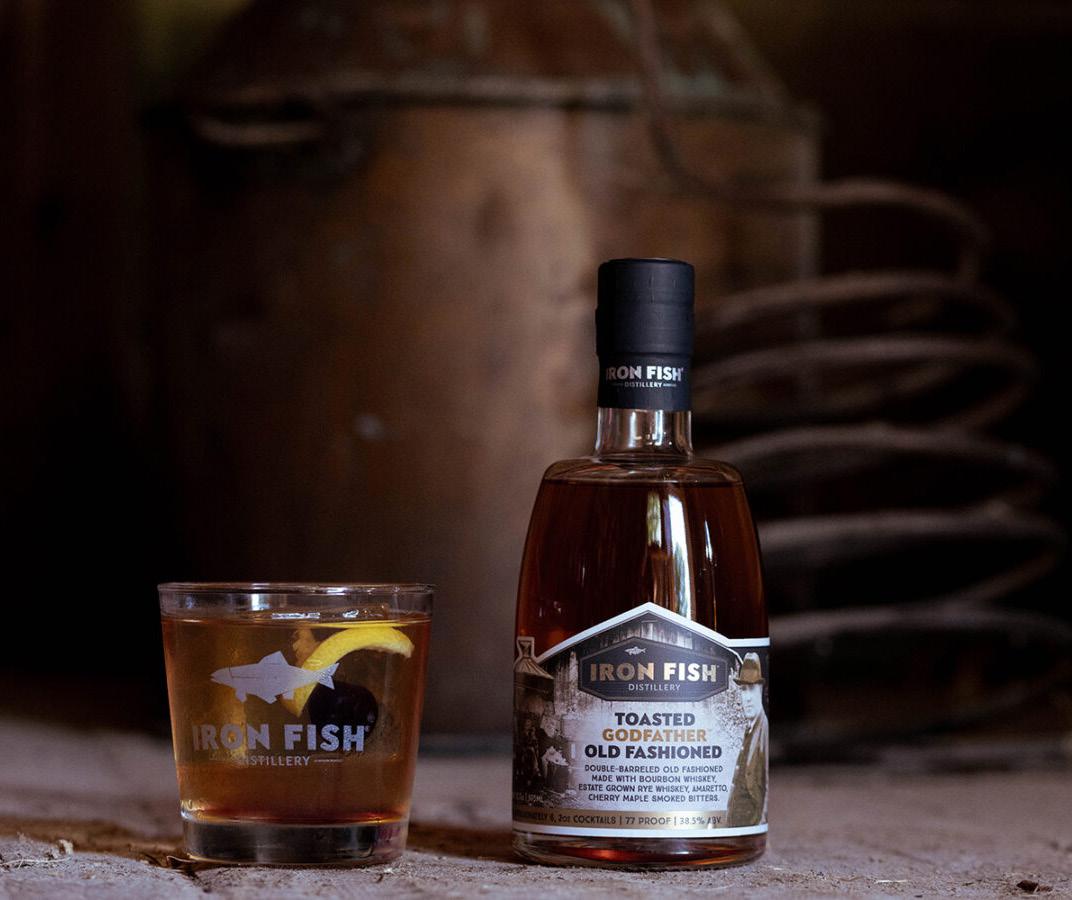
Barrell Craft Spirits of Louisville, Kentucky, launched the new Barrell Bourbon Cask Finish Series. The limited-edition series utilizes the company’s blending and finishing expertise to make bespoke blends of straight bourbon whiskeys with unique finishes. The Cask Finish Series will introduce two blends each year, beginning with the launch of the first two blends this Fall: Amburana (116.42 proof) and A Tale of Two Islands (118.2 proof).
Garrison Brothers of Hye, Texas, announced the release of the 2023 Cowboy Bourbon. This year’s uncut, unfiltered, cask-strength release clocks in at 140.9 proof and yielded 9,600 bottles. The first 1,000 bottles will be claimed by devoted fans at the distillery, while the remaining 8,600 bottles will be available across the country by the first week of October.


12 | SEPTEMBER/OCTOBER 2023 CRAFTSPIRITSMAG.COM New Spirits



Newport, Kentucky-based New Riff Distilling is releasing the first bottling of its Sour Mash Single Malt whiskey at 110 proof. Anticipated to be released annually, the exact blend of New Riff Sour Mash Single Malt will change slightly from year to year. The 2023 release, comprising five of the six recipes, consists of whiskey distilled from 20142016, ranging from seven to eight years old.

Green River Distilling Co. of Owensboro, Kentucky, announced the release of its first publicly available Green River Full Proof Single Barrel, Head Distiller’s Pick #1. The bourbon is presented at 119 proof, and offers a rousing blend of spirituous vanilla and baking spices, coating the palate with creamy honey and a distinct finish.
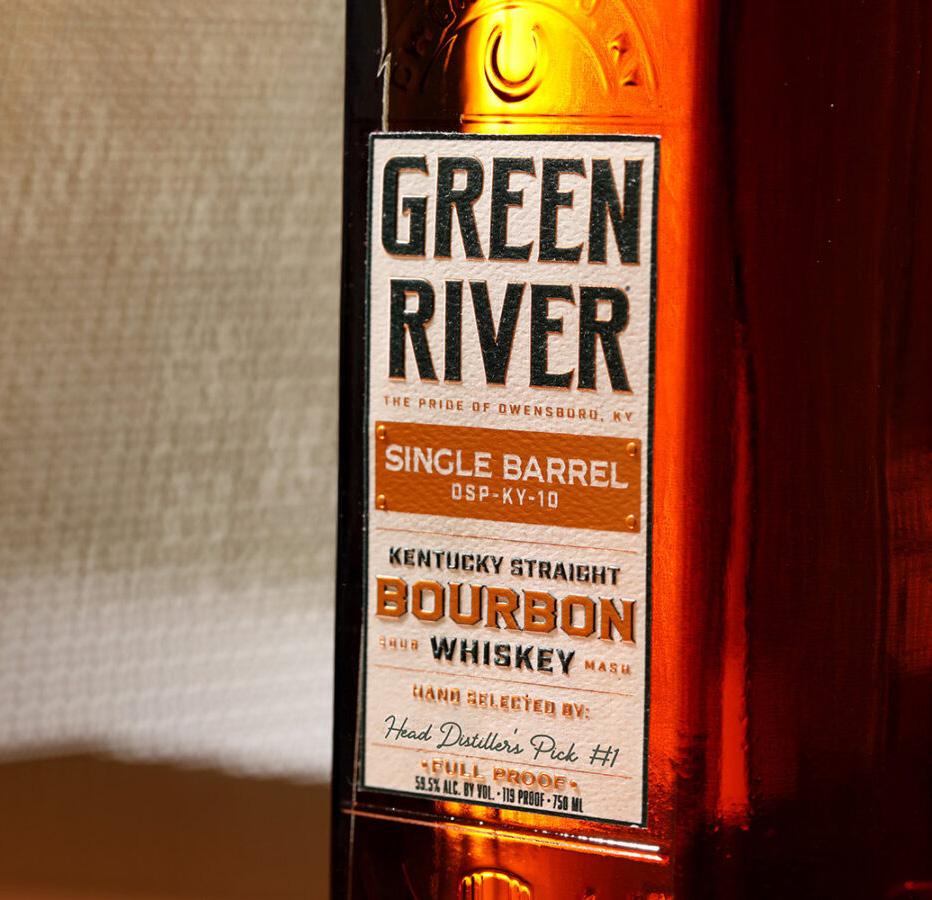
Milam & Greene Whiskey of Blanco, Texas, announced the release of Unabridged Volume 2: A Blend of Straight Bourbon Whiskies, a caskstrength blend that incorporates some of the rarest casks from the distillery’s library. The 117.6-proof spirit is the first release of the Autumn 2023

Blender’s Reserve Collection, a selection of highproof bourbons.
J. Carver Distillery of Waconia, Minnesota, announced the limited release of its 95.2-proof J. Carver
7 Year Brickyard Straight Bourbon Whiskey. As with the recently introduced 7 Year Straight Bourbon Whiskey and 7 Year Runestone Straight Rye, this is a fine whiskey that offers the unique flavors of Minnesota grains and Minnesota barrels with the complexity of a carefully crafted, wellaged whiskey.

14 | SEPTEMBER/OCTOBER 2023 CRAFTSPIRITSMAG.COM New Spirits
An internship program that is a STEP above the rest

Partnering with member distilleries and wholesalers throughout the United States, we provide a comprehensive training program and provide job exposure for those of different races, color, national origins, abilities, genders, and sexual orientations.


LEARN MORE AT
STEPUPINTERNSHIP.ORG
It’s time to STEPUP!
The waffle experts at Eggo and spirit specialists from Sugarlands Distilling Co. are pairing up again to bring brunching up a notch with their latest boozy innovation: Eggo Brunch in a Jar Sippin’ Cream. Inspired by classic brunch flavors, this rich and delicious creamy 40-proof liqueur seamlessly blends the flavors of toasted Eggo waffles, sweet maple syrup and rich butter, with a hint of smoky bacon thanks to the artistry of the experts at Sugarlands.

Memphis, Tennessee-based Old Dominick Distillery is releasing the first stops from the Trolley Stop Series by Huling Station. The Main Street Line will showcase the heat of the high-rye mash bill in the Straight Bourbon Whiskey, while the Madison Avenue Line will demonstrate the sweetness that a Straight Wheat Whiskey has to offer.

Loveland, Colorado-based Root Shoot Malting is excited to announce the release of its first, completely locally resourced spirit. Five years in the making, Root Shoot Spirits’s American Single Malt Whiskey (100 proof) incorporates 100% Colorado-grown and malted grain, sourced from the fifth-generation, family-run Olander Farms and malted by the sustainabilityminded craft maltsters at Root Shoot.

La Crosse, Wisconsinbased La Crosse Distilling Co. is delighted to announce the annual release of Bluffside Apple Brandy to commemorate its five-year anniversary. The 84-proof spirit captures the true essence of the fall season. Locally grown organic apples are harvested and fermented into organic apple cider. The apple cider becomes the base of the brandy. The cider is double distilled and aged three years in oak bourbon barrels.
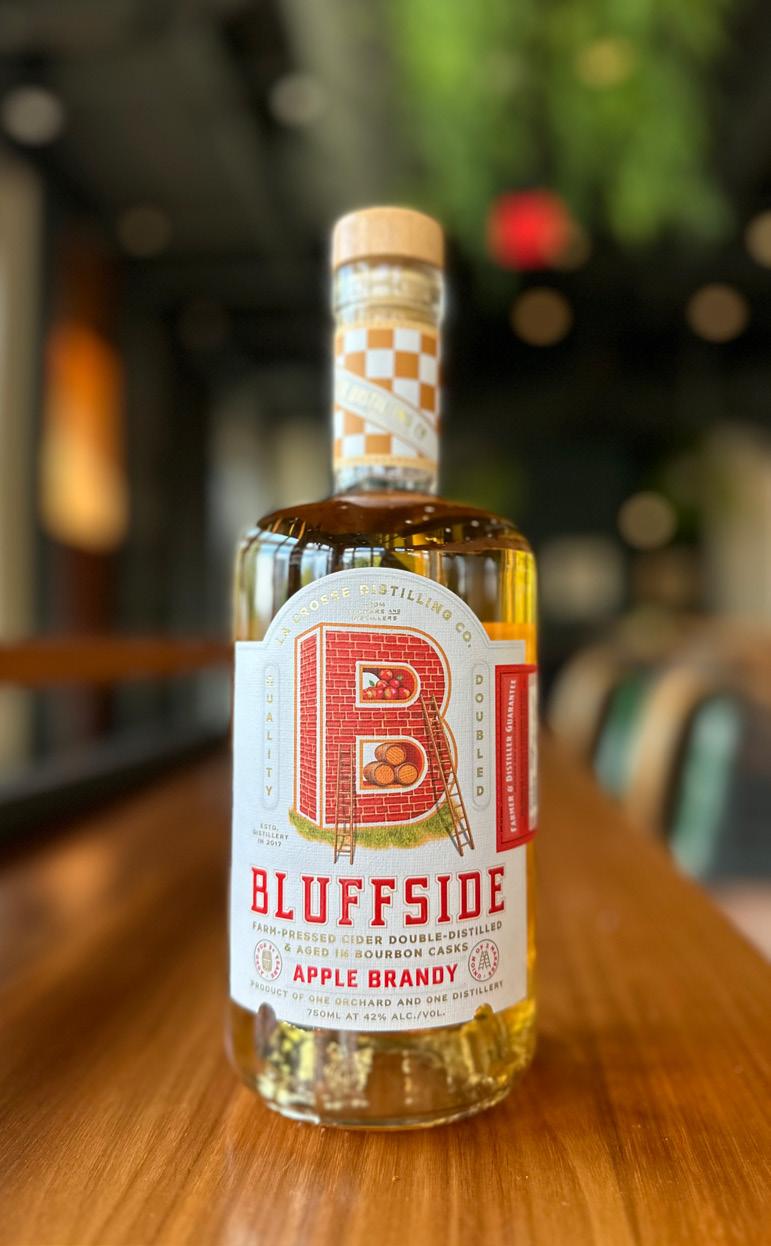
16 | SEPTEMBER/OCTOBER 2023 CRAFTSPIRITSMAG.COM New Spirits
Cardinal Spirits of Bloomington, Indiana, has announced the release of Songbird Spiked Cold Brew, a refreshing canned cocktail starring the distillery’s flagship Songbird Coffee Liqueur. The 8.5% ABV offering joins two wildly growing beverage trends—cold brew and canned cocktails.
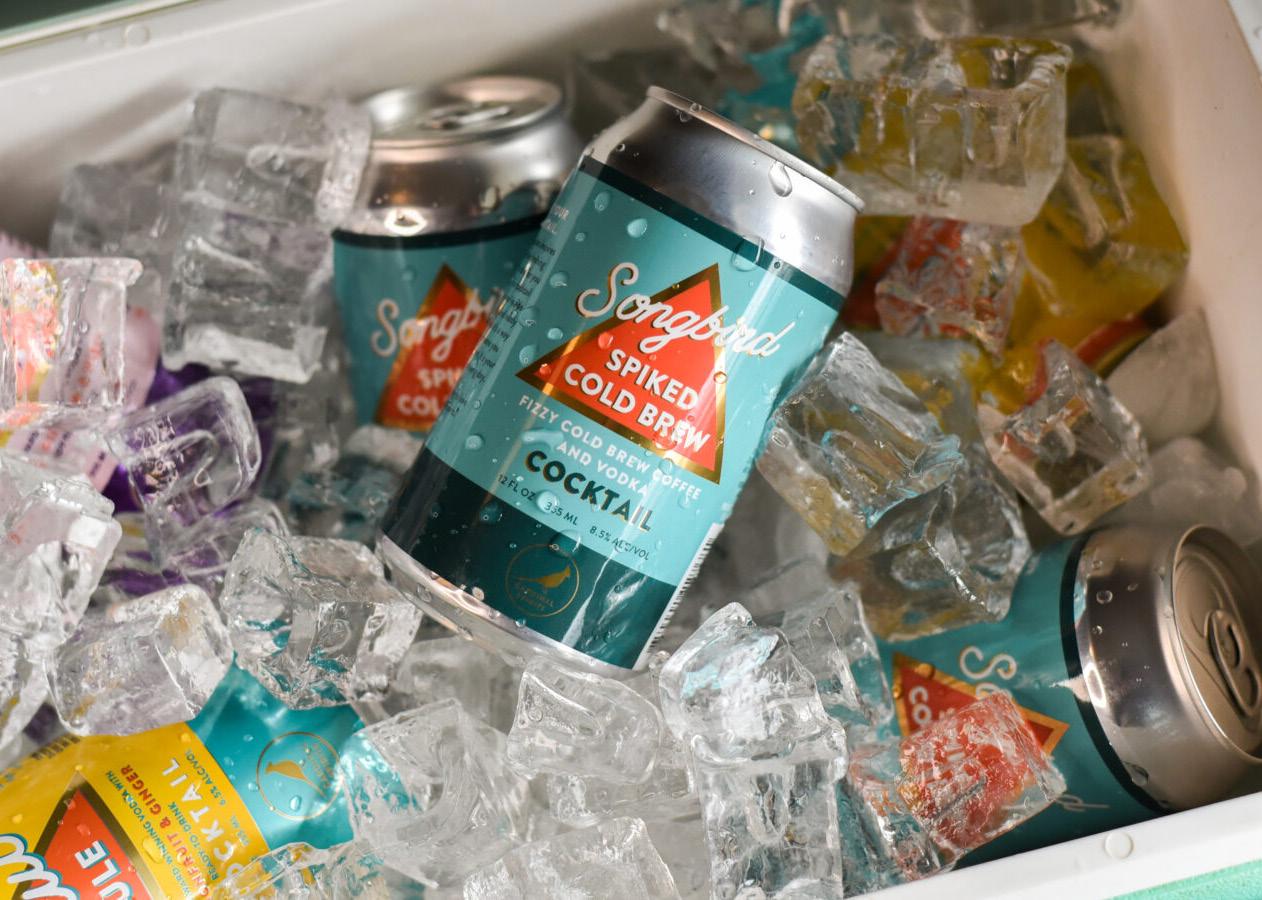
Portland, Oregon-based Westward Whiskey introduced its third club release of the year, Westward x Ken’s Artisan Sourdough Whiskey—2023 Vintage Blend. The 90-proof release marks the whiskey producer’s second edition of Sourdough, a collaboration with James Beard award-winning baker Ken Forkish.
Eugene, Oregon-based Wolf Spirit proudly announced the launch of the 86-proof Mr. Pickles Pacific Northwest Gin. Named for master distiller Ben Green’s pit bull rescue pup, Mr. Pickles is a smooth, premium international style gin that reflects the personality of the distillery’s gregarious mascot and Oregon’s majestic mountains.
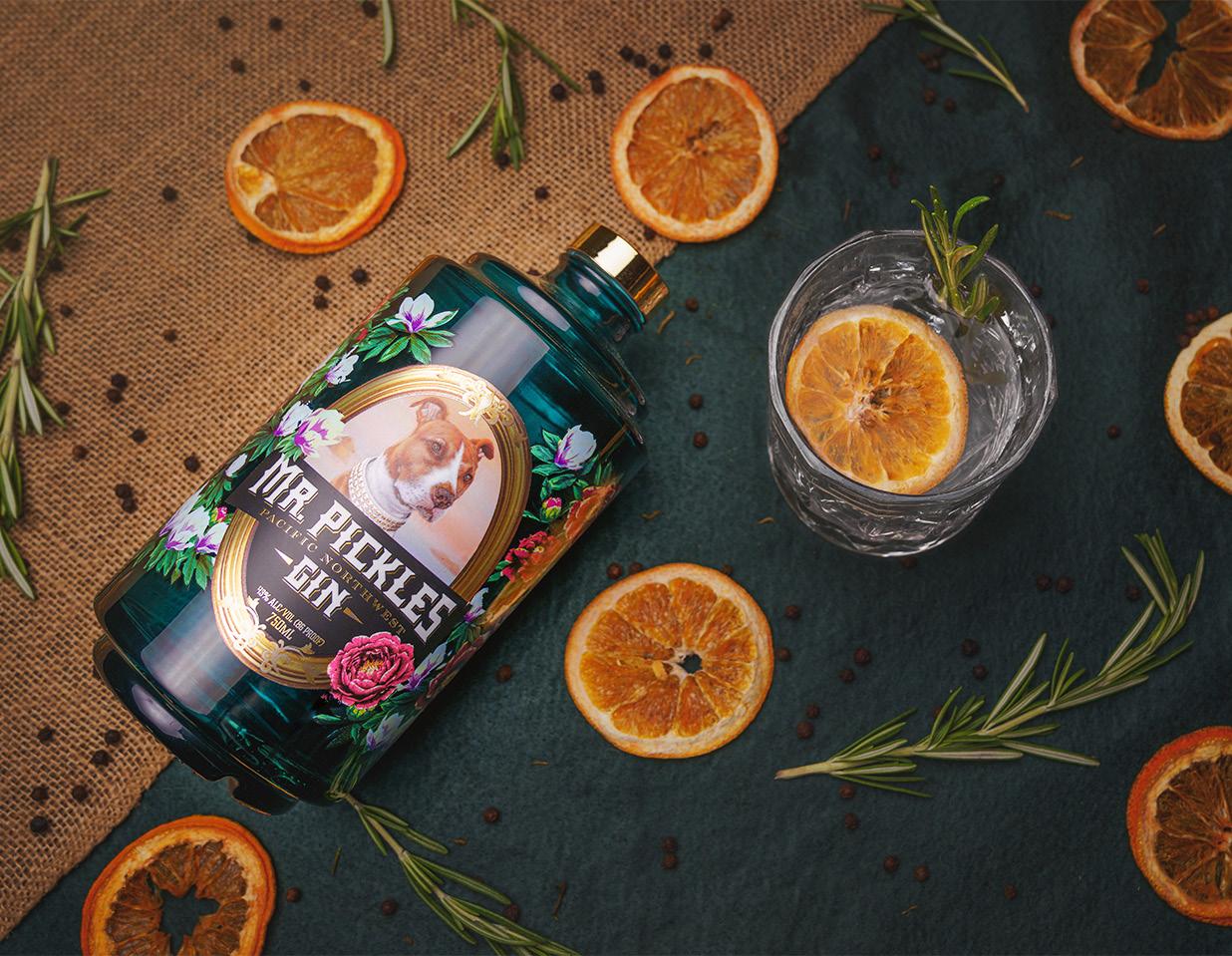
Seattle-based Copperworks Distilling Co. released the 58.8-proof Copperworks Plum Gin, 2022 Harvest, which was crafted from 1,400 pounds of locally grown Italian Prune plums from the 2022 harvest that macerated in Copperworks’ Small Batch Gin for approximately nine months.
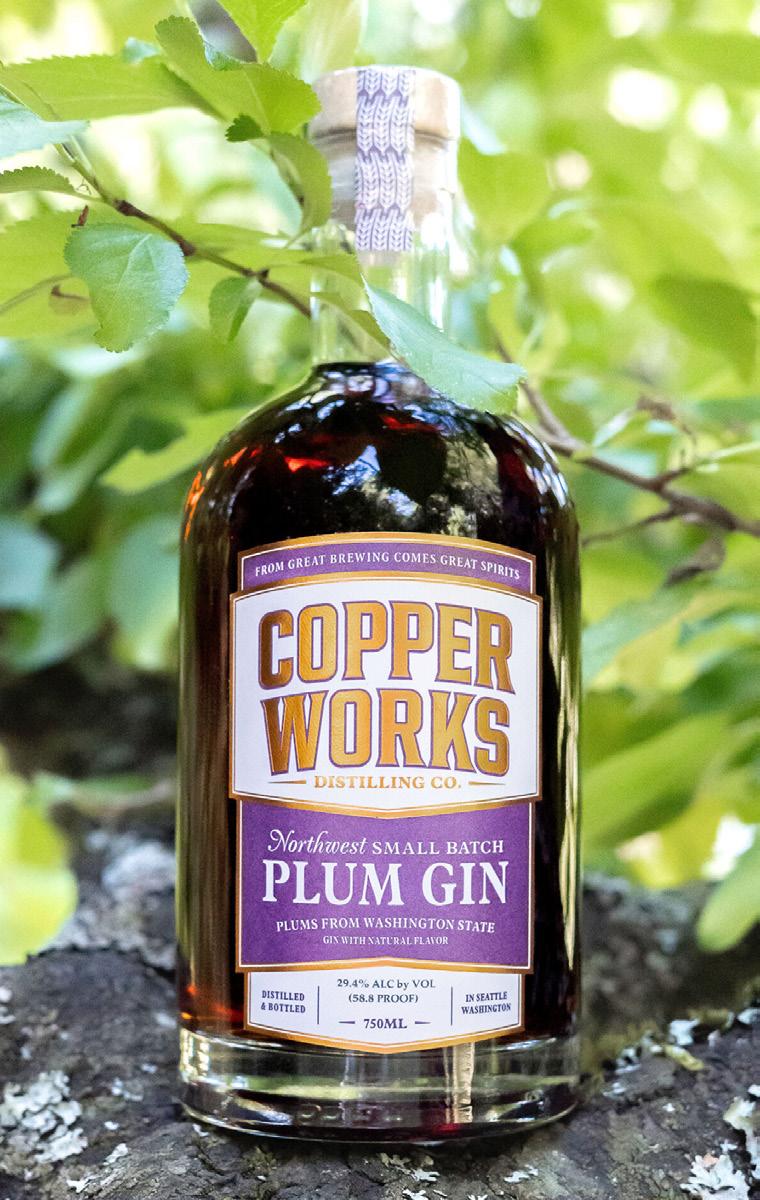

CRAFTSPIRITSMAG.COM SEPTEMBER/OCTOBER 2023 | 17 New Spirits
WOW (WOMEN OF WHISKEY) AWARDS WINNERS HONORED AT BOURBON WOMEN SIPOSIUM
In August, Bourbon Women announce the winners of the inaugural WOW (Women of Whiskey) Awards, presented in collaboration with the Bourbon Women Foundation. The awards were presented at a ceremony during the Bourbon Women SIPosium.
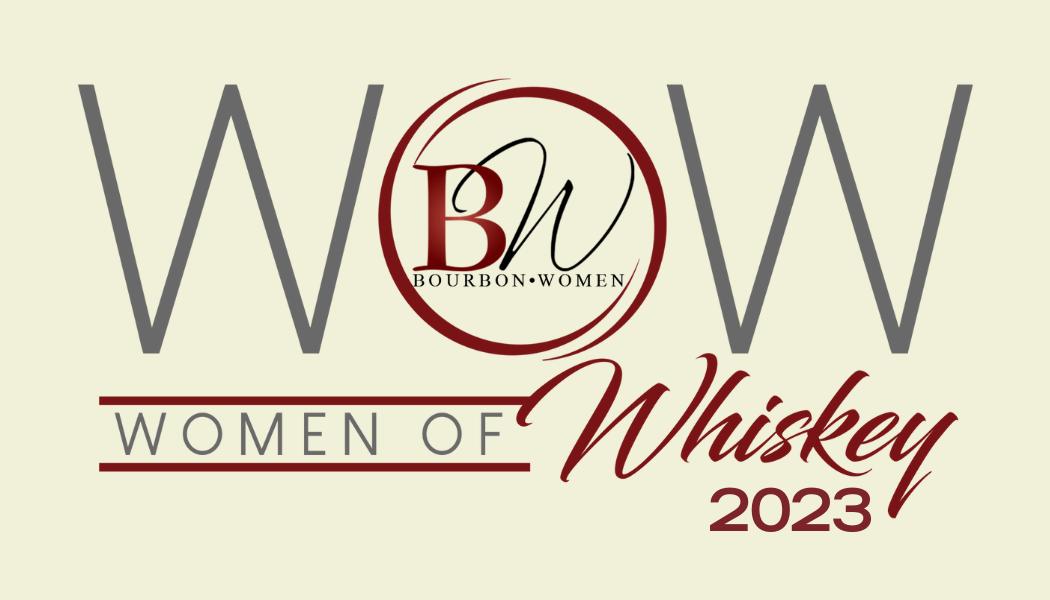
The WOW Awards recognize exceptional women leaders who have made indelible marks in the whiskey industry. As a pioneer in supporting female bourbon enthusiasts, Bourbon Women is the first female whiskey consumer group in the nation and takes immense pride in presenting the WOW Awards, reinforcing a commitment to honoring the achievements of women in spirits.
After a rigorous selection process, Bourbon Women presented the winners of each of the 2023 award categories:
Legacy Achievement Award: Becky Harris (founder, chief distiller, Catoctin Creek Distilling Co.)
Master Distiller/Production Manager of the Year: Alex Castle (master distiller and senior vice president, Old Dominick)
Master Blender of the Year: Heather Greene (master distiller, founder and CEO, Milam & Greene Whiskey)
Brand Ambassador of the Year: Angel Teta (national guardian of advocacy & brand culture, Angel’s Envy)
Woman-Owned Brand of the Year: Heaven Hill Brands
Bartender of the Year: Tiffanie Barriere (The Drinking Coach)
Spirits Influencer/Podcaster of the Year: Sara Ahlgrim (It’s Bourbon Night Spirits Writer of the Year: Pheobe Calver (Editor, American Whiskey Magazine)

Spirits-Diversity Program of the Year: Beam Suntory
Mike Keyes Champion/Ally of the Year: Emma Hutchens (chief of human resources, Heaven Hill Brands)
Finalists were nominated by their companies, their peers, and their communities as they have demonstrated an unwavering commitment to excellence in their craft, making invaluable contributions to the whiskey industry. They embody the essence of innovation and dedication that inspires and uplifts others in the field.
Heather Wibbels, managing director of Bourbon Women, said, “We are absolutely thrilled to celebrate the leadership and change that these individuals are bringing to the whiskey industry and the innovation and passion they share. Collectively, they represent a groundswell of change in the whiskey world and we are proud to uplift and celebrate the phenomenal women who do that work every day”.
During the event, the Kentucky Distillers Association also presented the long-standing Lois Mateus Award Networking Award to
recognize the importance of connection and networking in the industry to Sara Osborne of MML&K Government Solutions.
DISTILLERY TOURISM CONTRIBUTES $3.45 BILLION TO TENNESSEE’S ECONOMY

Distilleries are one of the most significant drivers of tourism and economic growth in Tennessee, according to a recent study by Tourism Economics. The study, commissioned by the Tennessee Whiskey Trail, revealed that distilleries were one of the top-visited tourism attractions in Tennessee and brought in eight million non-local visits and $3.45 billion in economic impact in 2022 alone.
Non-local visitors to distilleries generated an estimated total of $2.05 billion in spending across industries, including lodging, food and beverage, retail, recreation, transportation and more. The over $3 billion in economic impact supported 30,000 jobs in Tennessee and created $441.1 million in tax revenue.
“Visitors from around the world make the pilgrimage each year to explore the time-honored craft of Tennessee Whiskey,” said Mark Ezell, commissioner, Tennessee Department of Tourist Development. “It’s an important driver of tourism, which creates revenue and jobs for all Tennesseans. We are honored to celebrate the industry’s success alongside our partners at the Tennessee Distillers Guild today.”
The Tennessee Whiskey Trail is composed of more than 30 distilleries, spanning the state from Memphis to Bristol, including world-
renowned brands like Jack Daniel’s Distillery, Old Dominick Distillery, Ole Smoky Distillery and more. The Trail was founded by the Tennessee Distillers Guild six years ago to celebrate the variety of tastes and experiences available across the state.
“Though Tennessee has no shortage of attractions, from the centerpiece of country music entertainment to the Smoky Mountains, this study shows that our distilleries are major destinations themselves,” said Charity Toombs, executive director of the Tennessee Distillers Guild, which operates the Tennessee Whiskey Trail. “Tennesseans and visitors alike have a taste for our state’s spirits. We’re proud that the Tennessee Whiskey Trail has become an exponential driver of tourism and economic impact throughout the state, and we hope to continue to grow and bring people back for more.”
18 | SEPTEMBER/OCTOBER 2023 CRAFTSPIRITSMAG.COM Industry Update
WATERSHED DISTILLERY ACQUIRED BY MARUSSIA BEVERAGES USA
Watershed Distillery and Marussia Beverages USA, a producer and importer of premium craft spirits and wines, announced in early August that Marussia Beverages USA has acquired Watershed Distillery, making the Columbus, Ohio-based maker of award-winning bourbons, gins, vodka and specialty spirits a valuable part of the group’s focused and premium portfolio.
Watershed Distillery was founded in Columbus in 2010 by two
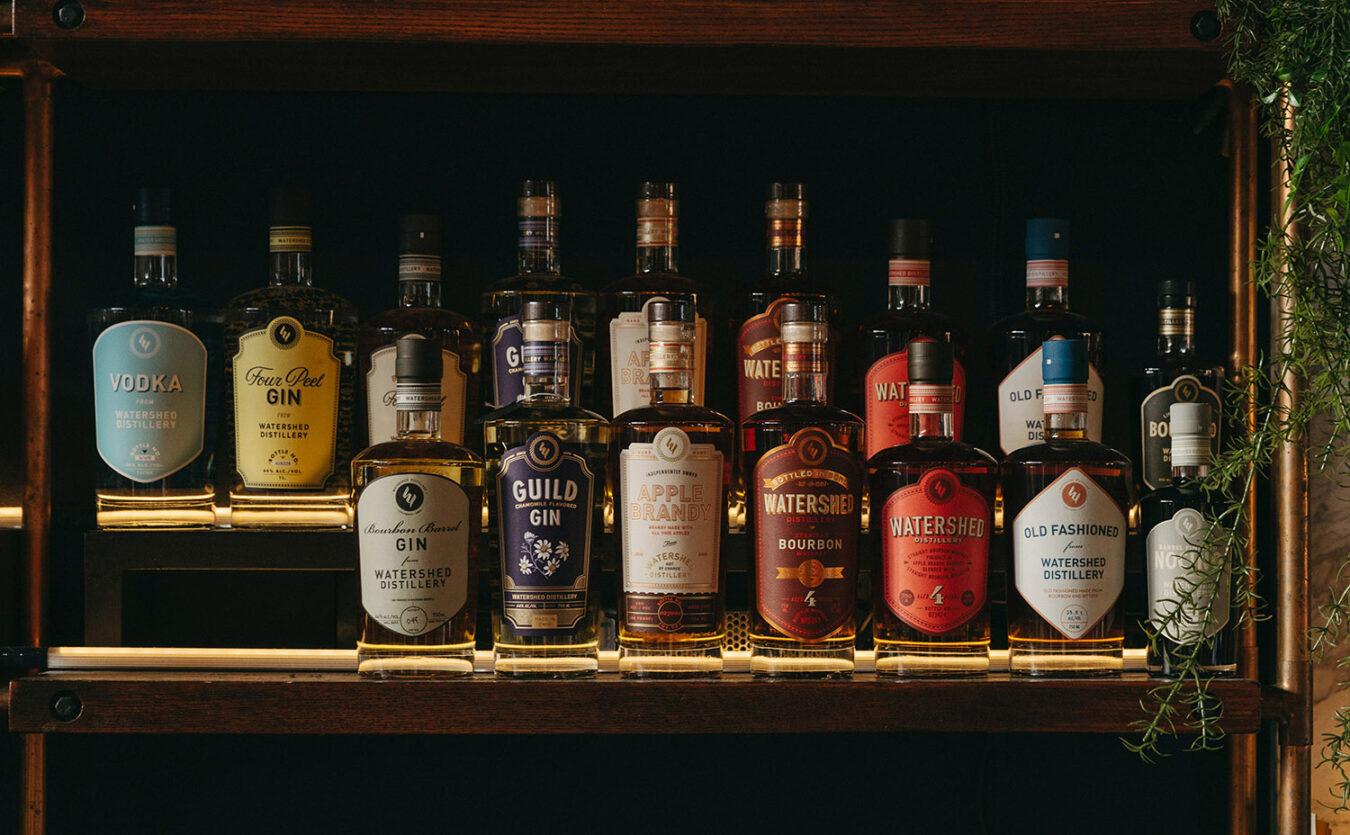
ambitious friends and has become the producer of the number-oneselling Ohio-made bourbon and gin portfolios. During the last 13 years, the brand has become a renowned producer in the craft spirits world with a primary focus on growing its home market of Ohio, while adding distribution in six other states. Greg Lehman, Watershed’s founder, will continue to oversee all operations. All production will remain in Columbus with expansion in Central Ohio expected. Watershed Kitchen + Bar will continue to be a place for the community to gather.
“In Marussia Beverages we see the same entrepreneurial spirit that has driven our growth here at Watershed Distillery,” said Lehman. “Working with John Horn and the executive team at Marussia has been energizing and exciting. As we plan to grow our footprint here in Central Ohio and throughout the country, we see potential opportunities for our current team, future employees, and the Columbus region.”
John Horn, CEO of Marussia Beverages USA, added, “Watershed Distillery embodies the same core values and DNA that are at the heart of Marussia Beverages. It starts with family, community, entrepreneurship, a passion for exploration and discovery, and the desire to connect with consumers to deliver high quality, premium brands. Built with these same values, Greg and his incredible team have done and will continue to do amazing things, and in concert with our great team, will build upon these values in Ohio and beyond.”
Financial terms of the acquisition were undisclosed.
BLACK BUTTON OPENS NEW, EXPANDED TASTING ROOM AND DISTILLERY
Black Button Distilling, the first grain-to-glass craft spirits producer in Rochester, New York, since Prohibition, announced the grand opening of a new, expanded tasting room and distillery.
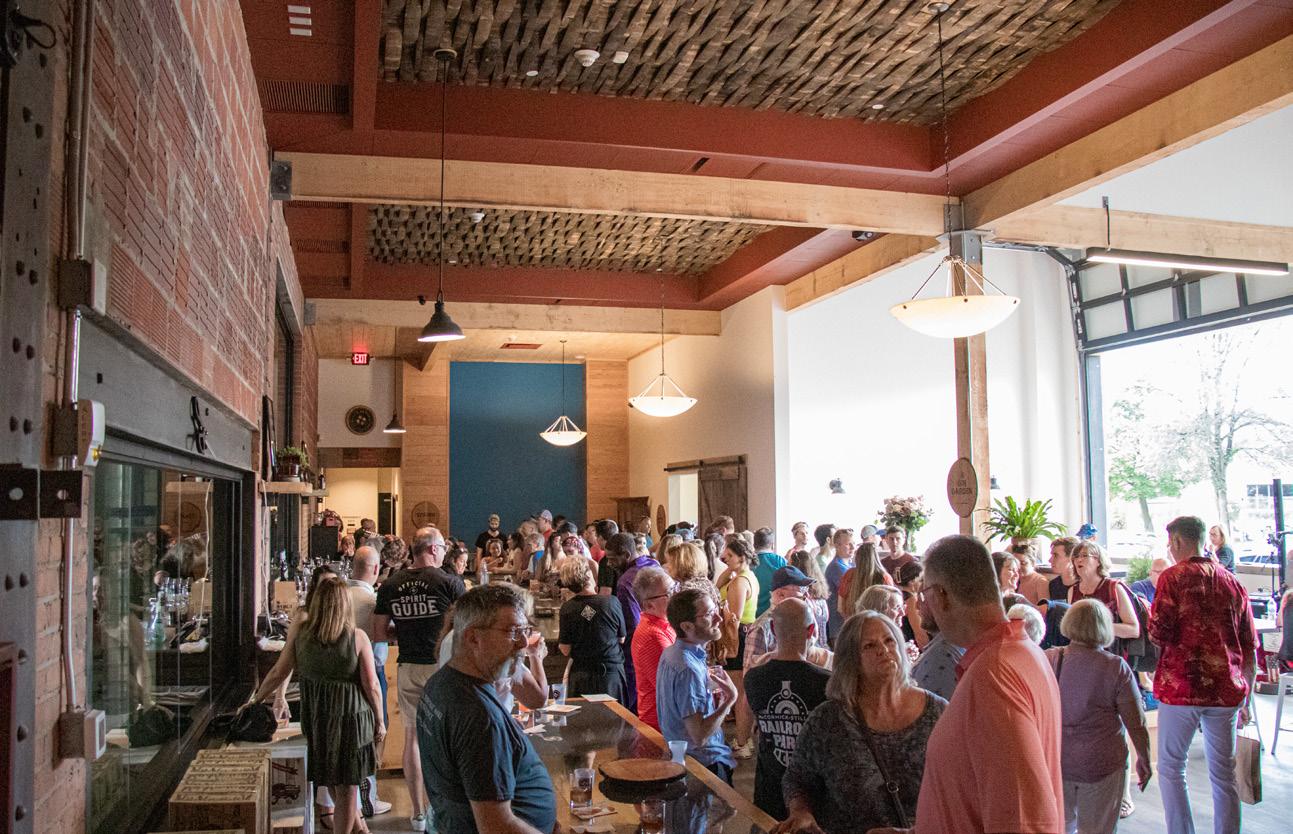
At 28,000 square feet, the new distillery and tasting room is quadruple the size of the distillery’s former location. Black Button’s average annual spirits production will increase from 1,000 barrels of spirits per year to as much as 4,500 barrels in the first few years. The tasting room’s retail space has grown to 4,500 square feet, allowing for significantly increased seating capacity, private event space, distillery events and expanded hours of operation for the public. The distillery anticipates adding 10- 20 jobs to the company within the first year, and up to 50 jobs in the years to come.
“We have come such a long way in just 10 short years,” says Jason Barrett, Black Button Distilling founder/master distiller. “From navigating the challenges of growing a capital-intensive business in a competitive marketplace to overcoming regulatory hurdles to surviving and thriving during the pandemic, we’re perfectly poised for the future. Our new facility makes us the largest bourbon producer in New York State and our award-winning brands are getting greater recognition outside of our hometown footprint. We’re committed to elevating the profile of New York State as a competitive, high-quality producer of fine whiskeys in the years to come.”
To coincide with the grand opening, Black Button Distilling released its oldest straight bourbon whiskey to date. Aged for just over
eight years, there are only 170 bottles of this 125 proof Single Barrel Straight. It features rich chocolate, brown butter and cinnamon with dry oak on the nose. The palate is very spicy, almost effervescent cherry cola, with thick molasses and cookie sweetness, and a long spicy finish with leather.
CRAFTSPIRITSMAG.COM SEPTEMBER/OCTOBER 2023 | 19
Industry Update
SOUTHERN DISTILLING CO. ANNOUNCES PARTNERSHIP WITH CAROLINA PANTHERS
Southern Distilling Co. of Statesville, North Carolina, has announced a multiyear partnership agreement with the Carolina Panthers. The makers of Southern Star bourbons and Hunting Creek rye, Southern Distilling Co. is now an official partner of the Charlotte-based NFL team.
“I grew up here in North Carolina and I’m proud to call it home,” said co-founder and CEO Pete Barger. “Supporting the Panthers is something I’ve been doing for a long time and I’m looking forward to raising a glass of Southern Star while singing along to ‘Sweet Caroline’ after what I hope will be many wins this season!”
Fans will be able to enjoy Southern Star products while attending games at Bank of America Stadium. The partnership will extend beyond the field, too, with signature Panthers-themed cocktails served at bars and restaurants across the Carolinas. The distillery will also serve signature cocktails at its on-site cocktail bar and plans to host watch parties for select games throughout the season.
Barger encouraged fans to share their spirit of the Carolinas by tagging Southern Distilling Co. on social media to share what Southern Star products they’re sipping.
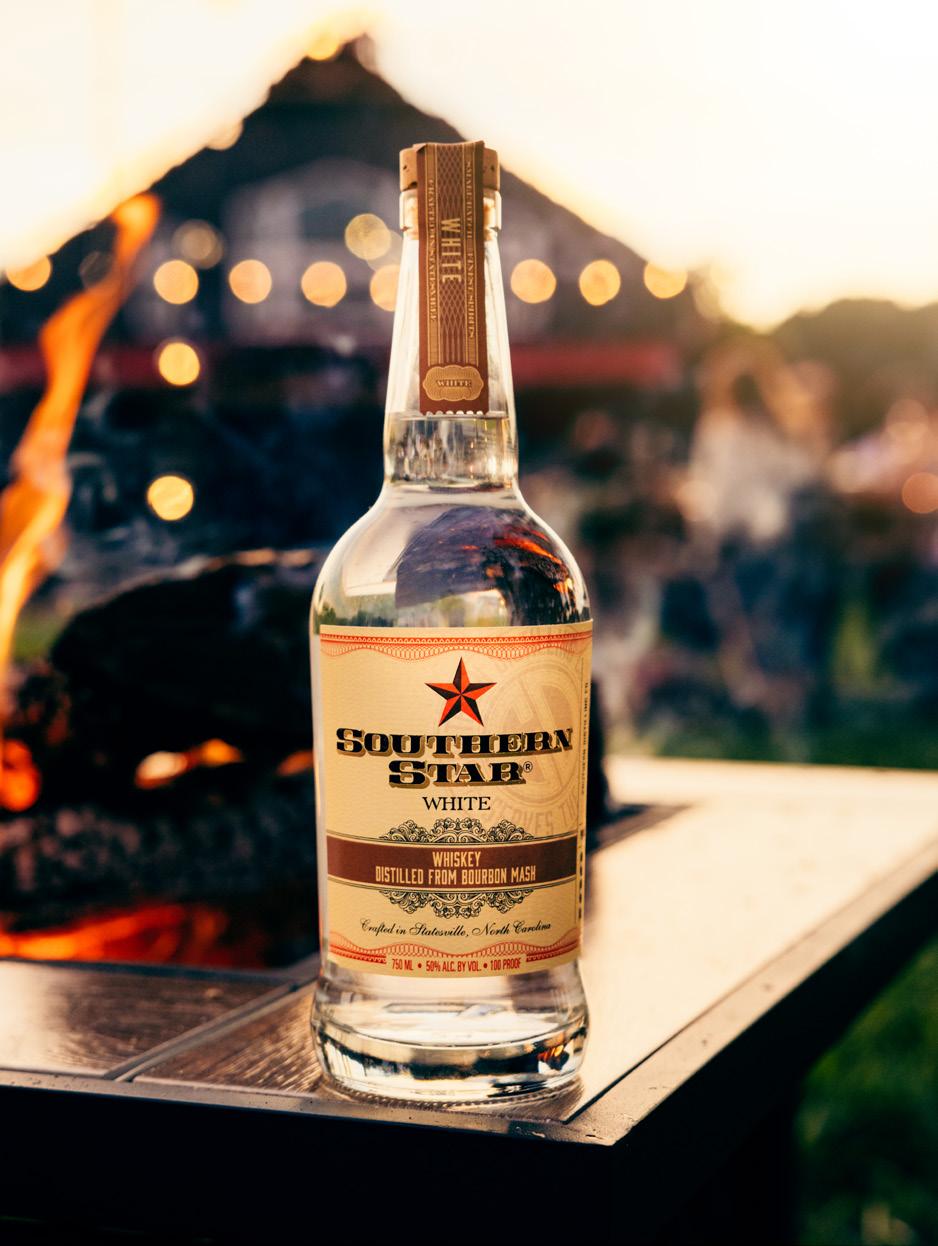
Southern Distilling Co. produces award-winning spirits including Southern Star Paragon Wheated Straight Bourbon Whiskey, Southern Star Standard High-Rye Bourbon Whiskey, Southern Star Double Rye Whiskey, and Southern Star Double Shot Bourbon Cream Liqueur, and Hunting Creek Bottled-in-Bond Straight Rye Whiskey, among others. They’re available in North Carolina, South Carolina, and more than a dozen other markets across the U.S. The distillery is open for tours, tastings, craft cocktails, and bottle sales seven days a week.
BerlinPackaging.com
1.800.2.BERLIN
Your Trusted Premier Spirits Packaging Supplier
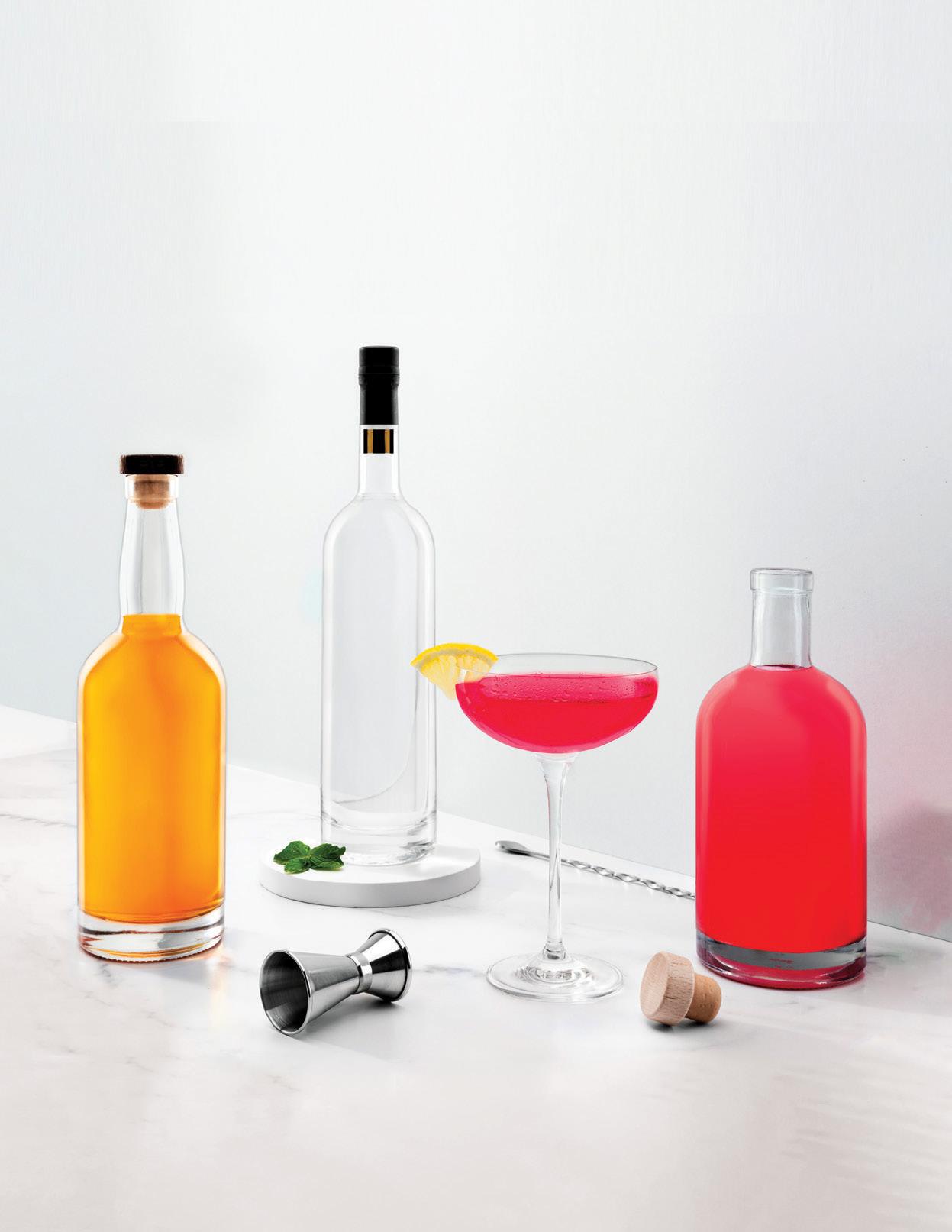
Berlin Packaging is the world's largest Hybrid Packaging Supplier® providing cost-effective packaging options for customers of all sizes. And our global sourcing, warehousing services, sustainability solutions, and quality advocacy help you Package More Profit®
• Glass & Plastic Bottles
• Aluminum Cans
• Closures & Stoppers
• Neck Bands & Wraps
• Secondary Packaging
• Decorating
Industry Update
20 | SEPTEMBER/OCTOBER 2023 CRAFTSPIRITSMAG.COM
OXBOW RUM DISTILLERY NAMED OFFICIAL RUM OF LSU ATHLETICS

Baton Rouge, Louisiana-based Oxbow Rum Distillery announced its new partnership as the official rum of LSU Athletics. This collaboration symbolizes a union of tradition, dedication and local pride between the two Baton Rouge establishments.
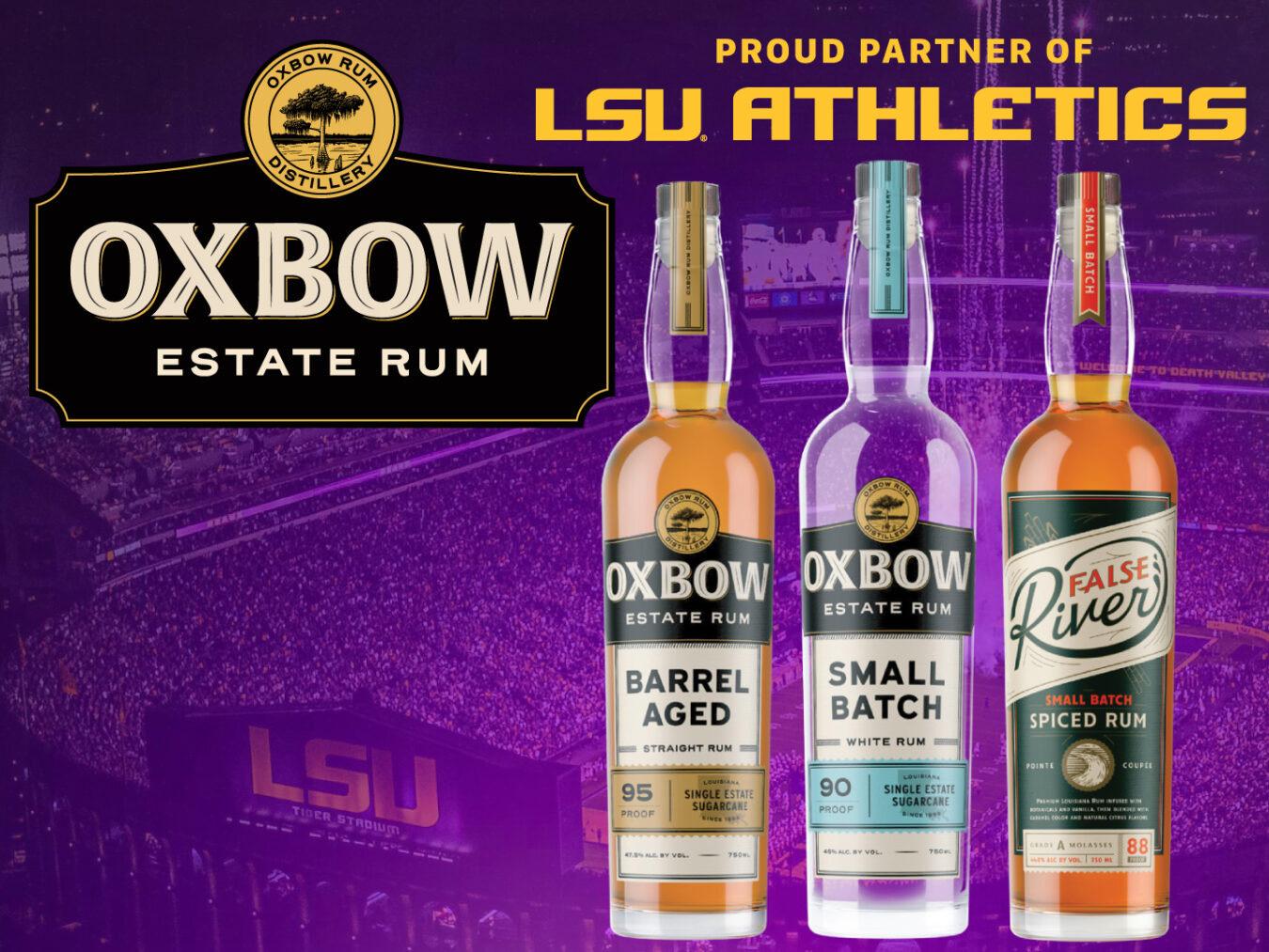
Oxbow is deeply committed to elevating the essence of Louisiana rum by creating products that are rooted in their rich land, heritage, and premium craftsmanship. This commitment to excellence has been nurtured through five generations of sugarcane cultivation and sugar production in Pointe Coupée Parish. The family is dedicated to ensuring that every drop of Oxbow Rum is an expression of the land and people that made it, from cane to glass.
“Our connection with the community is deep-rooted, and our mission of creating something authentically Louisiana is evident in every sip,” said Olivia Stewart of Oxbow Rum. “From the handplanted sugarcane on our family estate, to the meticulously crafted rum in your glass, Oxbow’s story is a tapestry of Louisiana’s legacy and spirit.”
Fans attending home LSU football, baseball and basketball games will have the opportunity to enjoy three of Oxbow’s meticulously crafted rums: Oxbow Small Batch White Rum, Oxbow Barrel Aged Straight Rum and the much-celebrated False River Spiced Rum.


“We are immensely proud to join hands with LSU Athletics, an institution synonymous with excellence and community pride,” Stewart reflected. “Having grown up on the cane farm just 20 miles from LSU’s campus, we couldn’t have asked for a more perfect union. As we em-
GRAIN, HANDLED.




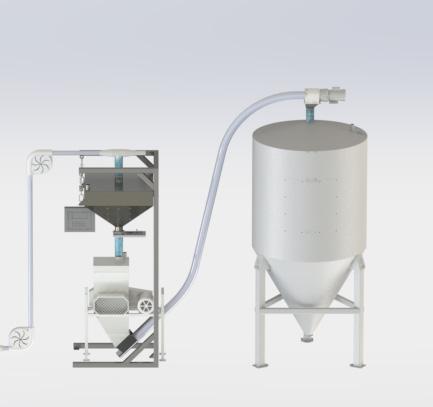


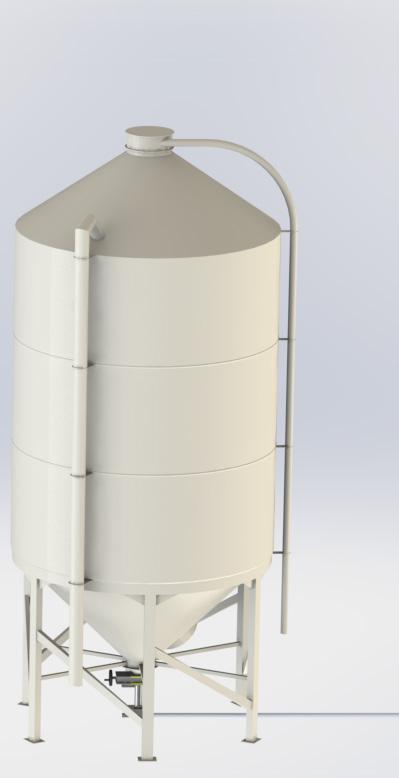
CRAFTSPIRITSMAG.COM SEPTEMBER/OCTOBER 2023 | 21 Industry Update
SYSTEM DESIGN & INTEGRATION FROM SILO TO SPENT GRAIN abmbrewery.com 360.558.7156
bark on this journey together, we invite all to celebrate this partnership with a toast—here’s to legacy, sportsmanship, and new beginnings. Geaux Tigers!”
HIGHLINE SPIRITS LAUNCHES WITH FOUR RELEASES
A new spirits brand and four inaugural offerings have entered the market under the name of Highline Spirits. At the helm of the Dexter, Michigan-based operation is CEO and founder Christi Lower, a former pediatric surgery PA, mother of four and whiskey enthusiast.
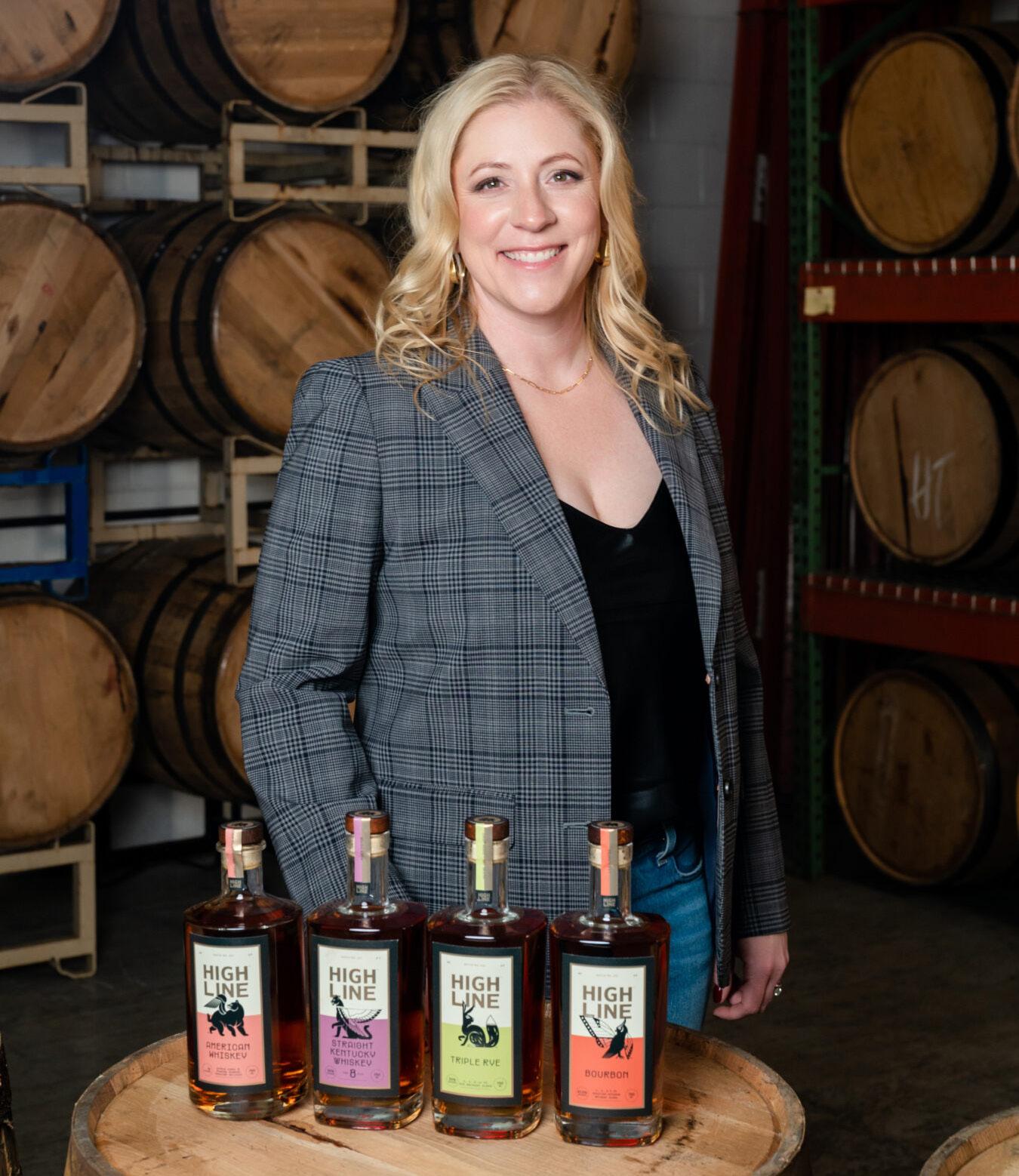


Lower believes that the convergence of different cultures and crafts creates something greater than the sum of its parts. She envisioned a transformative spirits company untethered by tradition, history, orientation, gender or beliefs. Tired of the sea of sameness in the category, Lower created Highline Spirits: focused on sourcing, blending, batching and special-finishing super-premium and ultra-premium small-batch spirits completely unique unto themselves.
“As I started learning about the industry over 10 years ago, I was fascinated with the evolution of a spirit based on weather, terroir, wood, grain,and yeast,” said Lower. “Yet I was also struck by how myopic the final distillate landing in the bottle could be. Most whiskey on the shelf is controlled by a very small group of people, marketing to an American consumer who no longer looks as it did when the industry started. Our culture is evolving. Our spirits should also be evolving with different personalities, perspectives and practices to reflect that growth and dimension.”
Lower has hired Kate Keister, Highline Spirits warehouse and production manager and proud member of the LGBTQ+ community with eight years of warehouse and supply chain management experience. Kate Arbour also joins the team as the company’s director of operations, who brings over 20 years of global hospitality and project management experience. Lower has also assembled a world-class advisory board of spirits industry experts bringing decades of experience in support of Highline’s mission, its products and ongoing operations.
22 | SEPTEMBER/OCTOBER 2023 CRAFTSPIRITSMAG.COM Industry Update clearsourceus.com sales@clearsourceus.com | 585.798.6695 Medina, New York ClearSource is a premier supplier of high-purity alcohol products specializing in grain neutral spirits made from New York corn. Distilled 7X through nearly 600 feet of distillation, our world-class distillation system produces alcohol products that contain virtually no impurities and no detectable organoleptic characteristics. Contact us today for a sample. The Clear Choice for Your Grain Neutral Spirit Needs
MOUNTAIN STATE SPIRITS WINS BEST OF SHOW AT HONEY SPIRITS COMPETITION
A bright and floral liqueur with hazelnut honey and single barrel bourbon won Best of Show honors at the National Honey Board’s Honey Spirits Competition. Handmade in Bristol, West Virginia, by Mountain State Spirits, Hazelnut Honey Bourbon Ratafia bested more than 50 entrants in the competition that recognizes the best spirits in the United States that use honey either as a sweetener, flavor or distillate.
This year’s competition featured seven gold medal winners in addition to 25 spirits that took home silver and bronze medals. An expert panel of judges evaluated the entries on their appearance, nose, palate and the role honey played in the spirit. Gold and silver medals were also awarded in a design/ packaging category.
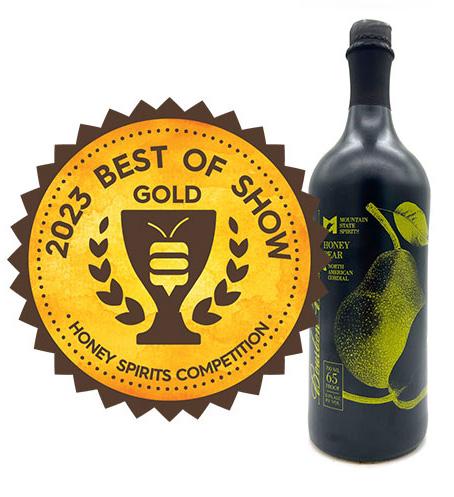
“This year’s competition showcased how far the use of honey has come in the spirits category,” says Catherine Barry, National Honey Board’s vice president of marketing. “Most of the spirits used honey to create a more complex product, adding aromatics, depth and mouthfeel, in addition to flavor.”
The gold medal winners of the 2023 Honey Spirits Competition:
Best of Show, Liqueurs/Specialty Spirits: Honey Pear Bourbon Ratafia, Mountain State Spirits, Bristol, West Virginia

Vodka: Vodka, Denmark Distilling, Denmark, Wisconsin
Rum: Denver Distillery Navy Strength Spiced Rum, Denver Distillery, Denver, Colorado
Bourbon/Whiskey: Honey Whiskey with Natural Flavor, Manatawny Still Works, Pottstown, Pennsylvania
Honey Liqueurs/Specialty Spirits: Cold Brew Coffee Liqueur, Honey House Distillery, Durango, Colorado
Honey Liqueurs/Specialty Spirits: Honey Pear Bourbon Ratafia, Mountain State Spirits, Bristol, West Virginia Spirits Distilled From Honey: Distillers Reserve, Big Island Distillers Inc./DBA 12th Hawaii Distiller, Kailua Kona, Hawaii Packaging/Design, Vodka: Maid of the Meadow, Denning’s Point Distillery, Beacon, New York
For a full list of winners, more information and pictures, please go to honeyspiritscompetition.com



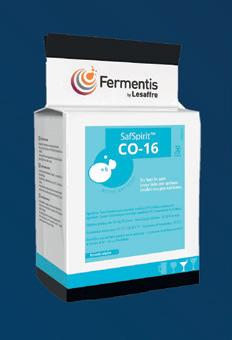



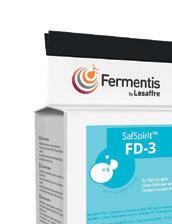
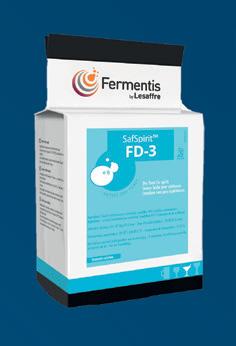
CRAFTSPIRITSMAG.COM SEPTEMBER/OCTOBER 2023 | 23 Industry Update
SafSpirit ™ THE OBVIOUS CHOICE FOR FRUIT BRANDIES SafSpirit FD-3 CALVADOS, PEARS AND BRANDIES SafSpirit CO-16 INTENSE FRUITY AND FLORAL AROMAS ™ ™ More details? visit our app or Fermentis.com
LAWRENCEBURG BOURBON CO. UNVEILS NEW DISTILLERY PROJECT

Lawrenceburg, Kentucky-based Lawrenceburg Bourbon Co. has announced a multi-million-dollar distillery project in Anderson County, Kentucky. The Lawrenceburg distillery is the first new whiskey operation in Anderson County since 1949 and the first craft distillery in the county.




Spanning three acres, the Lawrenceburg Bourbon Co. campus will be an immersive experience. The buildout includes a distillery, tasting room, gift shop, tours, private barrel room and bourbon bar, designed to be approachable and informative.
Remodeling of the existing structure will commence immediately, with a temporary tasting room and gift shop opening early October.
Lawrenceburg Bourbon Co. is proudly veteran-owned. Founders, Greg and Katie Keeley carry the core Navy values of service, honor, and commitment into distillery operations. The distillery is committed to ensuring 50% of its team are veterans—military, first responders, nurses and law enforcement.
Lawrenceburg Bourbon Co. has garnered a reputation for single barrel, cask strength spirits of uncommon character. The lineup includes the flagship, One Cask Bourbon, Very Small Batch Bourbon and Ten x Ten, a 100% small batch rye expression. The Empirical Series will launch this fall featuring High Wheat Rye.
“We are thrilled to unveil our new distillery,” says Greg. “This is more than a physical expansion—it’s a realization of the American dream. That an immigrant can serve his new country on the battlefield and then create a distillery, could only happen in this country. It is genuinely remarkable.”
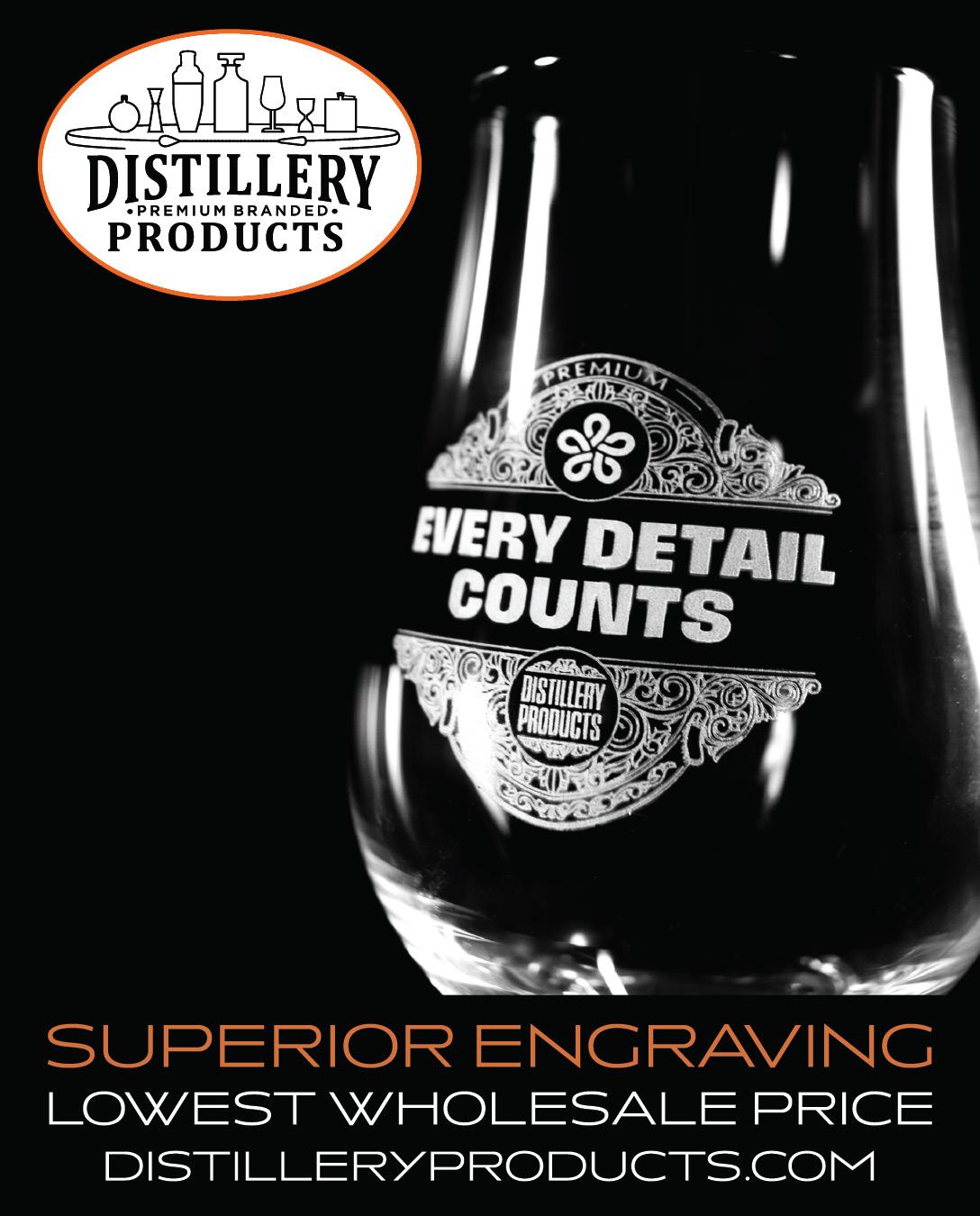
24 | SEPTEMBER/OCTOBER 2023 CRAFTSPIRITSMAG.COM Industry Update
HERITAGE DISTILLING AND TONTO APACHE TRIBE TO DEVELOP DISTILLERY IN ARIZONA
Heritage Distilling Co. of Gig Harbor, Washington, announced a partnership with the Tonto Apache Tribe to develop a spirits distillery and tasting room adjacent to Mazatzal Hotel & Casino in Payson, Arizona. The distillery will produce and serve both Heritage’s portfolio of award-winning spirits, as well as exclusive Tonto Apache-created brands, crafted to reflect tribal flavors and the local region.
Co-founded by Justin and Jennifer Stiefel in 2011, Heritage is recognized for its innovative brand family of premium whiskies, gins, vodkas, rums and ready-to-drink cocktails. Beyond their mastery of distilling and blending, the co-founders saw both an injustice done to Native American indigenous communities and a mutually beneficial economic opportunity to create national distribution for Heritage’s portfolio of award-winning, craft spirits. Together, they created the Tribal Beverage Network (TBN), a first-of-its kind partnership with Native American Tribes to develop Heritage-branded distilleries, brands, and tasting rooms to serve patrons of tribal
casinos and entertainment venues.
“We have spent considerable time with the team from Heritage and we have toured their facilities in the Pacific Northwest. After seeing them help to change the federal law to make this a legal activity for Tribes across the U.S., we are excited to open a tribally-owned distillery in partnership with them harnessing their experience, expertise and top-level reputation in the craft spirits space,” said Tribal Chairman Caivin Johnson. “We will be the first Heritage Distilling location in the Southwest and we are excited to offer this new amenity to our current patrons and the next generation of patrons we know are coming to the Mazatzal Hotel & Casino and to our new Apache Corners development.”
Heritage’s industry-leading operations are derived from their two distilleries and five tasting rooms across Washington and Oregon, along with their brand location in partnership with the Chehalis Indian Tribe in Rochester, Washington, at its Talking Cedar facility. As a TBN partner, the Tonto Apacheowned and operated destination will also offer
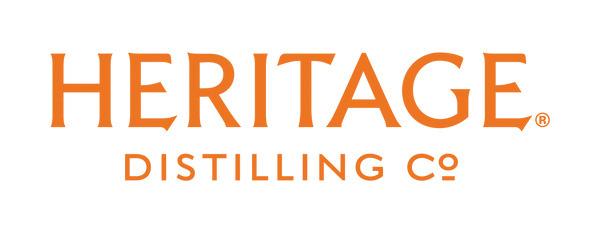
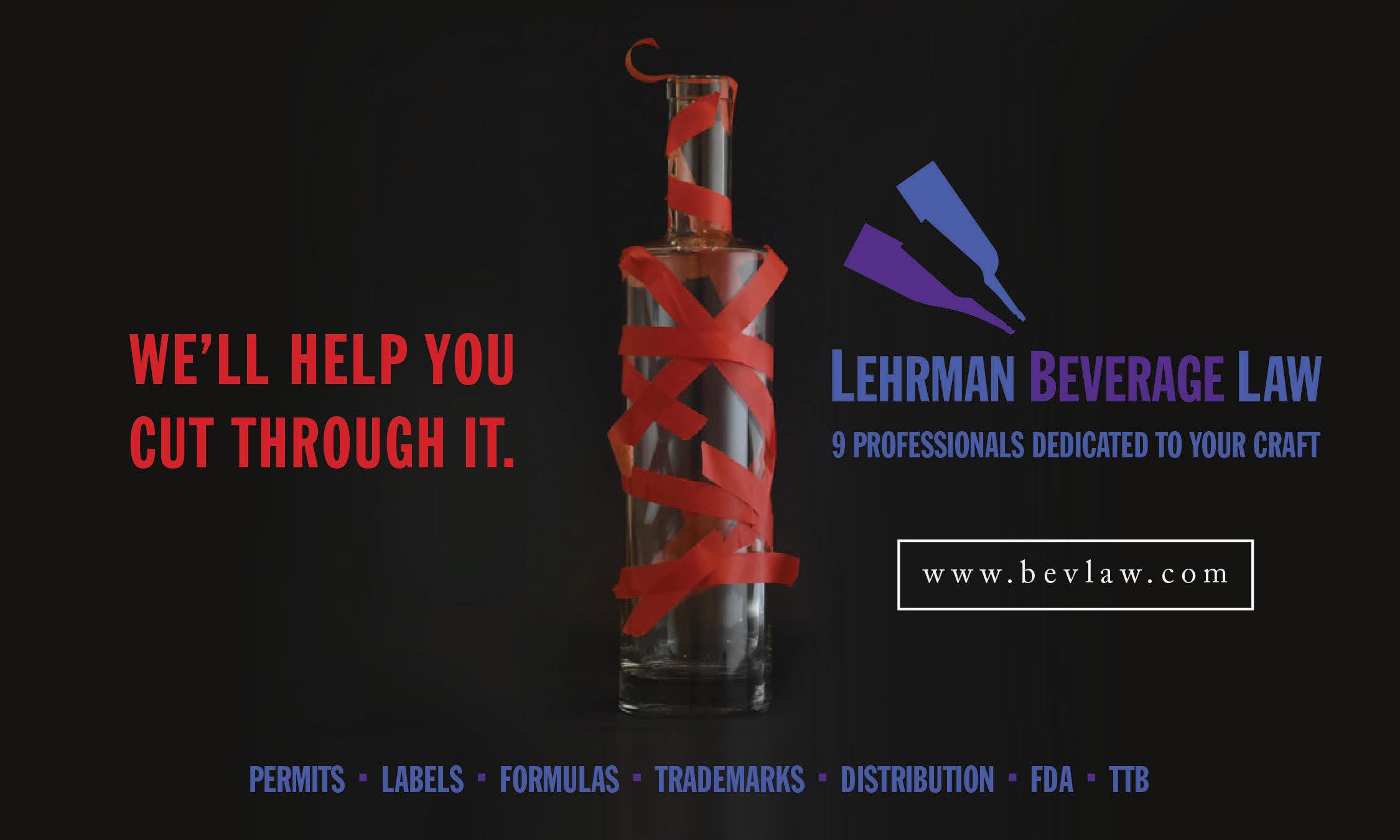
several amenities for patrons including a Tasting Room that features Heritage spirits like Cocoa Bomb Chocolate Whiskey, Heritage Canned Cocktails, Florescence Vodka (a partnership with celebrity Chef Danielle Kartes & Rustic Joyful Food), Stiefel’s Select Single Barrel and Small Batch whiskeys, and Special Forces Whiskey, among others.
In addition to on-site tastings, the Tonto Apache distillery will also extend HDC’s innovative membership programs available to TBN partners: The Cask Club, an annual membership-based program that allows members to create and customize spirits of their choice; and The Spirits Club, a program that provides members quarterly shipments of Heritage’s award- winning spirits delivered directly to their door at a reduced rate, as well as priority access to new, limited, and seasonal releases.
CRAFTSPIRITSMAG.COM SEPTEMBER/OCTOBER 2023 | 25 Industry Update
KOLOA RUM CO. RAISED OVER $44K IN MAUI WILDFIRE RELIEF SALES BENEFITING MAUI STRONG

On Aug. 26, Koloa Rum Co. of Kalaheo, Kauai, Hawaii, hosted an online and in-store event to support Maui ohana impacted by the devastating wildfires, where 100% of proceeds go to the local nonprofit organization, Maui Strong. Koloa Rum, the premium craft rum distiller on Kauai known as The Spirit of Aloha, raised a grand total of $44,106 in in-store and online sales of rum, island-inspired merchandise, ruminfused foods and more.

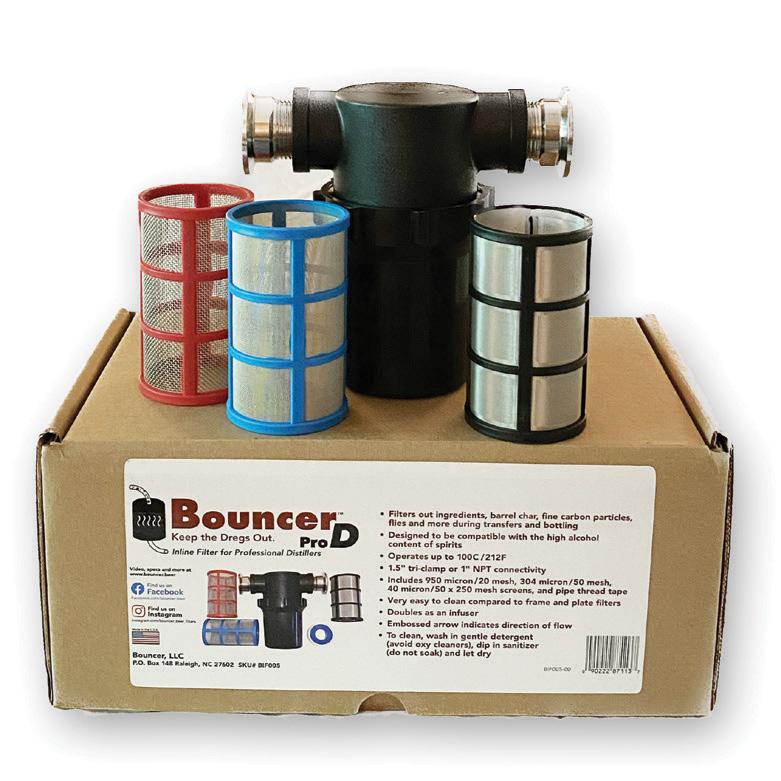
“We are overwhelmed by the outcome of the event and for the support of our loyal fans, who participated in our goal of giving back to our fellow island neighbors,” said Bob Gunter, president and CEO of Koloa Rum Co.. “Raising over $44,000 in sales exceeded our initial expectations, and we’re grateful we’re able to donate 100% of those proceeds to Maui Strong, in their commitment to helping the Lahaina community.”
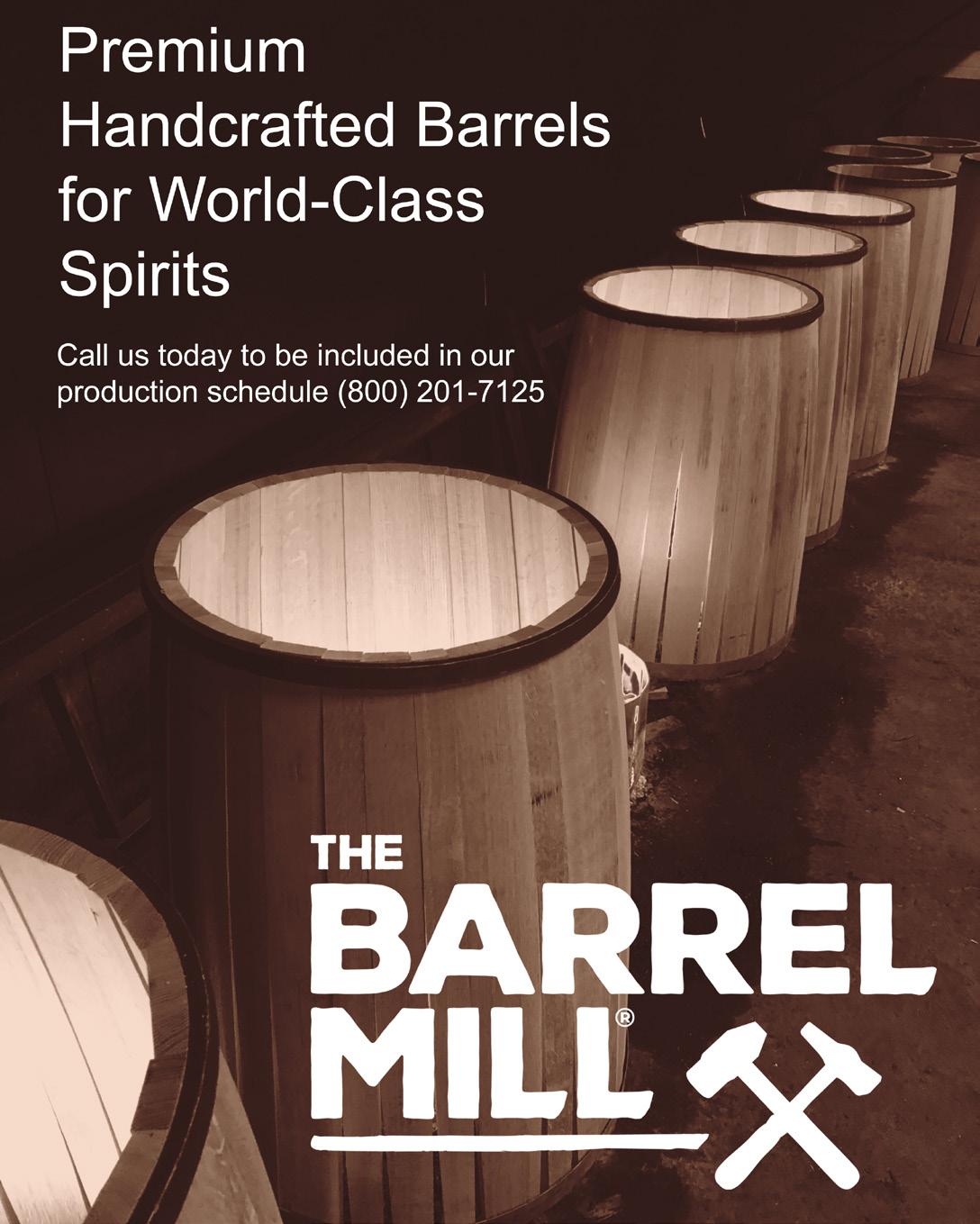
26 | SEPTEMBER/OCTOBER 2023 CRAFTSPIRITSMAG.COM Industry Update
THE KOETTER GROUP AND THE SPIRITS GROUP ANNOUNCE JOINT VENTURE: THE BLENDING HOUSE
The Koetter Group of Floyds Knobs, Indiana, and The Spirits Group of Louisville, Kentucky announced their collaboration on The Blending House development, a 108-acre project in Shelby County, Kentucky. The Blending House will showcase The Koetter Group’s innovative K-RAX Premium Barrel Storage solution and serve as a storage facility for select groups and brand home for The Spirits Group clients. “We are delighted that the Koetter Group has chosen to bring this $44-million investment to Shelby County, as we continue to make Shelby County a premiere Kentucky Bourbon destination,” said judge/executive Dan Ison.
The Blending House development will include seven K-RAX premium rickhouses, each with a capacity of 20,000 barrels. Construction of the first rickhouse is complete, with completion of the second planned for September 2023, and the third for February 2024. Along with the seven rickhouses, the joint venture will build a 30,000-square-foot blending and bottling facility to be in operation by fall 2024.

K-RAX Premium Barrel Storage System was developed by The Koetter group when asked by several distilleries to help them create an innovative way to store and age premium spirits. “Our K-RAX facilities are built with laminated southern yellow pine, then run through CNC milling machines for accuracy and precision of parts. With all parts precut and machined within 1,000th of an inch, it makes assembly easy and fast. K-RAX is focused on operational safety enhancements and providing improved structural integrity and improved airflow” said Bob Koetter, CEO of The Koetter Group. “We are excited to come together with Monica [Wolf] and The Spirits Group, on this project and see our vision come to life.”
The Spirits Group develops strategic and financial pro forma plans, brokers bulk whiskey, and creates whiskey blends for clients.
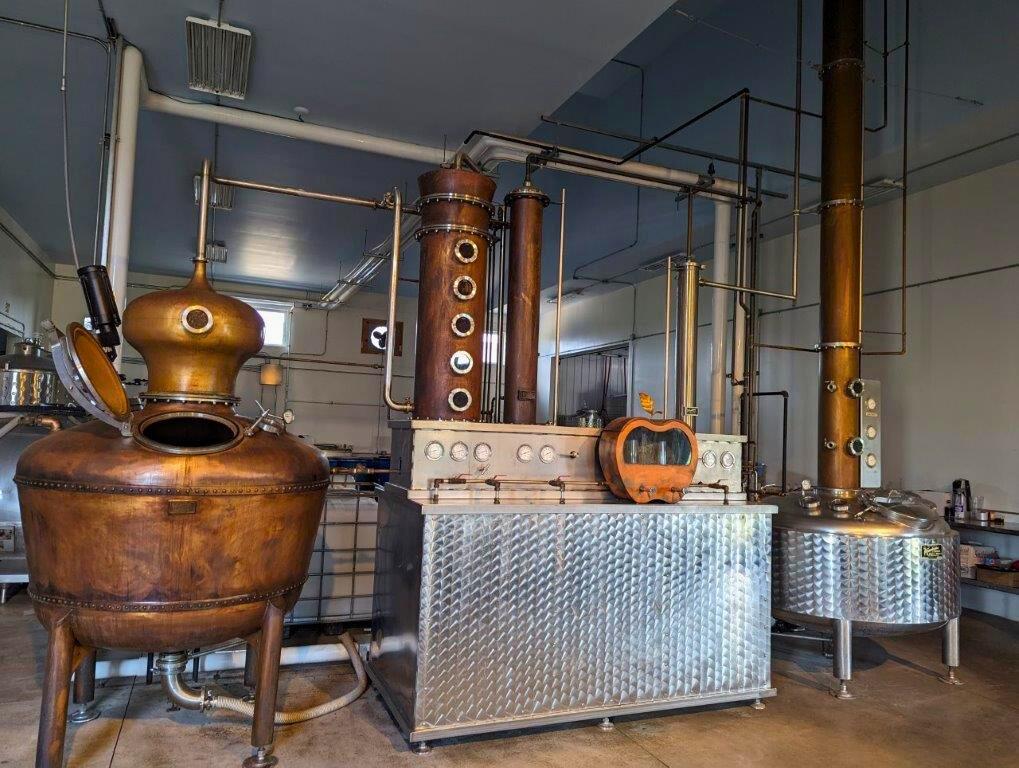
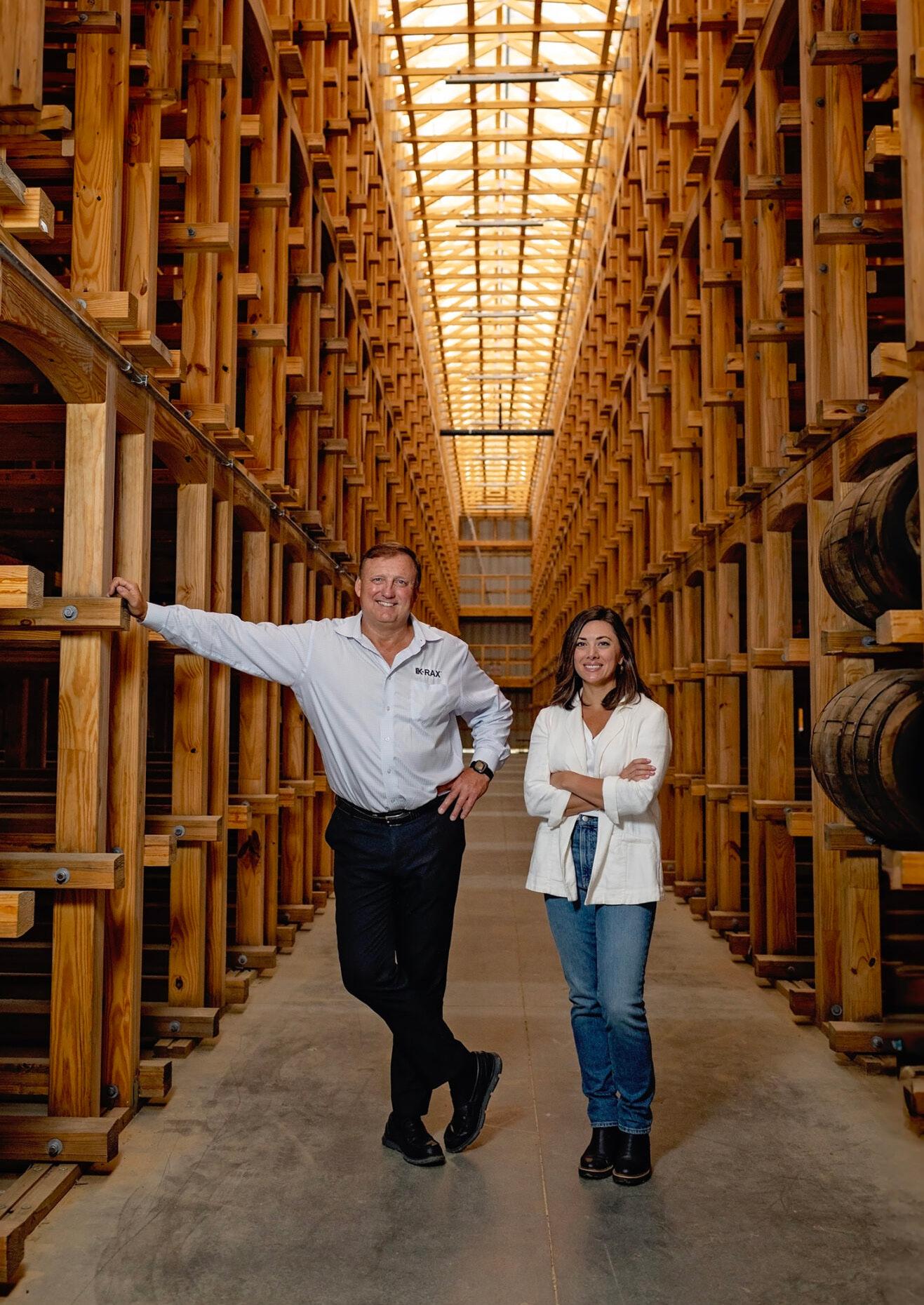
“The Blending House development will be a showroom for the K-RAX rickhouses, provide a home base for our core clients and supply third-party storage for other non-distilling producers (NDPs)” said Monica Wolf, managing partner of The Spirits Group. “We are thrilled to be at this location and thank Shelby County and Judge Ison for their support.”
In addition to storage for The Spirits Group brands, The Blending House will offer third-party premium barrel storage to select clients with high volume needs.
CRAFTSPIRITSMAG.COM SEPTEMBER/OCTOBER 2023 | 27 Industry Update
E x c e l l e n t c o n d i t i o n , w a s u s e d f o r m a k i n g f r u i t b r a n d i e s . A s k i n g $ 5 0 0 , 0 0 0 c o m p l e t e . F o r q u e s t i o n s o r d e t a i l s , c o n t a c t D a v i d a t d w d f 1 0 2 5 @ g m a i l . c o m . d . i 0 , 0 q s r e t a i l , n t D v i d
Vendome 250gal Pot Still and 250gal Vodka Rectifying Still System w/ 1 Mil BTU steam boiler
COCKTAILS: The New Classics
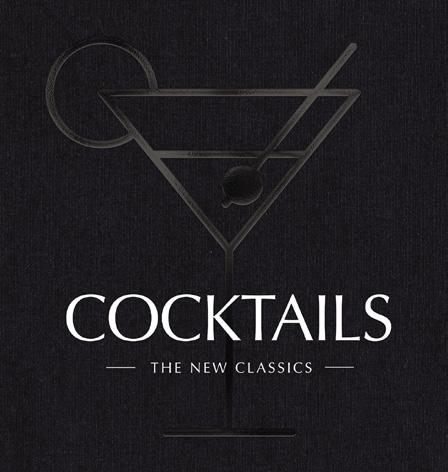
Publisher: Cider Mill Press
Release Date: July 4
This black cloth book is a comprehensive guide to cocktail making, made by award-winning mixologists from high profile bars around the world. It traverses the world of cocktails, from Paris to Tokyo, New Orleans to London, and beyond. Whether you have a reverence for the classics or a passion for concocting new and exciting flavors, these recipes guarantee you’ll have a drink for every occasion. Bartending novices and experts alike will love this stunning anthology of cocktails.
Sober Curious Drinks
Author/Publisher: Stella Rose
Wilder
Release Date: Aug. 5
Inspired by classic cocktails, this non-alcoholic drink recipe book offers an irresistible array of mocktails that sparkle with creativity and flavor. From the refreshing Citrus Sunrise to sophisticated, Sparkling Raspberry Rosé, each recipe promises a delightful journey through fruity, herbaceous, creamy, and even bold and spicy creations.
The Faculty Lounge: A Cocktail Guide for Academics

Author: Philipp Stelzel
Publisher: Indiana University Press
Release Date: Aug. 15
Offering cocktails for every academic occasion along with spirited, amusing commentary, this book is the perfect gift for graduate students, tenure-track professors, and disillusioned administrators. The author studied modern European and German history at Ludwig-Maximilians-Universität Munich, Columbia University (MA), and the University of North Carolina at Chapel Hill (PhD). He has taught at Duke University, Boston College, and is currently associate professor of history at Duquesne University, Pittsburgh.

New York Bars at Dawn
Photographer: Daniel Root
Publisher: Abbeyville Press
Release Date: Oct. 17
Nearly every day, Daniel Root sets out before sunrise to wander the streets of Manhattan with his camera. In those comparatively quiet hours, the entire city wears a different face, but Root is particularly fascinated by the scenes to be glimpsed through the windows of its bars. This book presents some 200 of Root’s most compelling bar portraits, ranging from well-known establishments like Balthazar, McSorley’s, and the Stonewall Inn to nameless dives and an American Legion post.

28 | SEPTEMBER/OCTOBER 2023 CRAFTSPIRITSMAG.COM Imbiber ' s Bookshelf
LEGAL, ETHICAL, RESPONSIBLE
BY LEW BRYSON
Time to talk about alcohol abuse. No introduction, no fancy language: no denial.
The alcohol industry has a blind spot about this tragically common problem. It’s understandable, because it’s literally the job of everyone in production, sales, marketing, etc., to make and sell alcohol beverages. So it’s hard to admit that the thing you do for a career has a potentially dangerous downside. Addiction, violence, accidents. Don’t look away. See the problem, and let’s get to work.
Dealing with these problems is something that has to happen, in the industry overall and in your business, both in your tasting room and in your break room. Let’s be clear: this isn’t just about overserving customers. It’s also about the risks inherent in working in this industry, risks that are finally being openly acknowledged. People are getting out of the business for their health … and it’s shameful that they found getting out to be their best option. We can do better, we have to.
It’s pretty easy to make a case for getting serious about this. In legal/regulatory terms, it’s a classic case of taking care of your problems before someone else forces you to; in ways that might not be for everyone’s benefit. Ignoring this problem will not make it go away. Instead, it guarantees that sooner or later, the government will take regulatory action to restrict your business in ways that, honestly, may or may not prevent alcohol abuse. But they will definitely impose regulations on you—and on other businesses—that will limit your options for sales, for expansion, for promotion.
In financial terms, you risk your business and perhaps your personal assets as well by not having effective policies in place to prevent alcohol abuse and its potential harms. You will find insurance more expensive, and legal representation will likely be more frequent and more expensive.
Legal and financial terms are important, but dammit, it’s also an ethical responsibility.
It’s right in the ACSA Code of Conduct, the paragraph on Responsible Actions; if the ACSA is doing/not doing it, you should be, too. You can’t talk about your community donations and not address this crucial component of your involvement. Maybe more importantly, you can’t think of your company as a mutually cooperative group of people and not be involved in this aspect of their well being.
What do you do? First, get help from the ACSA’s partnership with the TIPS program to get your servers up to speed on safely serving alcohol beverages in your tasting room. If you haven’t already done this, get in touch this week, get it done … and then follow up regularly to make sure employees are fully invested in it.
Then do us all a favor: make sure you’re fully invested in it, make it more than an insurance write-off. Integrate it into your business, live it and let the company know that this comes from the top. Make real accommodations to the policy; for instance, don’t have unrealistic sales quotas that tacitly encourage turning a blind eye.
It’s harder, but make sure your customers know it’s your policy as well. It doesn’t have to be ham-handed, one-size-fits-all, but they should know that everyone’s working to keep them safe. Just like checking IDs keeps businesses and jobs safe; do that, too.
Taking care of your customers is a day-to-day responsibility. They are your business, after all. Taking care of your employees is every bit as important. Your customers are your business, but your employees are your company.
No sales rep should feel pressured to drink at every stop. Does the whole industry need to learn that lesson? Sure. So grab hold of Gandhi: “If we could change ourselves, the tendencies in the world would also change. We need not wait to see what others do.”
Lead: Be that change.
Back home, realize that you don’t have to solve this on your own. Like your distilling and business questions, questions about your employees’ mental health already have answers. You just have to find them. Look at small business Employee Assistance Program (EAP) options. Your local chamber of commerce or small business association may be able to help you find something sized right for you.
Ensure employees that using the EAP resources are 100% confidential. Fear that their issues will become widely-known is the top reason people don’t take the help an EAP offers. Know that, and let them know that it’s safe; make sure it is safe.
Finally … don’t forget to look in the mirror. Look, I do it. Am I okay? Do others show concern about my drinking? Do I try to hide how much I’m drinking? Be honest with yourself so you can be honest with others.
Take responsibility. Fiscal, legal, ethical, personal. It’s a great industry; let’s keep it that way. ■
Lew Bryson has been writing about beer and spirits full-time since 1995. He is the author of “Tasting Whiskey” and “Whiskey Master Class.”

CRAFTSPIRITSMAG.COM SEPTEMBER/OCTOBER 2023 | 29 lew ’ s bottom shelf
Don’t look away. See the problem, and let’s get to work.
STEPPING UP TO BETTER THE CRAFT
STEPUP Foundation Brings Diversity to Craft Spirits Industry, Seeks Class of 2024 Participants

When the STEPUP Foundation was created in 2020, in part with previous and current leaders of the American Craft Spirits Association, it was done so in hopes of finding a solution to an issue of great concern. Chris Montana of DuNord Social Spirits, and a STEPUP Foundation board member, recalled attending his first distiller’s conference and realized that, “I was the only Black guy in the room, I was the only Black person in the room.” The May 2020 murder of George Floyd was a nationwide turning point that further ignited a want and need to open up a larger conversation with colleagues about representation, participation,
access, and overall diversity, equity and inclusion. It became apparent that more space and access within the spirits industry needed to be created, and now was the time to “step up” and take action.
STEPUP stands for Spirits Training Entrepreneurship Program for Underrepresented Professionals. The STEPUP Foundation is a 501(c)(3) nonprofit foundation that provides underserved and underrepresented individuals with hands-on training, encouragement and opportunities to enter the craft spirits community through a comprehensive internship program. The program
is approximately eight months long and has the intern traveling to a host distillery, a specialty distillery, a distributor, one entity of our Cornerstone Partner, and then each intern returns to their host distillery to complete a capstone project. STEPUP provides a comprehensive curriculum to aid and guide each DSP/wholesaler with the education of the intern. Each intern is also assigned a mentor for the duration of the program. It is an intentional, practical, and holistic approach to educating and providing access to those of different races, color, national origins, abilities, genders and sexual orientations.
30 | SEPTEMBER/OCTOBER 2023 CRAFTSPIRITSMAG.COM
STEPUP
Ashley Grayson, Erin Lee, Amy Salter and Yakntoro “Yaki” Udoumoh
Most Americans understand that a diverse workplace contributes to higher performance, innovation, creativity and overall growth for their businesses. But, the need for a program like STEPUP within the spirits industry is apparent not just from observation, but also from data. According to the 2023 DEI Study conducted and published by Deloitte and Women of the Vine and Spirits, and the 2020 Crunchbase Diversity Spotlight Report, “Of the industries that did the best job of attracting and retaining a diverse workforce, respondents said that Bev/Alc fell toward the bottom—at about 3% in comparison to other top industries like high tech (21%), healthcare (15%), and hospitality (15%)”. Some of the top reasons for potential candidates not considering a career in the bev alc industry included: “lack of diversity, equity and inclusion (49%).” Since 2015, just “2.4% of venture capital financing across all sectors in the United States went to Black and Latinx founders.” Only “2.3% of global venture funding went to female-only founders, a decline from 2019.” STEPUP was created to address these very issues.
With sustainable growth in mind, the STEPUP internship has two interns enter and
successfully complete the program each year. 2022 alumni Yakntoro “Yaki” Udoumoh and Erin Lee have secured positions as distillers at Sagamore Spirits and FEW Spirits, respectively. Lee shared, “There has been much I’ve learned through STEPUP that has been immediately useful—understanding distillery processes helped me to onboard/get through training faster. Now as I’ve become more comfortable in my role, I can also contribute to FEW (Spirits) using the knowledge I’ve gained through STEPUP.” The Class of 2023, Ashley Grayson and Amy Salter, will have successfully completed this year’s program in September. Each intern, while on their own individual journey, made great strides during the course of this year, greatly exceeding expectations with their exceptional performance. There is no doubt that they will each lend their unique experience and lens to the overall betterment of the industry as a whole.
Of course, the success of the interns and the program does not happen overnight in a vacuum. Many folks have graciously donated their time to mentor, opened up their distilleries to host, and provided financial contributions to ensure that the foundation is able to carry out
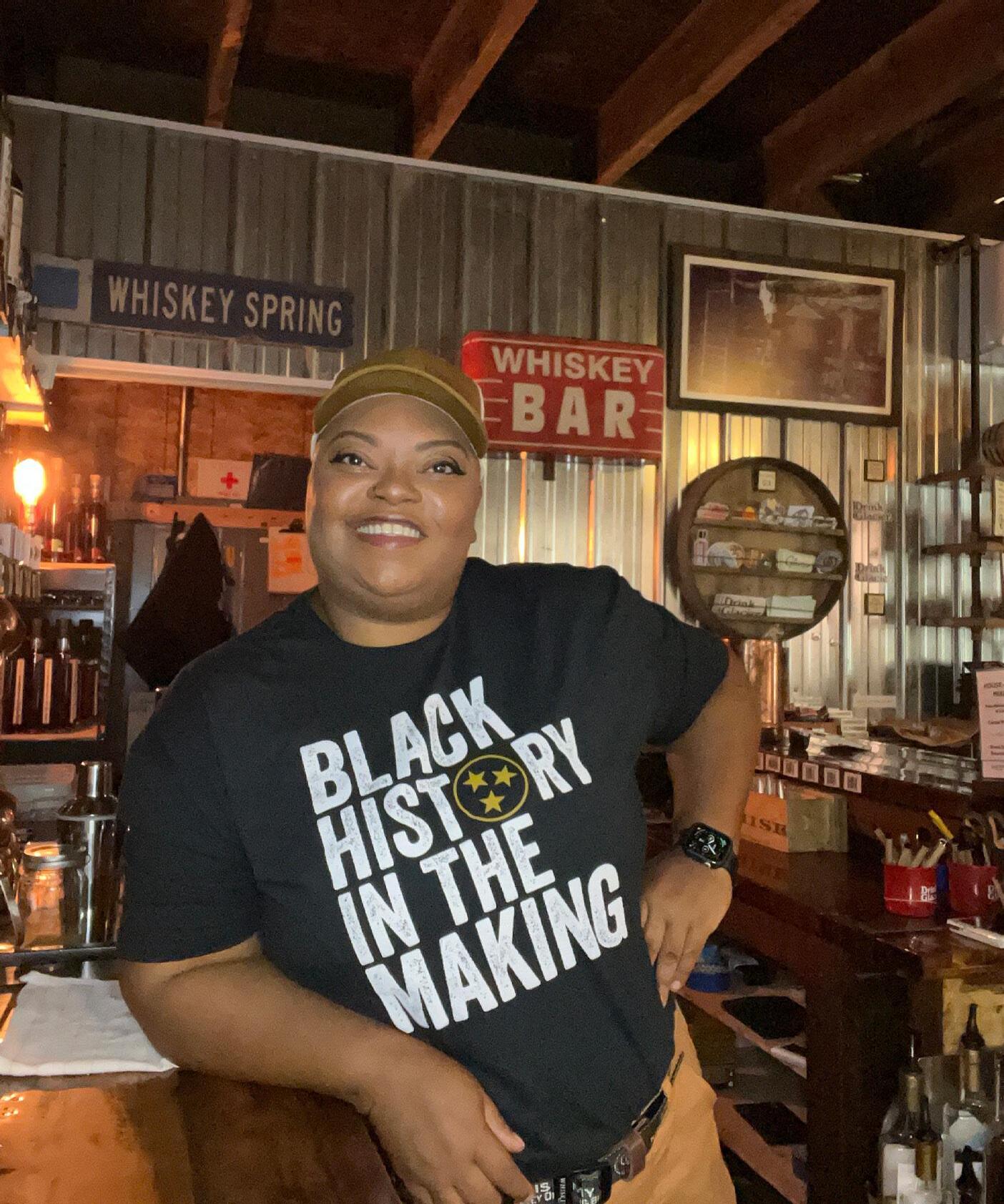
its mission. For Sailor Guevara, a 2022 mentor, “Being a mentor for the STEPUP Foundation was one of the most rewarding experiences in my career. My intern was placed at a distillery in her dream job before she officially graduated, and she continues to thrive and excel with the incredible support of her colleagues, the STEPUP Foundation team and the American Craft Spirits Association members. I am incredibly proud to be a supporter of STEPUP.”
The craft spirits community is filled with dynamic, kind, and innovative helpers with decades of experience. In 2024, who will be next to STEP UP?
Applications for the Class of 2024 are now open and close on Oct. 6, 2023. Potential Intern, Mentor, and Distillery/Wholesale applicants can apply on the STEPUP website at: stepupinternship.org. Any questions regarding details about the program can be directed to: Margie A.S. Lehrman, STEPUP President at: margie@stepupinternship.org or to Sharli Ward, STEPUP Program Manager at: sharli@ stepupinternship.org ■
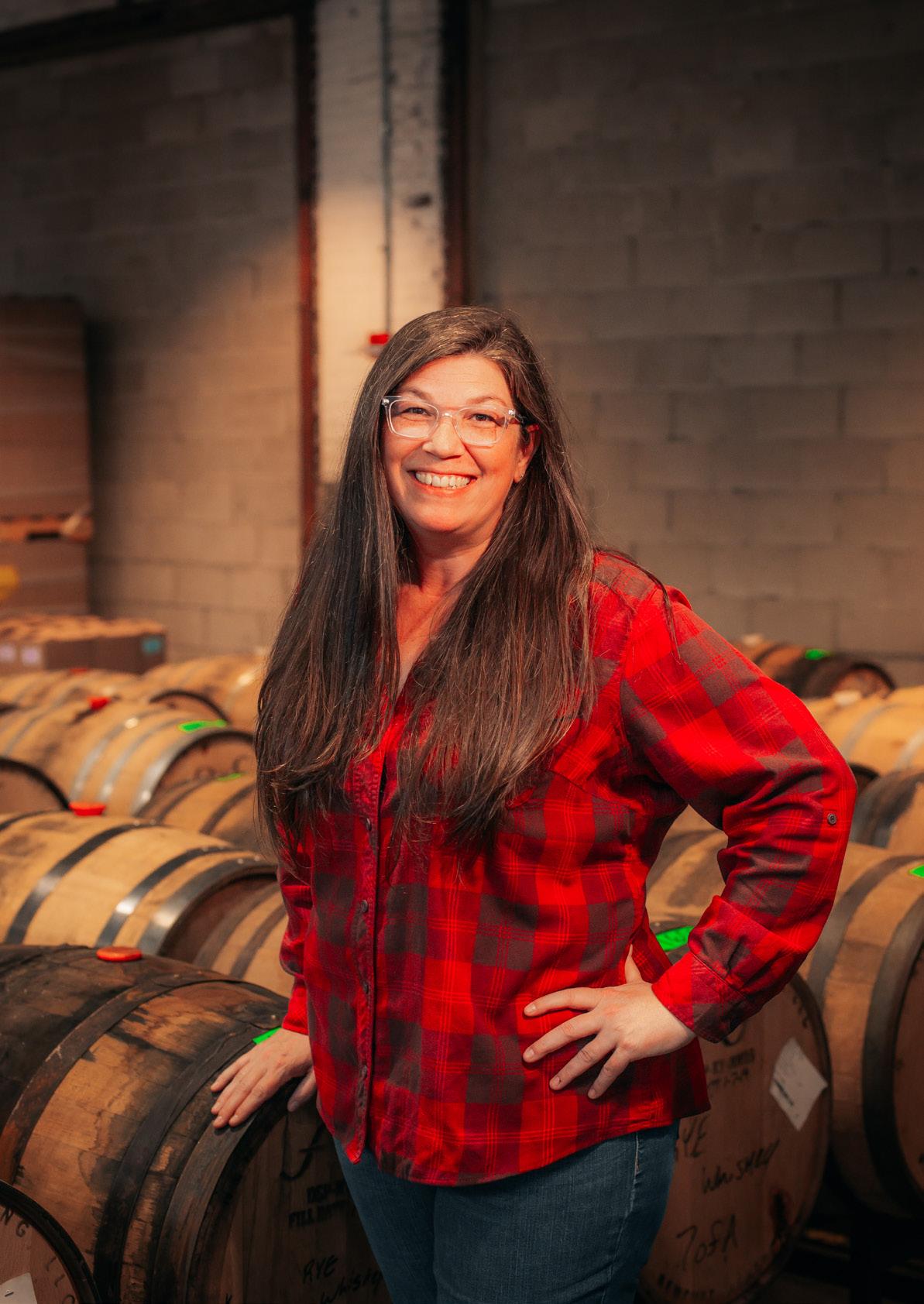
CRAFTSPIRITSMAG.COM SEPTEMBER/OCTOBER 2023 | 31
HERE TO LEARN MORE AND APPLY.
CLICK
TAKE PART IN THE CRAFT SPIRITS DATA PROJECT AND RECEIVE A CONVENTION DISCOUNT
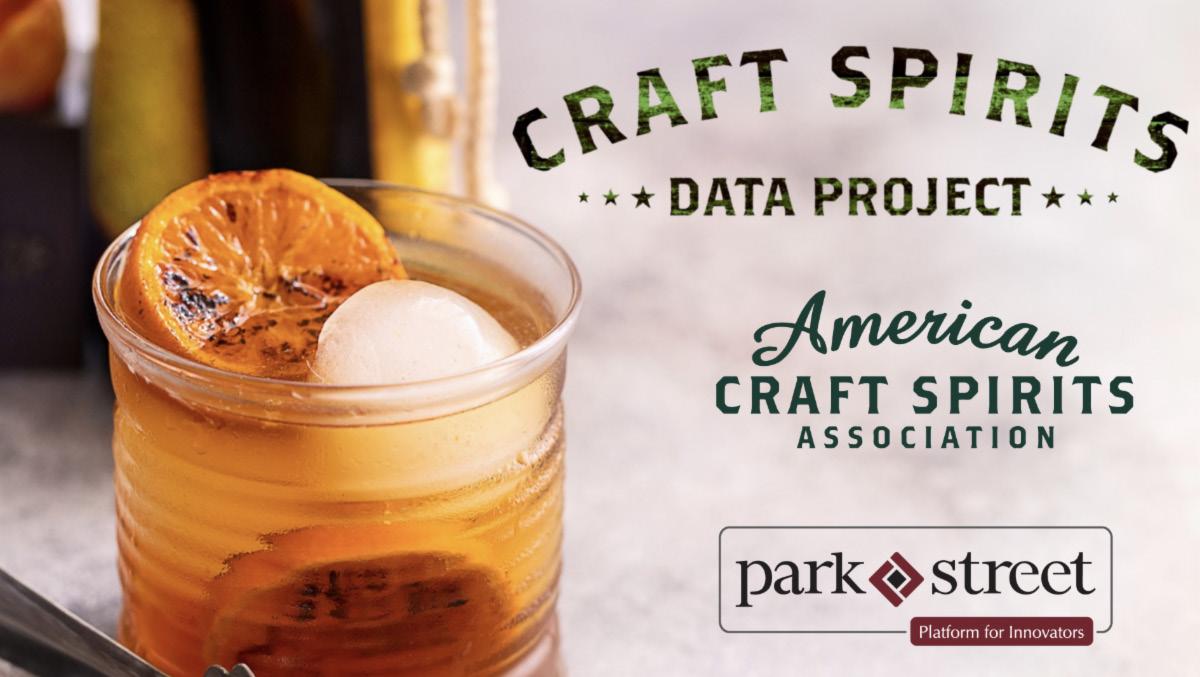
The Craft Spirits Data Project (CSDP), introduced in 2016, provides the needed lens for regulators to evaluate the state of our small business manufacturers.
The results from this annual study—
brought to you in conjunction with our valued partner, Park Street—also help us share your struggles and success with:
• Members of Congress at both the federal and state level
• The media
• Financial institutions
• Agriculture groups
• Guilds
But ACSA can’t do it without your help. We need you to either complete the survey or send it to someone within your business who can complete the economic data which will be reported out in the aggregate. The survey is due to close on Oct. 1, so the clock is ticking.
Because ACSA knows your challenges, we want to offer some relief. Anyone who completes the survey will be offered 5% off an attendee pass for ACSA’s 11th Annual Distillers’ Convention and Vendor Trade Show in Denver next February 26-28. A code will be sent once the survey closes. Five respondents will also be awarded a waiver of full convention registration fees through a random drawing!
ACSA ANNOUNCES 2023 HEARTLAND WHISKEY COMPETITION AWARDS
In late August, ACSA announced the top medalists in the 2023 Heartland Whiskey Competition, which was open to craft whiskeys from all 50 states that incorporate corn in their mash bill (the mix of grains used to make whiskey). In this fourth, biennial blindjudging event, whiskeys from 20 “Heartland” states competed for Best of Show, Best of State, Top Farmer-Distiller, along with entries from all 50 states that competed in traditional whiskey categories (e.g., rye, bourbon, etc.).
The competition, generously sponsored by state corn marketing associations, took place in early August, in St. Louis, Missouri. ACSA facilitated the judging process and its recent board president Chris Montana—owner of Du Nord Social Spirits in Minnesota—served as Judging Director. Judges selected from the Missouri and Illinois spirits industry by ACSA were chosen for their knowledge of craft whiskey.
Best of Show was captured by Casey Jones Distillery from Hopkinsville, Kentucky, for its Casey Jones Single Barrel Original 4 Grain Wheated Kentucky Straight Bourbon, which
also earned the top score in the Four Grain Whiskey category.
Top Farmer-Distiller, a new category for the 2023 competition, was captured by Tobacco Barn Distillery of Hollywood, Maryland, for its Single Barrel Bourbon. Tobacco Barn is owned by Scott Sanders, Sean Coogan and Dan Dawson, the latter of whom operates the farm—family-owned for more than 100 years— where all of the corn for their winning bourbon is grown. Many corn farmers own and operate craft distilleries and have won top honors in previous Heartland Whiskey Competitions.
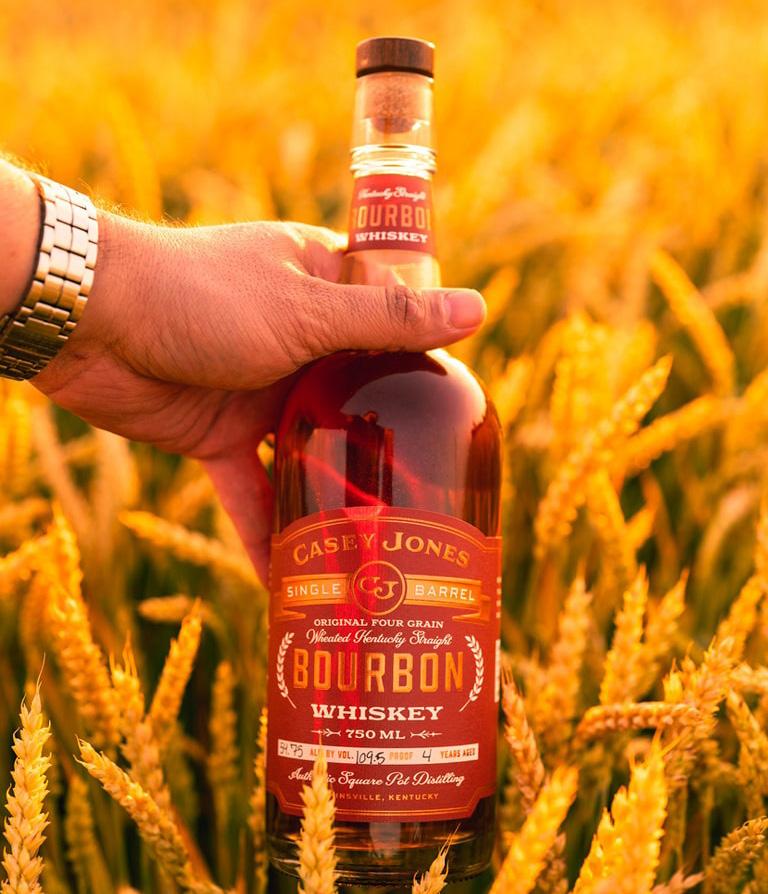
“Corn farmers, through their state corn associations, have supported the U.S. craft distilling industry through this important competition,” stated Margie A.S. Lehrman, C.E.O. of ACSA. “We greatly appreciate their continued support and the fact they supply our members with the best corn product in the world.”
The 2023 competition saw significant growth in the number of participating states and entries which greatly increased competition for medals. Only 12 whiskeys were awarded a gold medal, while 74 received silver, and 47 bronze. “It is important to recognize craft distillers, an industry that relies on the
corn we grow, have sustained their businesses through trying times and continue to improve an already excellent product,” states Brent Hoerr, Missouri Corn Merchandising Council chairman. “Corn growers throughout the Heartland, through their participating state corn associations, support these entrepreneurs, many of whom are working farmers and all of whom are our customers.”
32 | SEPTEMBER/OCTOBER 2023 CRAFTSPIRITSMAG.COM ACSA Affairs
CLICK HERE TO SEE ALL MEDALISTS AND STATE AWARDS.
TAKE THE CRAFT SPIRITS DATA PROJECT SURVEY.
ANNOUNCING ACSA’S LEGISLATIVE FLY-IN: COME LET YOUR VOICE BE HEARD
ACSA’s Legislative Fly-In on Capitol Hill is back—and in person—this Nov. 7-9!

Register now to let your voice be heard before members of Congress and meet with senior leadership from the U.S. Alcohol and Tobacco Tax and Trade Bureau. This event is open to all members who want to help educate Congress on issues facing our small business manufacturing sector. No experience is necessary—we will provide a full briefing and get you up to speed on issues that can change our economic landscape.
Plus, we’ve negotiated a terrific room rate, so come experience all that Washington, D.C., has to offer. The agenda will include a welcome reception on Tuesday night, a full day of Capitol Hill briefings and meetings, and a Hill evening closing reception in which your own spirits may be poured.
ACSA WELCOMES TWO NEW STAFF MEMBERS
We are thrilled to announce that in July, two new staff members joined the ACSA team. Please join us in welcoming Akshay Anikhindi, our new IT Strategist and Technology Integration Manager, and Anna Klainbaum, who comes on board as Director of Marketing and Membership. We recently asked each of them a few questions to help our community get to know them.
Akshay Anikhindi: I’ve been working in the nonprofit and association space for the last 15 years as a digital communications manager and IT professional. I’m passionate about working specifically with these organizations because I believe it gives me a sense of purpose within my career.

FIRST-EVER AMERICAN CRAFT SPIRITS FESTIVAL SCHEDULED FOR OCTOBER
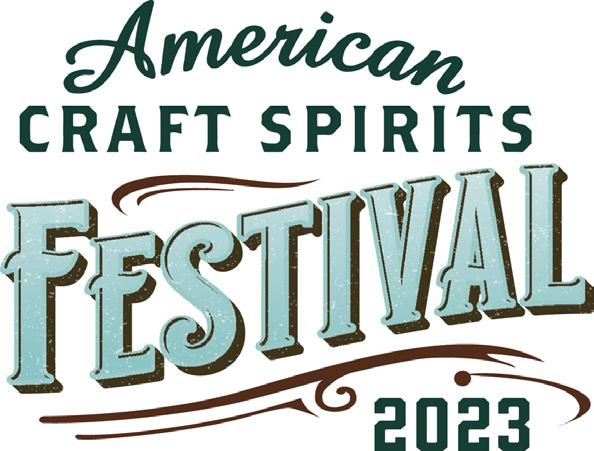
This year ACSA is marking its 10th anniversary, and each month we’re celebrating with a new initiative. On October 26, the country’s top craft spirits producers will be pouring for consumers and select members of the trade during the first-ever American Craft Spirits Festival at Binny’s Beverage Depot in Chicago. We expect over 50 distilleries and hundreds of attendees!
The event will feature education by industry leaders as well as an opportunity for sponsors to connect with distilleries during trade-only festival hours. An exclusive ACSA-published cocktail booklet featuring recipes from participating distilleries will also be distributed to all attendees. Stay tuned for details on tickets.
Anna Klainbaum: I’ve worked across marketing and communications my entire career, with a focus on content and brand development. Nearly every job I’ve had since I was 16 years old has been in food, wine, spirits, or hospitality, and I wouldn’t have it any other way. I also have an extensive background in working with associations, so it’s wonderful to be able to bring together all of that experience in this new role.

What attracted you to the position at ACSA?
Anikhindi: Throughout my career working with different organizations, I have never worked for an association where I actually feel as if I understand the members. I’m an avid bourbon collector, and consider myself an amateur mixologist, so I am genuinely excited to represent an association whose founding members include some of my favorite distilleries like Copper Fox and Widow Jane.
Klainbaum: I had worked with the organization as a consultant in the past, and was so impressed by the staff. They are so committed to the success of the craft spirits industry, and they are a pleasure to work with.
What excites you the most about the craft spirits industry?
Anikhindi: There is plenty of room for innovation and to try something different. Craft spirit distillers can forge their own path, without being burdened by a sense of heritage or forced to cater to a built-in audience. I think people are looking for something fresh and unique. I know I am!
Klainbaum: I love the people, and that it’s an industry built on relationships (as well as delicious drinks.) I have a lot of respect for the passion and entrepreneurial drive it takes to bring a craft spirit to market. So much love and energy goes into each bottle!
What is most likely to be in your glass?
Anikhindi: I’m a bourbon, rye and whiskey guy, but love drinking (and making) cocktails as well. My go-to bourbon is usually the Virginia-based A. Smith Bowman Distillery’s John J. Bowman Single Barrel. I’m also a huge fan of the stuff Starlight and Nulu are putting out with the finished whiskeys.
Klainbaum: Gin and tequila are tops for me. Lambrusco also makes me quite happy!
CRAFTSPIRITSMAG.COM SEPTEMBER/OCTOBER 2023 | 33 ACSA Affairs
CLICK HERE TO REGISTER FOR THE FLY-IN.
BRANDY VOLUME TRENDS
BY JEFF CIOLETTI
The overall spirits market continues to absorb the impact from the perfect storm of inflation, high interest rates and banking crises from earlier this year, posting a volume decline of 1.4% for the 12-month period that ended in July 2023, according to SipSource, the industry’s only data source based on aggregated wine and spirits distributor depletion data. The comparable 12-month period that ended in July 2022 actually showed a gain of 4.8%. If you take RTDs out of the equation, the drop is significantly steeper, at 3.7%.

The brandy category experienced an even greater decline of 10.3% at mid-year 2023, following a slightly steeper drop of 11.2% at the same point in 2022.
However, the story changes a bit when we get into the premium price tiers.
Volume for total spirits priced at $25 and above slipped by 3.3% for the year ended July 2023, versus a surge of 6.1% for the similar period ended July 2022. However, volume for brandy in the $25 to $50 per bottle range— which saw a drop of 3.1% for the 12 months ended July 2022—managed to increase by 4.2% for the most recent 12-month period. Brandy at that price tier commands a relatively small share of the overall category, accounting for only 3.5% of all brandy. But it’s generally the space that craft brandies tend to occupy. And the growth is coming from both on- and off-premise sales. ■
34 | SEPTEMBER/OCTOBER 2023 CRAFTSPIRITSMAG.COM
COMPARISON, ALL PRICE LEVELS VOLUME CHANGE COMPARISON, PREMIUM PRICE TIERS BRANDY, $25-$50, CHANNEL SHARE ■ 12-month ending 7/22 ■ 12-month ending 7/23 ■ 12-month ending 7/22 ■ 12-month ending 7/23 On-Premise 12% Off-Premise 88% SOURCE: SIPSOURCE Total Spirits, $25+ Total Brandy, $25-$50 +6.1% -3.3% -3.1% +4.2% Total Spirits Total Spirits excl. RTDs +4.8% -3.7% -1.4% +1.8% Total Brandy -11.2% -10.3% DATA DISTILLED VOLUME CHANGE COMPARISON, PREMIUM PRICE TIERS 12 months ending 7/23 On-Premise Off-Premise +4.3% +3.3%
VOLUME CHANGE

Listen wherever you find your podcasts or visit craftspiritsmag.com CONVERSATIONS WITH ICONS AND INNOVATORS IN THE WORLD OF CRAFT DISTILLING
The Fruit Stand
What keeps brandy makers in such a challenging category?
 BY JEFF CIOLETTI
BY JEFF CIOLETTI
When David Weglarz offers you a taste of his distillery’s range of spirits, you know that the last thing the StilL 630 founder would ever do is bore you.

From its Rally Point Straight Rye and Missouri Straight Bourbon to its Big Smoke American Single Malt, StilL 630 boasts one of the Midwest’s most varied, innovative and awarded whiskey portfolios. Add to that a trio of gins and a pair of rum offerings that are no strangers to medals, and it’s hard to argue that the St. Louis distillery doesn’t have something for all tastes. And there’s always going to be an honest, compelling story behind each of them.
That goes for its brandy, as well.
“It’s one of the most, if not the most expensive thing we make on a regular basis,” Weglarz admits, referring to StilL 630’s apple brandy, Knowledge of Good (as well as its ryebarrel-aged counterpart, Knowledge of Evil).
That’s unsurprising, not to mention a common reality among many producers whose portfolios include fruit distillates. After all, they’re dealing with highly seasonal raw materials that are very sensitive to variations in weather and quite finicky about where they’re grown. And it tends to take a far greater volume of fruit than it does grain to produce the same quantity of spirit.
Then there’s the fact that, unlike, say, whiskey of any style, a relatively small number of American consumers truly understand what brandy even is. So a person could be forgiven for asking brandy distillers why they do what they do. Weglarz has no shortage of answers to that question.
“We kind of look at it as an opportunity to flex our distilling skills and show that we can take a different, totally unrelated product to the normal rum or whiskey or gin that we do and come up with something truly unique that embodies that spirit,” Weglarz says. “I think that part of our job as small distillers is not only to make the people what they want, but also to help them expand their palates and give them little gateways into new genres.”
It’s not too much of a stretch for brandy to provide one of those gateways. It may be unfamiliar to large swathes of the American drinking public, but it’s hardly what one would call “new.”
“I’ve thought of brandy as a traditional American spirit,” Weglarz notes. “As distillers went westward, fruit brandies were something that they brought with them from their native countries. So for me, it was something that I thought was such a quintessential
American spirit, even if it’s thought of as more European. Apple brandy was something that I thought was just another aspect of American distilling that we could put our little thumbprint on.”
The motivation was a personal one for Ted Huber. His family fruit farm produced wine and brandy from the 1840s until Prohibition. The Hubers were able to resurrect the winery in Borden, Indiana, in the early 1970s and Starlight Distillery followed nearly three decades later once they were able to get Indiana laws changed. “My grandmother taught me how to make our apple brandy, what we’d call Applejack, and that’s kind of what got us started trying to get the distillery back,” Huber reveals.
Starlight now produces spirits from both apples and grapes (including grappa)—it’s best known for the former, as that represents a greater share of its brandy volume. Within its apple program, the distillery makes products that follow two distinct traditions. Its 80 proof Apple Brandy (as well as its 100 proof Bottled in Bond Apple Brandy) are close siblings of Calvados, aged in French oak for at least 10 years. The 83 proof Applejack Brandy, aged in American oak, is a direct descendant of the first spirits produced by European colonists in North America.
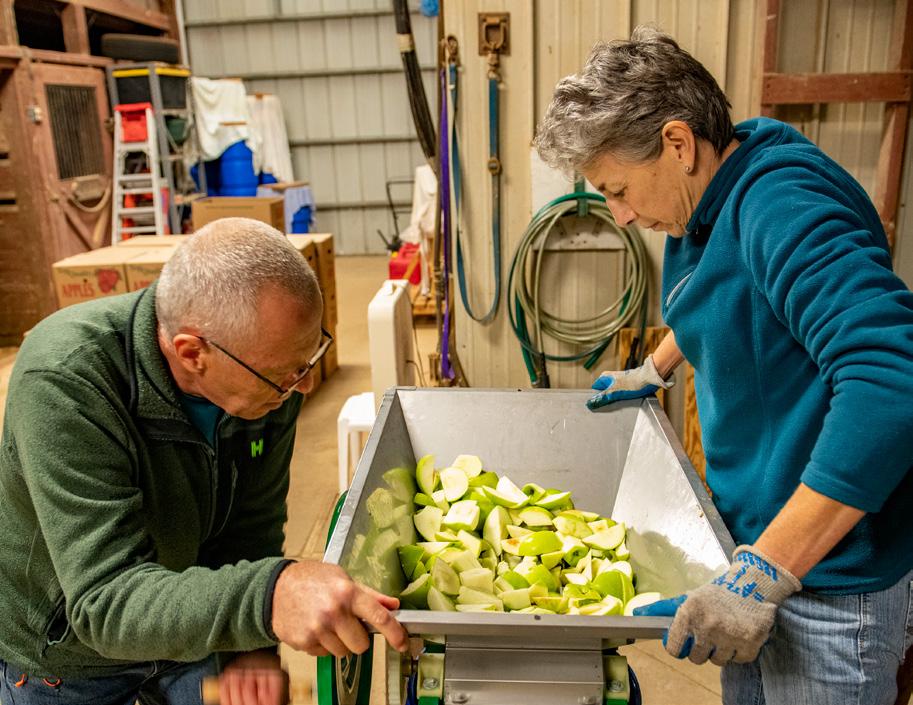
HONORING TRADITION
That European influence isn’t just relegated to America’s early history. Modern transplants from the continent continue to bring their distilling heritage to these shores, introducing spirits styles that are mostly unknown to mainstream North American consumers. Many of those fall into the eau de vie/edelbrand/obstler/schnaps space, depending on their place of origin. Those are even tougher sells here than barrel-aged apple- or grapebased brandies, since, historically, they’re very specific to the producer’s European region of origin and Americans, for the most part, don’t have the same aperitif and digestif traditions that those regions have enjoyed for centuries. For many of those producers, making clear fruit brandies is as much a birthright as it is a labor of love.
Distilling such spirits is very much in the DNA of Hungarian-born Bela Nahori, who’s carrying on the family palinka tradition in Oakland Park, Florida, as owner and distiller of ChainBridge Distillery. “I grew up with fruit brandy culture in Hungary,” says Nahori. “My grandfather was always making it and I watched and learned the process. I always say to customers that I’m a professional fruit cleaner.”
CRAFTSPIRITSMAG.COM SEPTEMBER/OCTOBER 2023 | 37
“The nuanced flavors that come from an unaged brandy are spectacular and they’re just like biting into the fruit. That’s our goal, to create a drinking experience that allows you to imagine that you were biting into that piece of fruit.”
—Lynn DeLean-Weber of Edelbrand Pure Distilling
It’s usually a fairly heavy educational lift when consumers come into the ChainBridge tasting room. “Everyone who comes in lately asks for tequila,” Nahori laments.
But that face-to-face interaction is critical in building the category, even if it’s just one consumer at a time.
“It comes with lots of education, lots of tastings and tours,” Nahori observes. “Not everyone who goes through the education, tasting and tour likes it because their palate is not accustomed to it, they don’t value it as much. But for most of our customers who are not familiar with the brandy, once they see the process and taste it, they tend to like it.”
It shouldn’t be too surprising when visiting consumers do like it. ChainBridge’s Williams Pear Brandy did, after all, earn Best in Show honors in ACSA’s 2020 spirits competition.
At least most consumers have heard the term “brandy,” even if they’re not quite sure what it is. Imagine trying to introduce a completely unfamiliar, non-English word into their vocabulary when you’re trying to sell them a distilled fruit beverage. That’s the key challenge for Austrian Farms of Texas (AFT) Distillery. The Luling, Texas-based producer makes
Alpengold Edelbrand, choosing a German term to reflect Alexandra Cantwell’s Austrian heritage and training when she and her husband, K.C., opened the distillery in 2017.

“We decided to make brandy, but not just any brandy,” Cantwell recalls. “We have a very special thing in Austria, which is the most sought-after brandy in the world called edelbrand, translated to ‘noble’ brandy, made only from the fruit, yeast and water.”
She turned to distillers in the small Austrian village of Stanz to show her the ropes.

“This is not a craft you can find in any book, you have to be trained and taught by a master distiller in Austria,” she notes. And those techniques, she says, have been closely guarded family secrets throughout the country for about six centuries. “It was over the decades and centuries that these families created recipes and procedures to perfect the art of making edelbrand. … To find one of these distillers was pretty much impossible because these people keep their secrets in their families and it never gets out.”
When she did find a distiller and explained that she wanted to make edelbrand in Texas, the entire village got involved. “They can’t
export it, not even in Europe, so not many people know about edelbrand, besides the local people,” she says. “[Since I was] not in competition or in danger of taking any business away from them, they decided to teach me.” The villagers gave her a three-week intensive course on all things edelbrand.
But learning how to make it is one thing. Selling it to a Texan consumer base is a whole other story. The Cantwells had moved to an area between San Antonio, Austin and Columbus, a suburban triangle, which boasts a significant population of families with German, Czech and Polish heritage. “They know what real schnaps is and that it has nothing to do with the peach or peppermint stuff that you get here,” Cantwell notes. “We were targeting this specific demographic group because we thought these people were familiar with what we were doing. We pretty much hoped we’d get a good start there and not have to do a lot of customer education. We were wrong.”
To be sure, there was plenty of interest from the public when the distillery opened six years ago and there continues to be. The challenge, though, even among those “in the know”
38 | SEPTEMBER/OCTOBER 2023 CRAFTSPIRITSMAG.COM
“I grew up with fruit brandy culture in Hungary. My grandfather was always making it and I watched and learned the process.
I always say to customers that I’m a professional fruit cleaner.”
—Bela Nahori of ChainBridge Distillery
about the category, is educating them on the reasons for the spirits’ far-above-premium pricing. Depending on the fruit, a 375-mL bottle of Alpengold Edelbrand sells for between $44 and $63.50, plus tax. It typically takes between 12 and 14 pounds of apples, 14 to 16 pounds of pears and up to 24 pounds of cherries to make a bottle of spirit based on their respective fruits. So, even for the most nostalgic Western and Central European immigrants, there’s quite a learning curve.
“This is not your grandpapa’s brandy, which you get for $9 a gallon,” she frequently explains. “What we found out—and I don’t want
to sound conceited—is [our products are] for a certain elite customer group, who want the best and who can appreciate it. Eighty percent of our clientele, I would say, have two liquor cabinets: one is for friends and visitors and a second for them, in a secret room. And that is where our product is.”
It was certainly a bold choice for AFT Distillery to bet on a spirit with an unfamiliar, oft-mispronounced name and start producing it stateside. It’s a whole other level when a producer chooses to name their distillery after that esoteric European distillate. That’s essentially the origin story for Edelbrand Pure

Distilling in Marthasville, Missouri, another family affair with overseas roots, opened in 2014. In this case, the country of inspiration was Switzerland, where master distiller Martin Weber was born and raised. He co-owns Edelbrand Pure with his American-born wife, CEO Lynn DeLean-Weber, as well as Lynn’s daughter Tess DeLean.
“The idea of having unaged fruit brandies wasn’t too far of a stretch for [Martin], because if you’re Swiss, you likely have fruit trees in your backyard and if you have fruit trees in your backyard, you’re likely making mash,” says DeLean-Weber. “Very few people



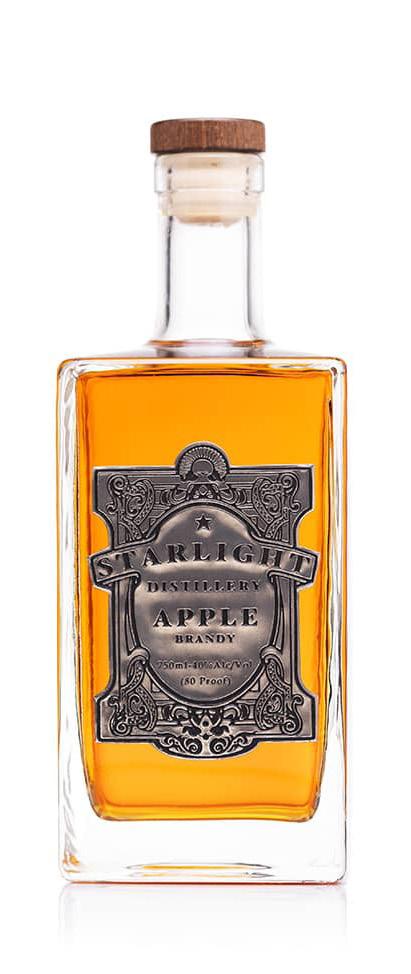
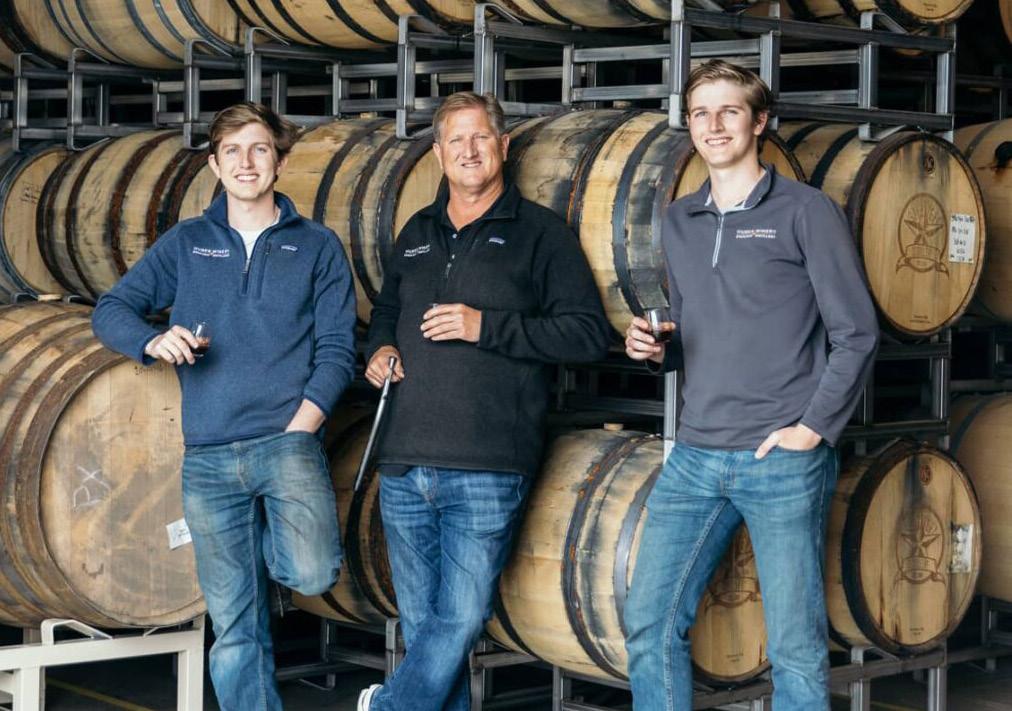 Christian, Ted and Blake Huber of Starlight Distillery
Christian, Ted and Blake Huber of Starlight Distillery
are doing the distilling, but they take it to the village brennerei, the distiller, and they pay him for his taxes and his bottles and his time, and they can bring back their spirits. … After 9/11 it just became increasingly harder to get these spirits into the states, at any quantity that would last between trips.”
That’s what inspired Martin to try making it himself back in Missouri.
“The nuanced flavors that come from an unaged brandy are spectacular and they’re just like biting into the fruit,” says DeLeanWeber. “That’s our goal, to create a drinking experience that allows you to imagine that you were biting into that piece of fruit. So that’s kind of what got us going. I think, probably, the more interesting question is ‘Why the hell are we still doing it?’”
All joking aside, Martin and Lynn launched their commercial endeavor with their eyes open, knowing it would be a challenging journey.
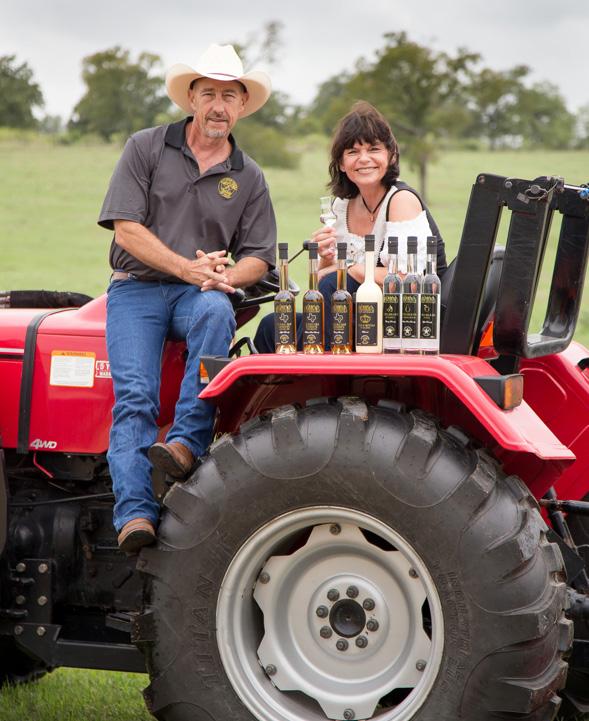
“We knew when we started this, we were going to have a long runway—a really long runway,” DeLean-Weber recalls.
The goal, naturally, was to run a profitable business, but not at the expense of quality.
“I don’t say that as a cliché—we knew we’re in a niche within a niche,” DeLean-Weber continues. “And traditional brandy in the U.S. has always been a stepchild to whiskey …and yet it was the original American spirit. And it’s something that, regardless of size, all brandy makers struggle with.”
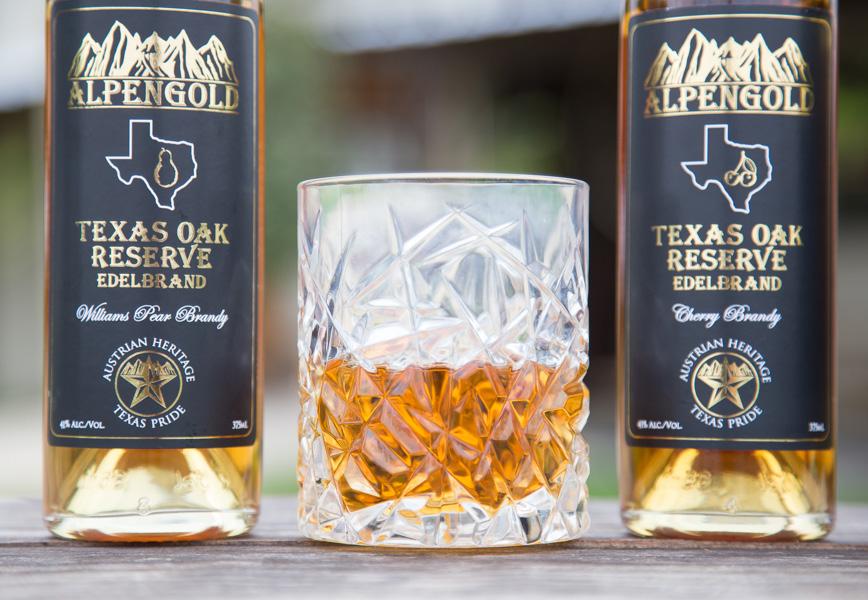
Edelbrand Pure frequently gets stark reminders of just how wide the knowledge gap is for the category in both the public and the trade. DeLean-Weber details a particular on-premise staff education session at a restaurant account that vividly illustrated that disconnect. “They brought in their bartenders and their waitstaff in a room—I guess we had 12 to 15 people—and I just opened up the discussion: ‘When I say the word brandy, what comes to mind?’” she remembers. “And first there was dead silence.”
Finally, a restaurant team member chimed in with “Brandy Alexander.” And someone else followed with that perennial favorite, “my grandfather’s drink.”
“So we knew right from the beginning that we were going to have to focus on education because most of the buying public, whether they’re behind the bar or in front of the bar, don’t know that brandy is fruit-based,” DeLean-Weber says.
It doesn’t help that the spirit goes by so many different names, depending on where in the world you’re drinking it. “If we were selling
CRAFTSPIRITSMAG.COM
K.C. and Alexandra Cantwell of Austrian Farms of Texas Distillery
How do you like them apples?
When StilL 630 was developing what ultimately became Knowledge of Good, it was keen to work with a local fruit source. “We went to some great local apple orchards, and the first one, the biggest one, told us to go pound sand,” recalls David Weglarz.
The distillery had much better luck with the next orchard it approached, which was able to provide a blend of fresh-pressed apple juice.
“One of the things that I was thinking about in regards to apple brandy was not, ‘Hey, we need to find the old Calvadosstyle cider apples that were bitter, and tannic and whatever,’” Weglarz offers. “We want to make apple brandy from the same apples that people are eating and enjoying already, and they were able to help us with that. So, what we get every year is a unique blend of fresh-pressed
apple juice, and we get about 1,600 gallons of apple juice at a time.”
Last year, for instance, the orchard supplied a blend of Golden Delicious and Johnny Red juices. “[The juice] comes to us at about 54 degrees, we warm it up a little bit, ferment it with the cider yeast and then double distill it like everything else,” Weglarz explains.
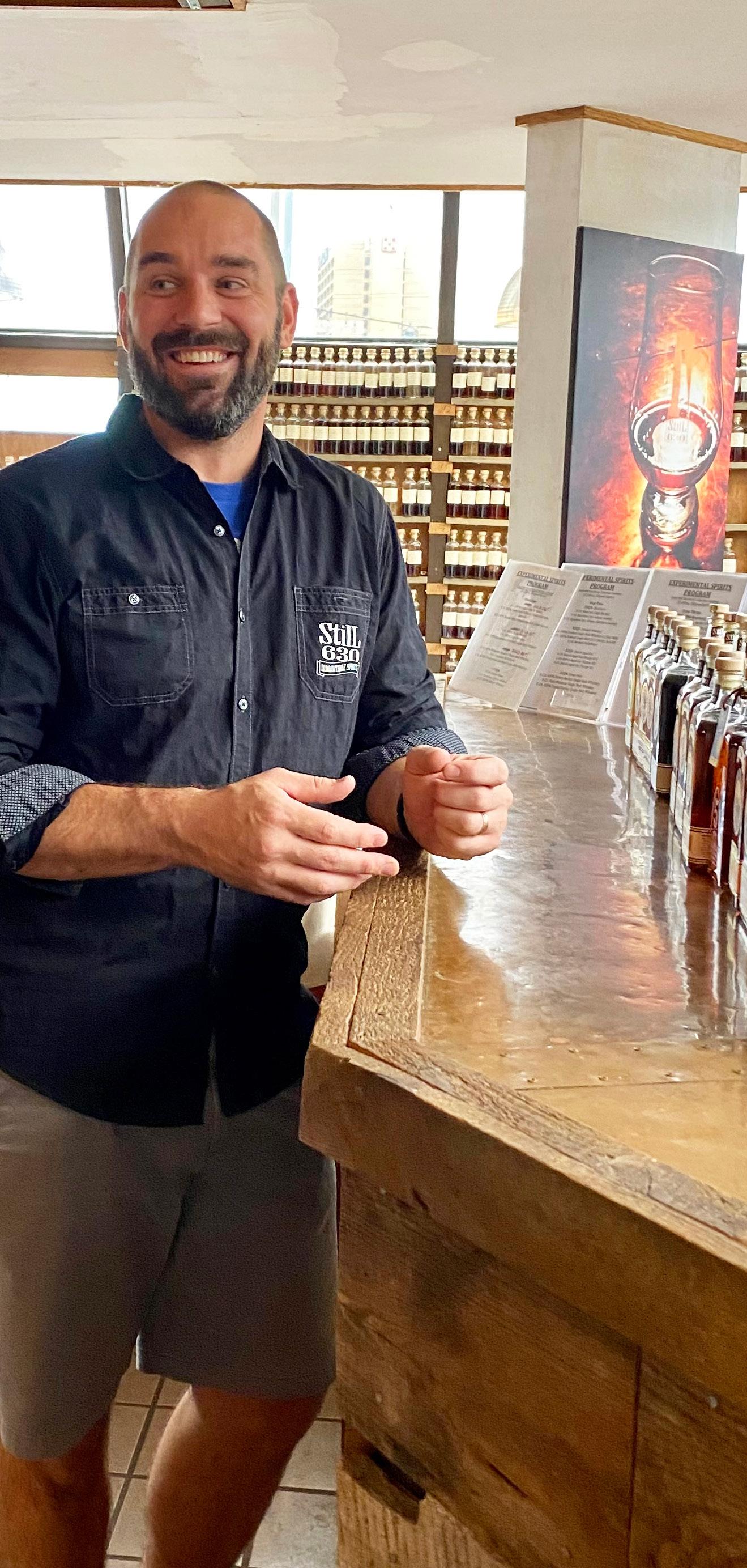
The spirit then travels one of two paths. If it’s to become Knowledge of Good, it matures in new oak barrels for three and a half years. If its counterpart, Knowledge of Evil, is its destiny, the new-make apple brandy goes into casks previously used to age StilL 630’s 5 Year RallyPoint Straight Rye Whiskey. “It’s the same juice going in, but the different barrel treatment determines which one it comes out as,” Weglarz notes.
our product in Switzerland today, it would be known as schnaps—and, of course, you wouldn’t dare call it schnaps over here,” she notes. “We really were pushing a wet noodle up a hill.”
What they hadn’t anticipated as much was how difficult it would be to procure much of the fruit they’d need to make their products. They thought they’d be able to get at least three of the six fruits they use from within their own state. Edelbrand Pure was able to get its grapes and apples in and around Missouri, but the limited access to pears came as a surprise. “Bartlett pears are born in Missouri and Kansas, but not in the quantity we need, because we usually buy one to two pallets,” De-Lean Weber remembers. “And we kept getting farmers who were like, ‘We’ve got this great pear tree, do you want to climb it and get the fruit off?’ And we were like, ‘Nope.’”
And then no one would have been able to predict what would happen in 2020 and continue to ripple today.
“We started to really feel all of the things that were going on in the larger market,” DeLean-Weber says. “Supply chain issues, transportation costs, they just skyrocketed. And most recently, the cost of fruit has just gone nuts.”
That’s especially hard when Edelbrand Pure’s apricots, plums, cherries and pears are
all coming from a good 2,000 miles away. Environmental factors have really done a number on apricots in particular.
“They’re coming out of California, where there are water challenges and we’ve watched 12 years of fruit come and go through our doors and we keep really detailed records about where it’s coming from, when it arrives, the condition, and we’re seeing the effects of climate change on this fruit. And it’s causing it to cost more.”
Across all fruits, the distillery averages about 10 pounds per 375-mL bottle. But the weight ranges vary wildly. While Edelbrand’s grape brandy requires about 8 pounds of its respective fruit per bottle, the same volume of apricot spirit could take as much as 22 pounds. And the raw fruit costs around $2 per pound.
“There are late frosts that are affecting harvests,” DeLean-Weber says, and so probably the greatest challenge we have as a distiller is getting the fruit we need in the time that we need it.”
Any of those variables would leave even the most optimistic of entrepreneurs to question their life choices. But most brandy producers persevere and would tell you that it’s all worth it.
“It’s got its challenges, doing what we’re doing, but it has a lot of benefits too,” says Martin Weber. “I think it’s really fun to
42 | SEPTEMBER/OCTOBER 2023 CRAFTSPIRITSMAG.COM
“I think that part of our job as small distillers is not only to make the people what they want, but also to help them expand their palates and give them little gateways into new genres.”
—David Weglarz of StilL 630
introduce people to this type of spirit category and I think it’s fun to see our spirits at the very top, mingling with some big names— and here we are, this tiny distillery. It’s kind of cool to get the feedback and the recognition as well. It’s got good sides and it’s got its problem, but it all weighs out at the end.”
BEYOND BRANDY
A common sentiment among many of the country’s brandy producers—whether they’re importing hyper-regional traditions from Europe or putting their own modern American spin on the category—is that it’s important, sometimes critical, to diversify into non-fruitbased spirits to help pay the bills. As its name suggests, Swiss-style distillates will always be at the core of Edelbrand Pure’s operation. That doesn’t mean it hasn’t ventured into grain.
The company still adheres to tradition with its Spirit of the Brewmaster series of bierbrands, in collaboration with Urban Chestnut Brewing Company in St. Louis.
“A lot of people call [bierbrand] a beer brandy, but it’s really not,” DeLean-Weber points out. “Bierbrand just means distilled beer.” Varieties have included spirits distilled from Urban Chestnut Brewing Co.’s Thrales Russian Imperial Stout, St. Louis Pale Ale and Winter White ale.
ChainBridge goes considerably more mainstream with its non-brandy portfolio, having branched out to gin (as well as a barrel aged variety), vodka (plus ginger and basil-flavored offerings), and, as you might expect from a Florida-based distillery, three different styles of rum.
“If somebody doesn’t want the brandy, they have other choices to pick from,” says Nahori. “It was a little frustrating at first, but we’re getting used to it and going with the flow. Our top seller is actually vodka. … Unfortunately, I wouldn’t survive if we were only a brandy distillery. I would like to be, but I cannot keep the lights on.”
Very few distilleries have the advantage that Starlight has, with a nearly two-centuries-old family farm and orchards, growing most of the fruit that will eventually become brandy. But even the Huber family is not dependent on fruit spirits alone, with a portfolio that includes several styles of whiskey, gin, rum and vodka.
“It was easy for us to move from making brandy into making whiskey,” Huber reveals. “Knowing what we know now, after making whiskey for many years, it’d be a bit more difficult for us to start making brandy. It’s an easier segue for brandy producers to jump
into other styles of spirits.”
Having those other options, however, does make it easier for a distillery to get consumers of those categories to segue into brandy. Higher-proof brandies, for instance, often entice whiskey drinkers. “We have traditional brandies, 80 proof, don’t get me wrong, and that’s got a very good market out there for the traditional brandy drinkers,” says Huber. “But we’re also doing 100-proof brandies and overproof brandies and that’s a good crossover for the whiskey drinker. A lot of whiskey guys come in and taste the 80-proof brandies and they’re like, ‘Ah, that’s wimpy,’
The sweet spot for those drinkers tends to be across the 90-proof threshold.
“We get in the 90s or above 100, it gets exciting. The flavors are much more concentrated, there’s more body, more structure, more flavor—everything’s just layered in there.”
Rum, particularly aged rum, has also proved to be a gateway into the category.
A FRUITFUL FUTURE
Heritage, family tradition and a general desire to expand your distillery’s repertoire and differentiate your operation from that of your peers are all great reasons to at least dabble in the brandy category. However, distilling is a business and the potential to make a profit in a growing segment should always play an outsized role in any decision. The numbers do offer some good news in that regard. While data from SipSource shows that volume for the overall brandy category declined about 10% during the 12-month period ended in July, 2023, those priced at a premium, between $25 and $50 per bottle—the craft space— grew more than 4%.
Additionally, a seasoned craft brandy producer like Starlight Distillery can be a reliable bellwether for the category. And Huber is largely bullish about its prospects.
“Our brandy sales have definitely risen in the last four years—it started a little bit precovid,” Huber reports. “We started seeing a big kick in ’18 and ’19, then in ’21, ’22, things have gone well.”
The distillery is actually installing new equipment to ramp up its production of the spirit. “We’re going to go up a little bit this year, but next year, we’re going to try to make 10 times the amount of brandy that we used to make.”
He sees growth in both grape and apple brandy, with significantly more likely coming from the latter.
“I don’t think there are any downsides for brandy production in the U.S.,” Huber says. “I
A brandy state?
Sometimes it’s geography—and said geography’s quirky laws—that dictate whether a distillery should get into brandy. Wisconsin has long been known for its version of the Old Fashioned, which tends to eschew bourbon or rye in favor of brandy. It’s also known as one of those states that require any distilled components of a tasting room’s cocktail to come directly from its own distillery. Those were two of the big reasons behind 5 Year Reserve Brandy from Driftless Glen Distillery in Baraboo, Wisconsin.
“With our distillery, with our license, in Wisconsin, you can only sell what you make,” says Driftless Glen co-founder and CEO Renee Bemis. “You can get a beer license, but our spirits have to be only spirits that we make.”
The solution for the distillery was to source five-year-old brandy from France’s Cognac region, and then age it some more in Driftless Glen’s spent bourbon barrels. “That’s the one dark spirit that we don’t produce,” Bemis notes. “Because we don’t do the grapes and the whole thing, it was just silly to do that. … We researched it and we’ve gotten a really great brandy where we sourced it.”
Driftless Glen is transparent about the brandy’s origins on its bottle.
“We do it because we are in Wisconsin and Wisconsin is a huge brandy state,” she says.
A Wisconsin distillery with a tasting room would have been missing a significant opportunity not having the spirit. “We probably wouldn’t have done it, otherwise,” she says. “We have a bourbon Old Fashioned … we do have others. But the brandy Old Fashioned, we sell a ton of them.”
think that people are going to keep drinking whiskey and whiskey and whiskey and whiskey and keep going, but eventually they’re going to look for something unique … and that’s where your aged rums, and your fruit brandies—apple, grape, anything—come in. And all of those are just sitting pretty to capture that customer who is looking for something unique, other than a whiskey.” ■
CRAFTSPIRITSMAG.COM SEPTEMBER/OCTOBER 2023 | 43
Betting the Farm on Craft Spirits
Stumpy’s Spirits Distillery grows and harvests nearly all of its own grain to produce award-winning spirits.
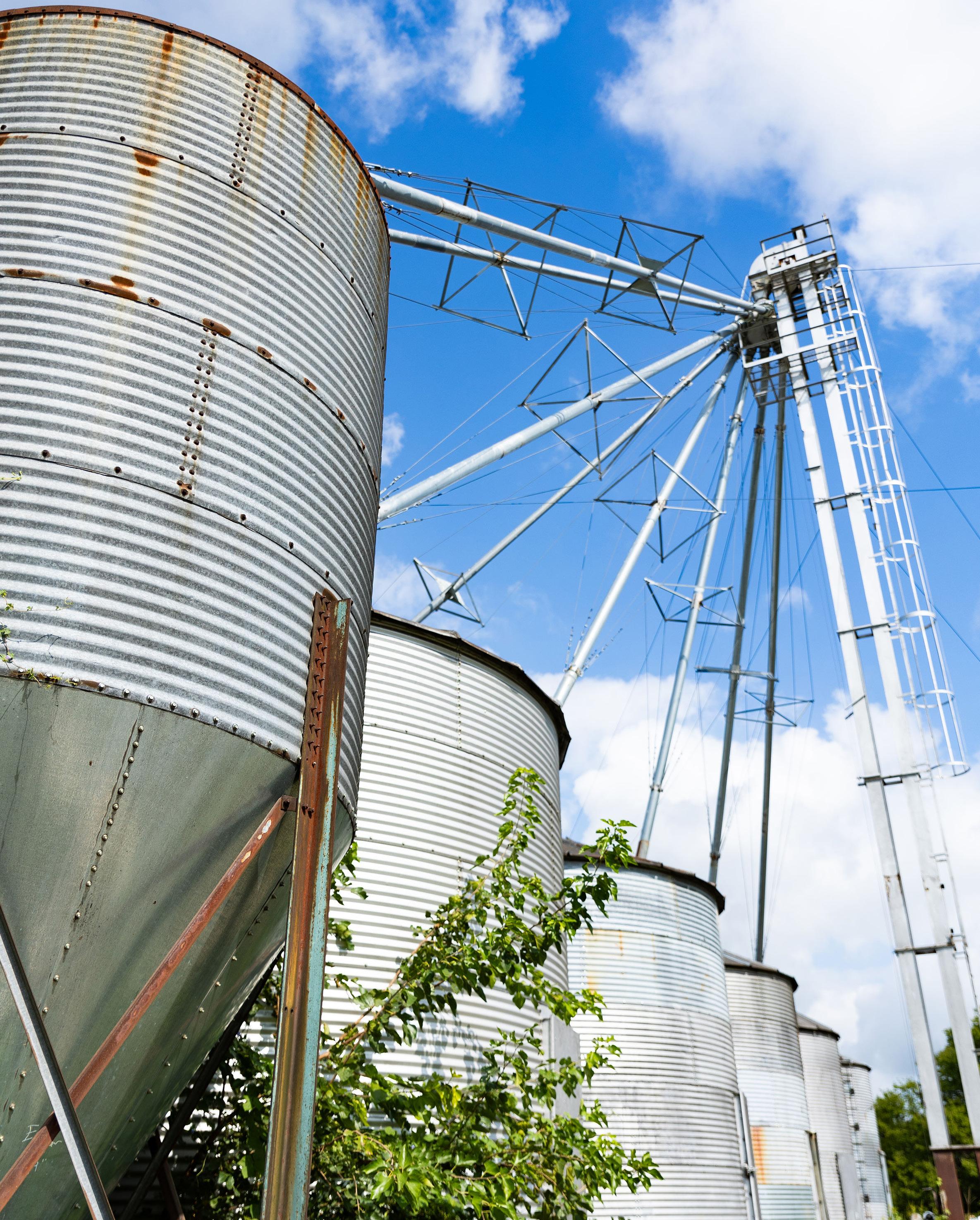 STORY BY JON PAGE | PHOTOGRAPHY BY KATY BIRCKHEAD
STORY BY JON PAGE | PHOTOGRAPHY BY KATY BIRCKHEAD
member spotlight
Name the cliché farm story and there’s a good chance Adam Stumpf lived it during his youth on an eighth-generation family farm in Southern Illinois.
“All the farm stories that you can possibly imagine,” says Stumpf. “Riding on tractors when you were little; learning how to drive things when you’re not even double digits [in age] …”
But it was only after attending college, working a four-year stint with Anheuser Busch InBev and securing an MBA that Stumpf added the most spirited note to the family’s farming story: distilling.
In 2014, Adam and his wife, Laura, mortgaged all of their belongings to co-found Stumpy’s Spirits Distillery in Columbia, Illinois, where they grow, harvest and use nearly all of their own grain to produce award-winning whiskey, vodka and gin. “Our approach is quality into the barrel is going to be quality
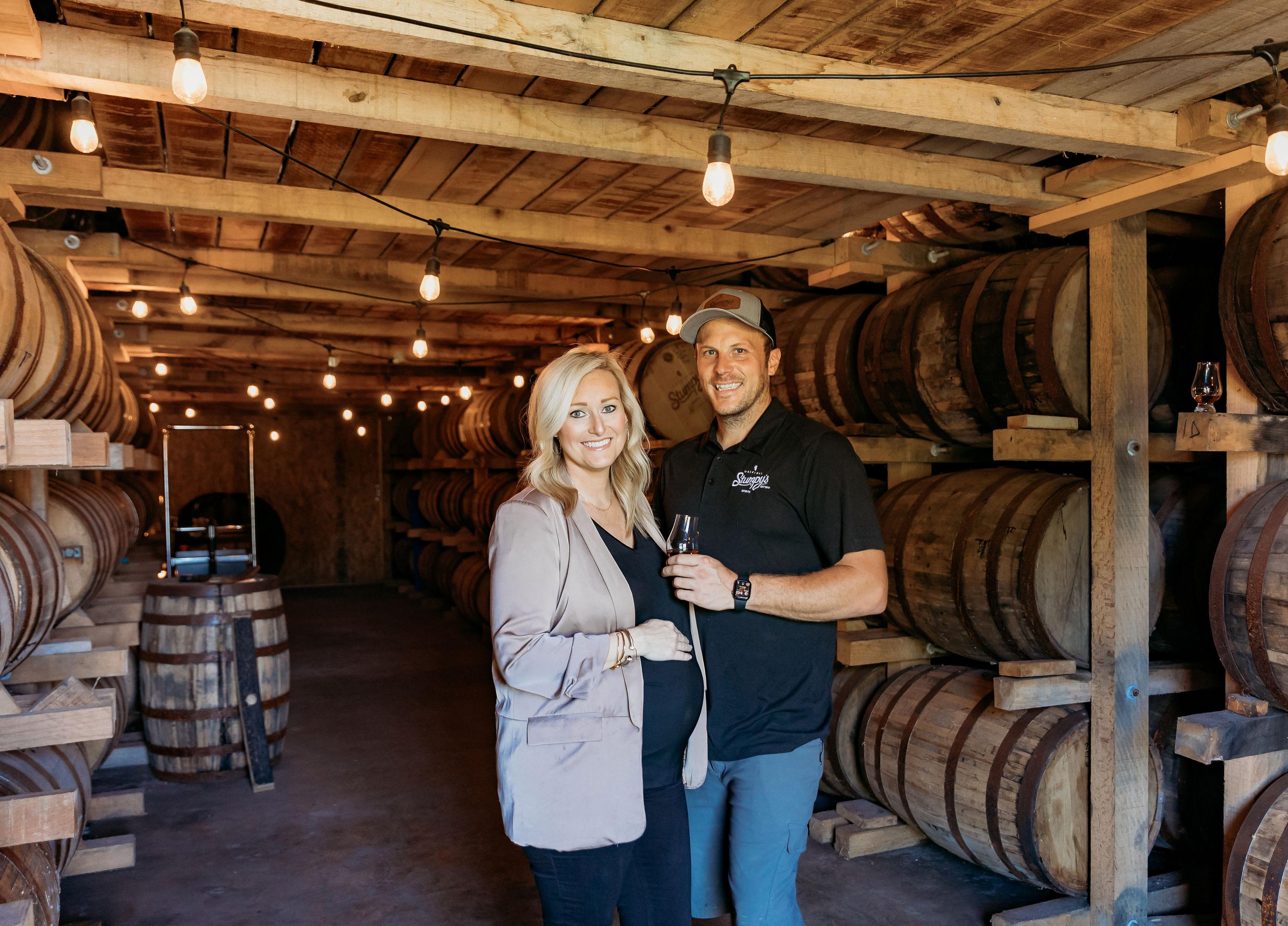
out of the barrel,” says Adam.
The couple met in kindergarten and started dating in eighth grade. Not long after getting married, Adam says he sprung the idea of the distillery on Laura, who was a dental hygienist at the time and says she was initially hesitant. “You’re worried about it, but you’re still like, this was the best decision we made,” says Laura.
Adam says the entrepreneurial bug bit hard when he attended Washington University in St. Louis to get his MBA. It was in a class there that the business plan for Stumpy’s was hatched as a single-source, farm-based distillery. “We kind of decided to take the Napa Valley approach to whiskey at that point,” recalls Adam. “If we’re gonna put this inside a bottle, we are gonna grow every single kernel of grain, corn, wheat, barley, rye—all of it.”
In the beginning, Stumpy’s did grow barley that it shipped out for malting, but
“Our approach is quality into the barrel is going to be quality out of the barrel.”
—Adam Stumpf of Stumpy’s Spirits Distillery
Laura and Adam Stumpf
the scheduling was tedious, the process was expensive, and Adam says the quality fluctuated significantly. Today, the distillery continues to use corn, wheat and rye grown 100% on site.

Those grains shine in the distillery’s flagship Old Monroe line of aged spirits. The name is a nod to the distillery’s location in Monroe County, and a brand of whiskey that was distilled on Columbia’s Main Street from the 1940s to the 60s. Adam says there are currently four main offerings in the Old Monroe lineup. The Small Batch Bourbon Whiskey is 90 proof and is a blend of 10 barrels or less. “With our Small Batch being a blend of 10 barrels or less, we get to experience more flavors from across the rickhouse and really put something unique together with every batch.”
The Old Monroe lineup also features single barrel proof offerings of bourbon, rye and wheat whiskeys, and all of the whiskey is made at the distillery.
“The mash bill that we run is from 1937,” adds Adam, “so it’s got much lower corn content. We only run 60% corn, 25% rye or wheat—depending if it’s a wheated bourbon or not—and then 15% malt. So it’s a lot higher malt and a lot lower corn and more
flavoring grain than the bigger traditional whiskeys of today.”
Laura says that behind its bourbon, the distillery’s second best selling product is its Unbroken Peach Flavored Vodka. The 70-proof spirit is infused with fresh peaches from nearby Eckert’s Orchards.
“We drive Adam’s truck down,” says Laura, “go get fresh peaches and then make a maceration with those, and we use that to flavor our vodka. [We’re] just trying to keep with the local farm aspect of everything.”
The distillery’s 60-proof Old Monroe Pecan Pie Flavored Whiskey is also beloved by locals. “[It’s] the gateway whiskey,” says Laura. “It is a crowd pleaser.”
Adam says that might be because people in Illinois and Missouri enjoy sweet wine. “It’s not Napa Valley,” says Adam, “so there’s certainly a sweeter palate down here. It’s one of those pass-it-around-the-campfire kinds of whiskey. Super easy to drink, nice and flavorful.”
The distillery prides itself on its tours, which offer a comprehensive look at farming, distilling and aging sides of the business. By next fall, the Stumpfs plan to open a new visitor center on the heels of a $10 million expansion. The 25,000-square-foot facility will include a full-service bar, tasting room,
retail area, event venue, patio and more. It will be located about five miles from the distillery, tucked away off a busy highway.
“It’s one of the high points of the county,” says Adam. “It’s a view of beautiful rolling hills. … And then the plan is for a rick house right up there on the highway.”
The distillery is also planning a name change, updates to its branding for Old Monroe and a large expansion in production, which will take Stumpy’s from a capacity of 2,500 barrels per year to 25,000 barrels.

“We started at a barrel a week, so even 10 barrels a day right now is a ton for us relative to where we started,” says Adam. “But then going up to 25,000 a year is pretty crazy to think about.”
But even with plans for growth, the Stumpfs say quality will continue to be at the forefront of their mission.
“This is our passion,” Adam says. “It’s a labor of love, and we have an amazing team in place that can articulate that. It’s always great to hear whenever you have somebody that comes in and says, ‘I’ve done the entire Bourbon Trail and your tour was one of the best, if not the best, compared to any of those down there.’ So if you really want to learn about whiskey, this is the place to come.” ■


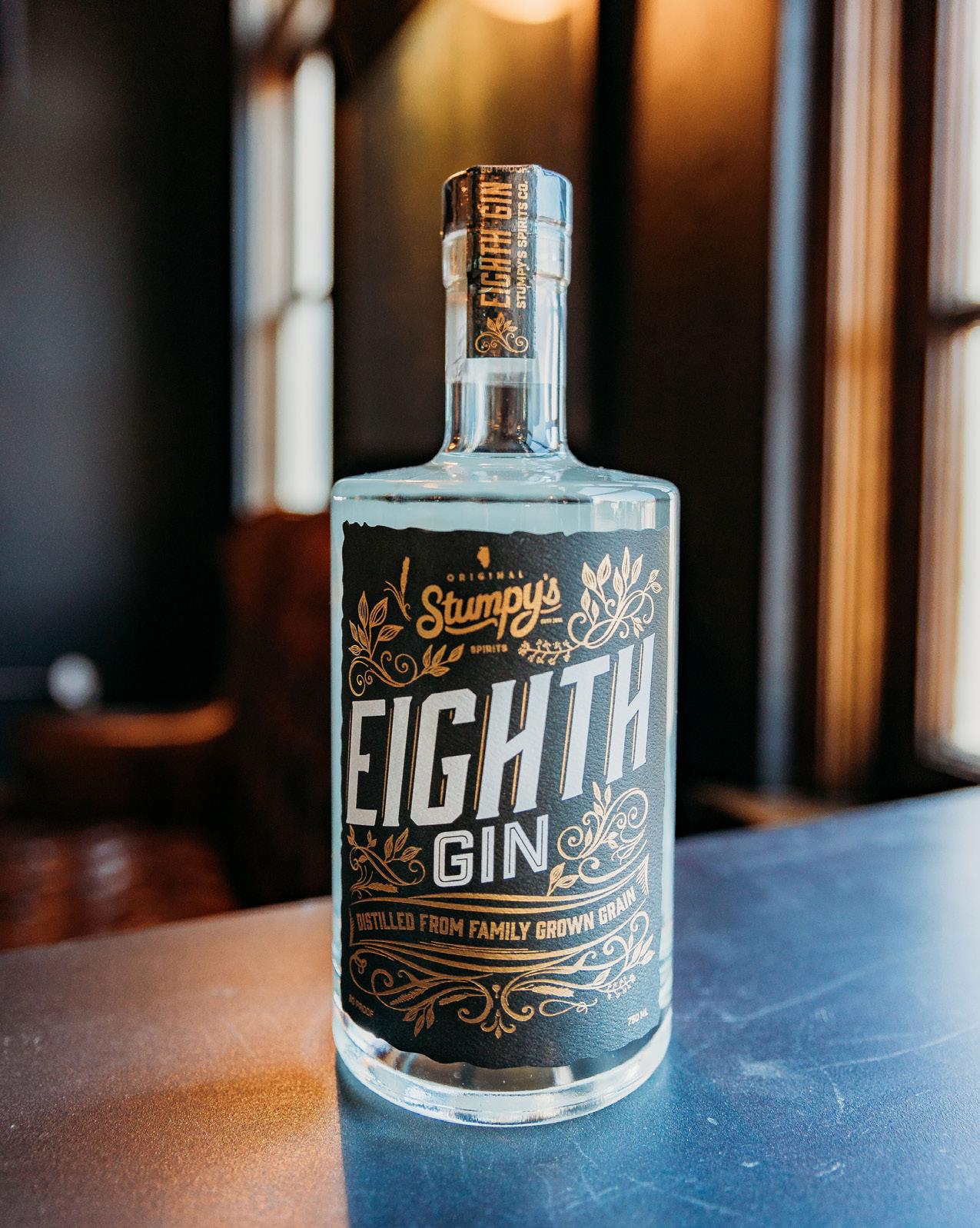

CHICAGO WON’T LET YOU DOWN
BY JOHN HOLL
There are endless reasons to love Chicago. From the architecture to the food scene, the passion of Bears, Cubs and Blackhawks fans, to a lively bar scene. It is also easy to add craft spirits to the list, as the city has blossomed in its production of flavorful, thoughtful and award-winning offerings.

“The Chicago-based craft distilleries are very much a product of Chicago’s strong bar culture,” says Tremain Atkinson, co-founder of Chicago-based CH Distillery. “Chicago bars range from the most divey-est of dive bars to the most revered cocktail meccas in the world. The most successful Chicago craft spirits are inspired by the industry’s diversity of flavors and attitudes.”
The city is also a place of raw innovation, quality and style, says Sonat Birnecker Hart, the president and co-founder of KOVAL Distillery, which was the first distillery to open in Chicago since the 1800s. “In Chicago there remains a keen amount of respect and understanding for the good hard work and craft of a local manufacturer,” says Birnecker Hart, “making it possible for her to bypass the games, and the sleight of hand, to make it on merit.”
The passion that is regularly on display for the hometown teams and the defense against larger metropolises is also alive and well among consumers who have embraced the handful of distilleries that have opened and operated within the city limits.
“I think there’s potential for growth in tourism, but also for locals too,” says Paul Hletko, the founder and distiller of Evanstonbased FEW Spirits. “The importance of ‘embracing local’ is of variable importance to
each distillery and how they want to compete.”
He noted that for FEW, which is an international brand, it’s important to be recognized as the leading Chicago brand, while still being on shelves “everywhere else.”
“For other distilleries that are more focused on sales locally,” adds Hletko, “the potential will be a little different than for us.

It would be criminal to ignore Chicago’s native and most beloved (and reviled0 spirit: Malört. Criminal is also how the wormwood spirit tastes. In September 2018, CH Distillery purchased Carl Jeppson Co. and Jeppson’s Malört and brought production back to Chicago from Florida.
The company says the spirit “has been thought of as a rite of passage or a hangover cure. For many Chicagoans, Malört is a drink that has helped define the Chicago bar experience.”
Chicago is a world-class food city and boasts some of the finest and most creative restaurants in the county, but again and again distillers interviewed for this article kept coming back to the bar culture, as well as package stores, and the importance of being in those social spaces.
The best growth potential for Chicagobased distilleries is to continue to make spirits that meet the needs of the local bar industry, says Atkinson. For distilleries outside of Chicago, hospitality and tourism will continue to be the best source of growth.
“We need to be loved at home, and luckily there is a large market here,” says Collin Moore of Judson & Moore Distillery. “We need locals to come through the tasting room, to ask

CRAFTSPIRITSMAG.COM
From dive bars to fine dining, spirits rooted in the Windy City are winning over locals and bringing in tourists.
distilling destinations
CH Distillery

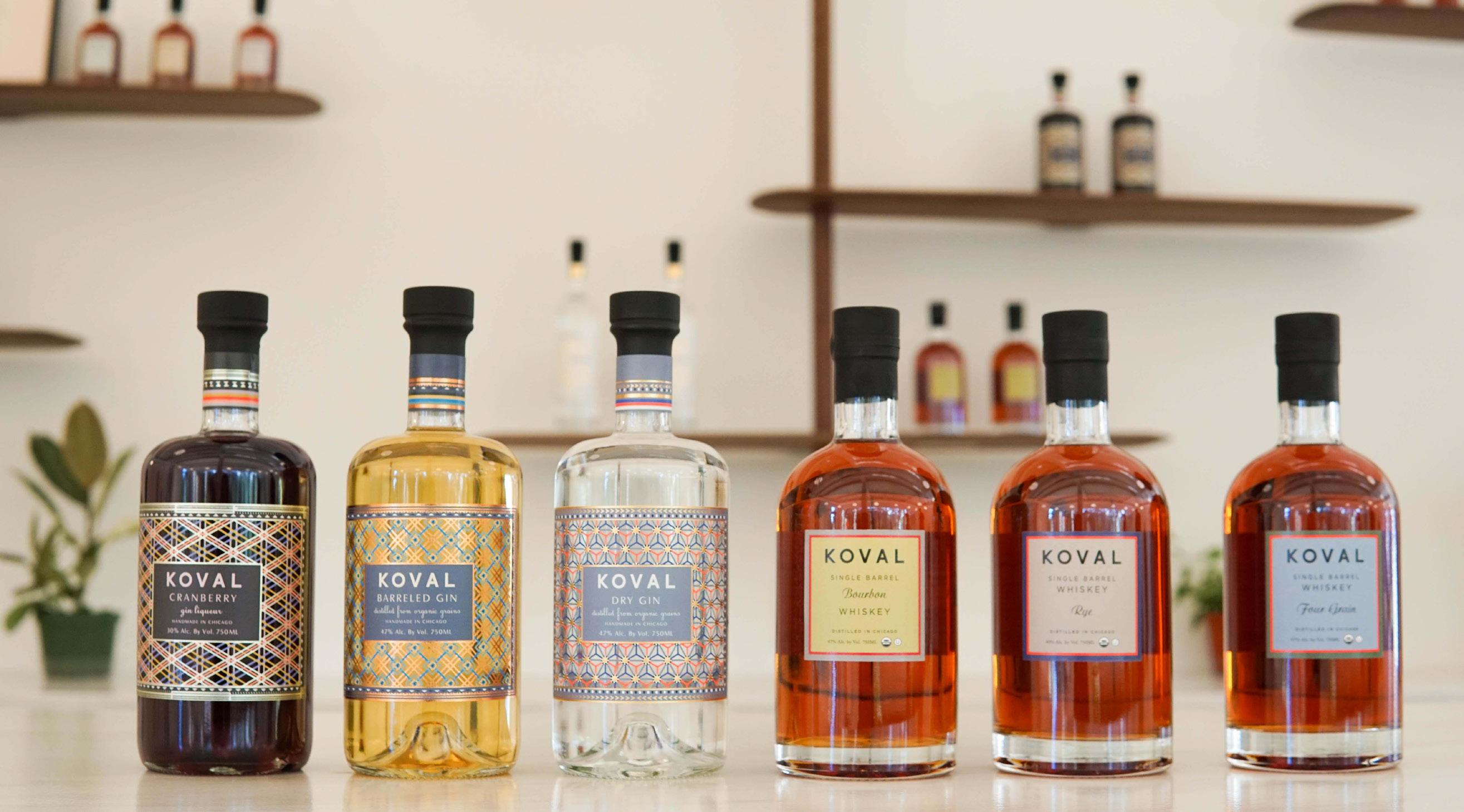
“In Chicago there remains a keen amount of respect and understanding for the good hard work and craft of a local manufacturer, making it possible for her to bypass the games, and the sleight of hand, to make it on merit.”
—Sonat Birnecker Hart of KOVAL Distillery
KOVAL founders Sonat Birnecker Hart and Robert Birnecker

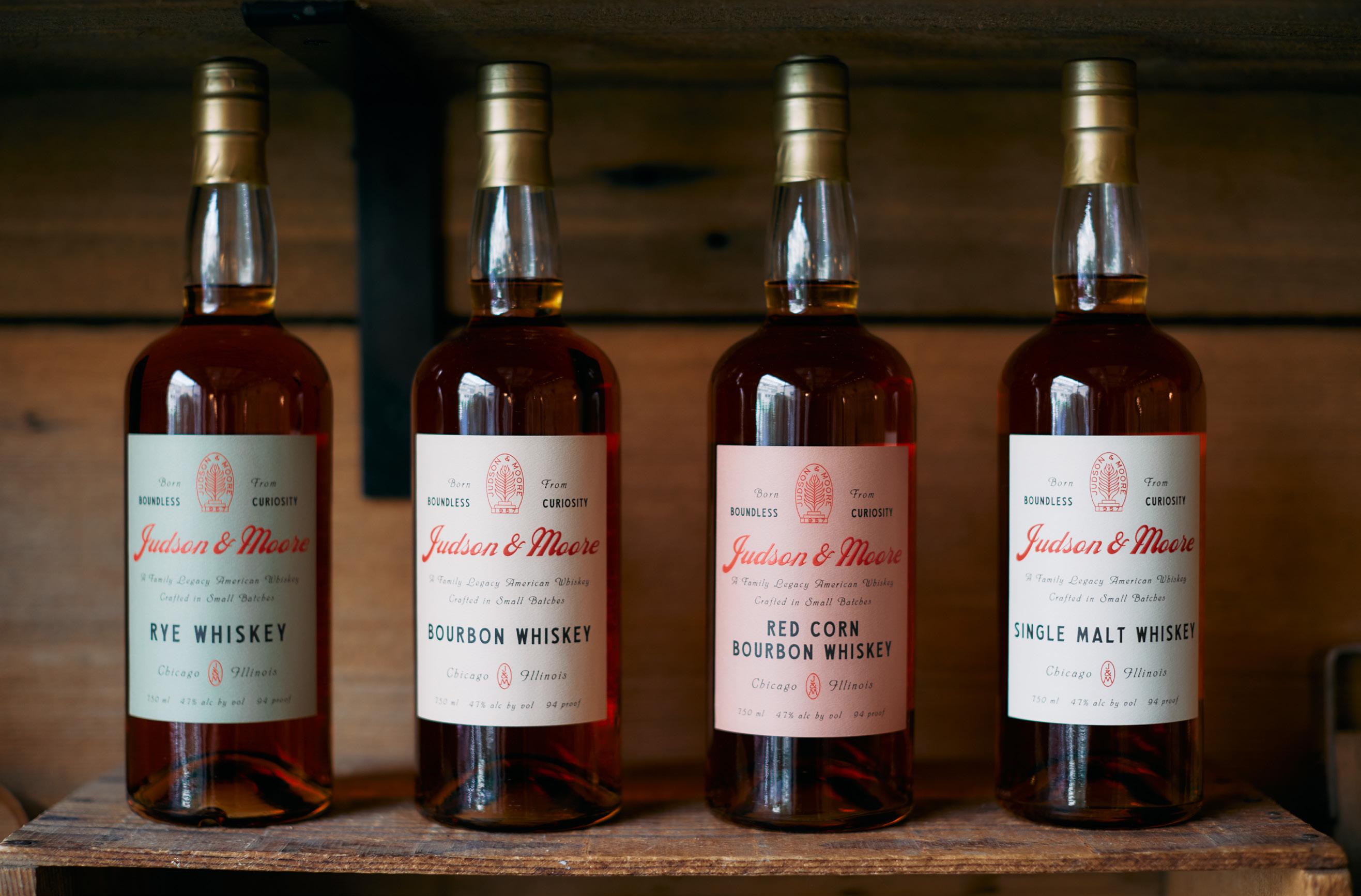
“We need to be loved at home, and luckily there is a large market here.”
—Collin Moore of Judson & Moore Distillery
for J&M at Binny’s, to push their local corner store to pick up the brand. We also need folks from out of town to take word of J&M home and help build more brand awareness and ultimately drive more national growth. People can support a brand that is very Chicago even if Chicago is not home to them.”
Even with its hearty winters, there is never a bad time to visit Chicago. Those who appreciate fine spirits should consider late October of this year and head to the American Craft Spirits Festival at Binny’s Beverage Depot.
Talking with Second City distillers, there is a focus on time, quality and ingredients.
“We are proud of being the only distillery that produces vodka from scratch from Illinois-grown grain—milled, mashed, fermented and distilled in Chicago,” says Atkinson. “We are a company that values our customers, employees and the quality of our products, we do not compromise for any short-term gains.”
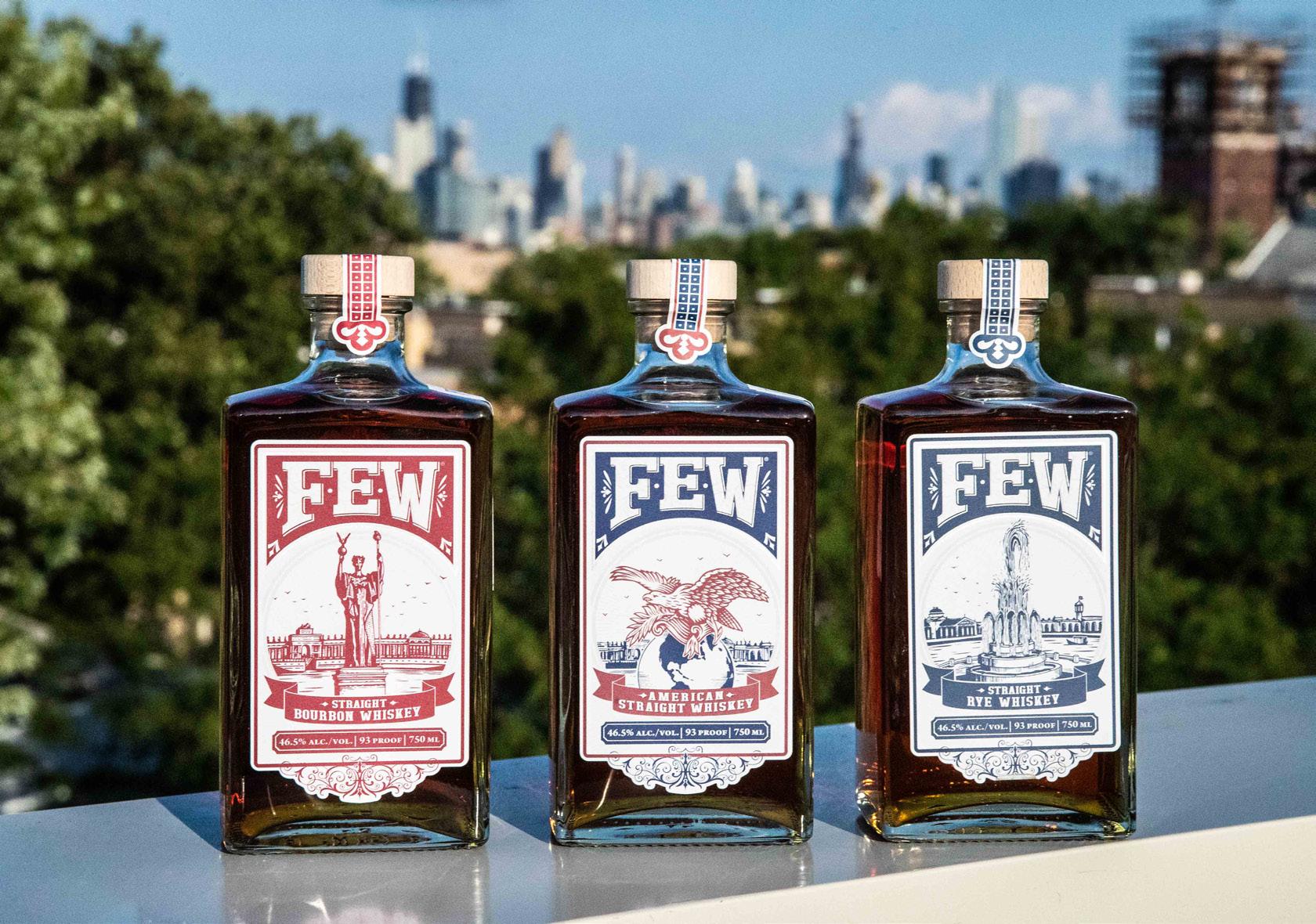
At Judson & Moore, Moore says that barrels filled with their whiskey are already drinking “beyond their years. We’re really excited about where they are at two years and can’t wait to try them at four and six,” he says.
FEW is focusing on innovation, ranging from its “cut” series to what Hletko believes is the largest koji program in North America. At Rhine Hall, a daughter-and-father-owned distillery, the focus is on fruit brandies. Pollyanna Brewing Co., with multiple locations, also features a distillery which is producing aquavit, moonshine, rum, gin, coffee liqueur and more. The Qunincy Street Distillery says it is creating “historicallyinspired, handcrafted artisanal spirits based on classic formulas with unique and distinctive expressions of taste.”
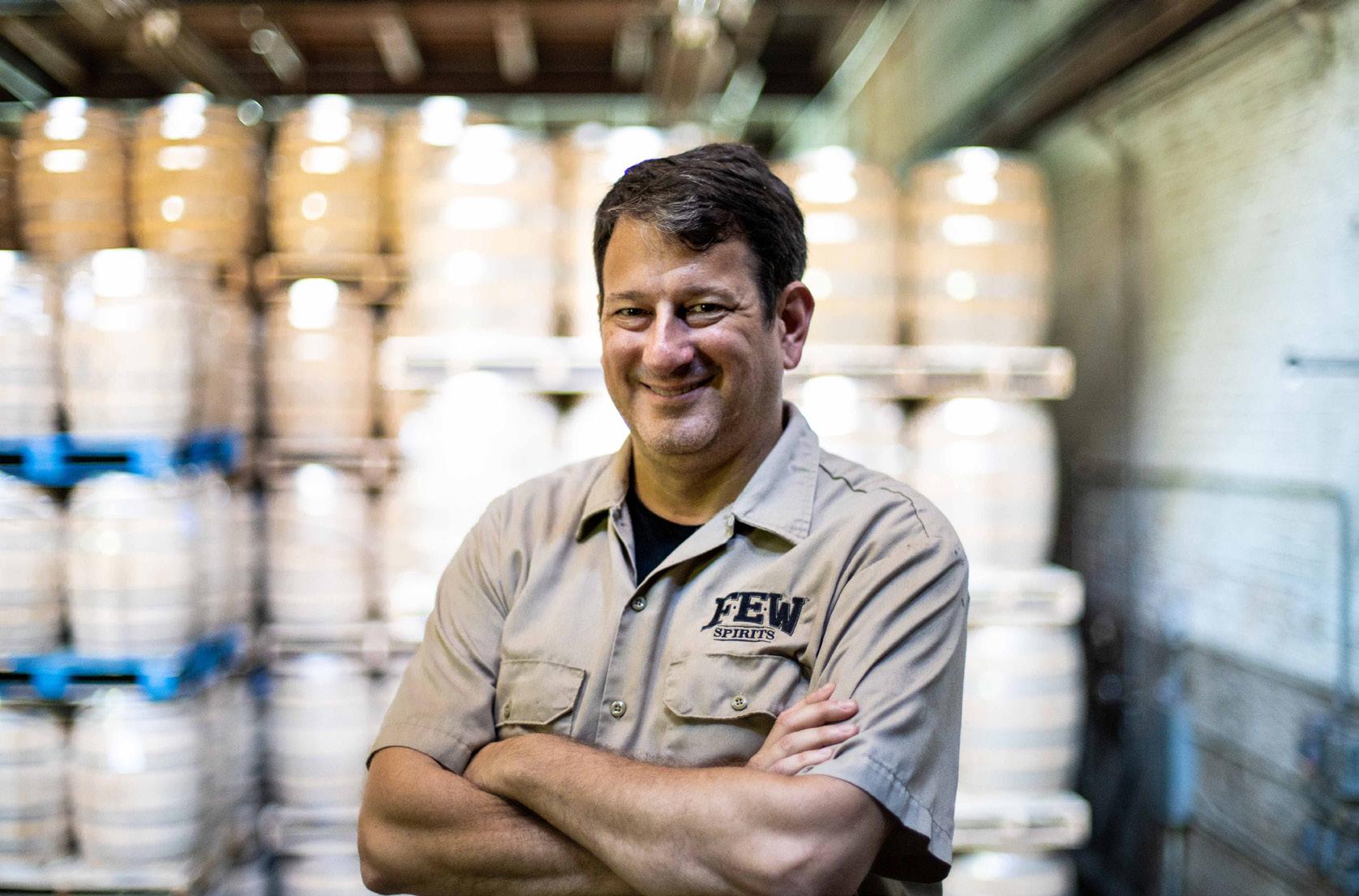
KOVAL, which has helped countless curious distillers-to-be get their footing, has a diverse portfolio that includes a 100% rye-based whiskey, organic and kosher spirits, and products that include alternative grains such as millet and oat, and finishes such as Amburana and maple syrup barrels.
For spirits fans looking for flavor and big-city excitement, it’s hard to find anything better than Chicago. Visiting tasting rooms and experiencing the spirits among the copper and artisans, gives a real sense of place and excitement.
“The local narrative is always going to be at the heart of most brands in their local market because it is something that cannot be faked if one knows how to check,” says Birnecker Hart. ■

CRAFTSPIRITSMAG.COM
Paul Hletko of FEW Spirits
DRINKS TO SAVOR FROM ACSA MEMBERS
Strawberry Eighth Gin Sour

The citrus-forward Eighth Gin from Columbia, Illinois-based Stumpy’s Spirits Distillery is the perfect complement to the fruity taste of this strawberry sour. The aquafaba is an absolute must for creating the most marvelous foam top. All together, this cocktail will leave you with a pop of citrus, botanicals, fruit and silk.
Ingredients
2 ounces Eighth Gin
1 ounce strawberry simple syrup
Fresh squeezed juice from half a lemon
1/2 ounce aquafaba
Strawberry slice to garnish
Instructions
In a shaker with no ice, add Eighth Gin, strawberry simple syrup, lemon juice and aquafaba. Dry shake. Add ice and wet shake. Strain into a coupe glass and garnish with a slice of strawberry and enjoy.
WHAT ’ s Stirring
Old Monroe Bourbon Turtle
This cocktail from Stumpy’s Spirits Distillery in Columbia, Illinois, was inspired by the classic Manhattan utilizing not one, but two of the distillery’s most popular spirits. Together, Old Monroe Bourbon and Pecan Pie Whiskey create the perfect reminder of a turtle candy; pecans, caramel and a hint of chocolate.
Ingredients
1 1/2 ounces Old Monroe Bourbon
1/2 ounce Old Monroe Pecan Pie Whiskey
1/2 ounce creme de cacao
2 dashes chocolate bitters
Caramel sauce and sea salt for rim
Instructions
In a mixing glass with ice, add Old Monroe Bourbon, Old Monroe Pecan Pie Whiskey, creme de Cacao and chocolate bitters. Stir well. To prepare your rocks glass, rim with caramel sauce and sea salt. Strain cocktail from mixing glass into prepared rocks glass and enjoy.
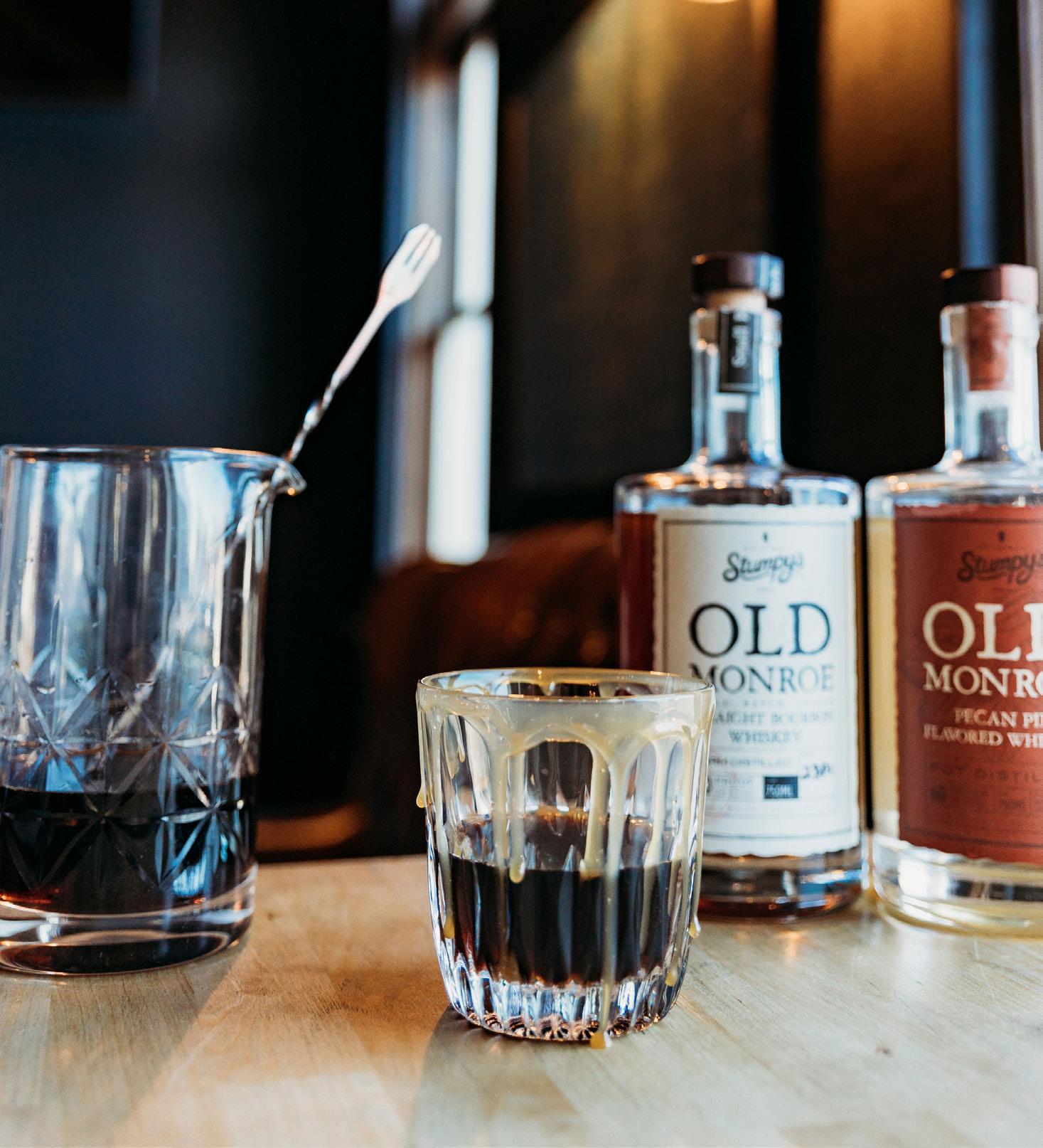
Girl Next Door
The inspiration for this cocktail by Bryan Arri—the owner of Fern Bar in Kansas City, Missouri—comes from his wife’s love of martinis and negronis, and his love of Marthasville, Missouri-based Edelbrand Pure Distiling’s vinars da péra—unaged Bartlett pear brandy. It is something light on the palate, refreshing, and delicate to pair with crisp fall afternoons. This cocktail is the perfect invitation to practice the fine art of lingering with folks you love.
Ingredients
1 1/4 ounces Edelbrand Pure Distilling vinars da péra
1/4 ounce Plymouth Gin
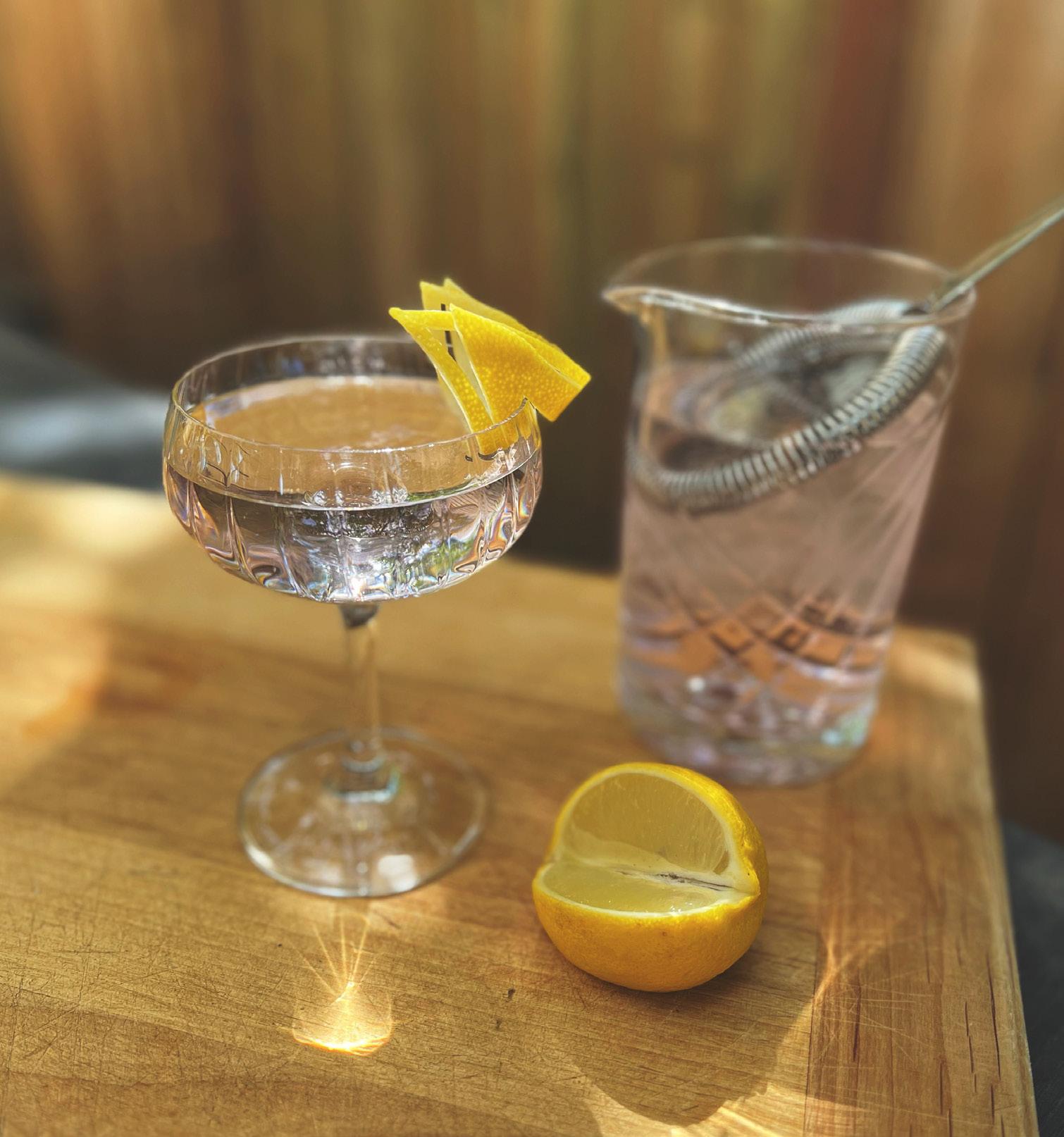
1/4 ounce Luxardo Bitter Bianco
1 ounce Dolin Blanc Vermouth
Directions
Add all ingredients into a mason jar and infuse with the peel of one grapefruit for six hours. Once infused, stir in a mixing glass with ice until cold, and strain into a coupe glass. Garnish with a lemon twist.
Driftless Old Fashioned
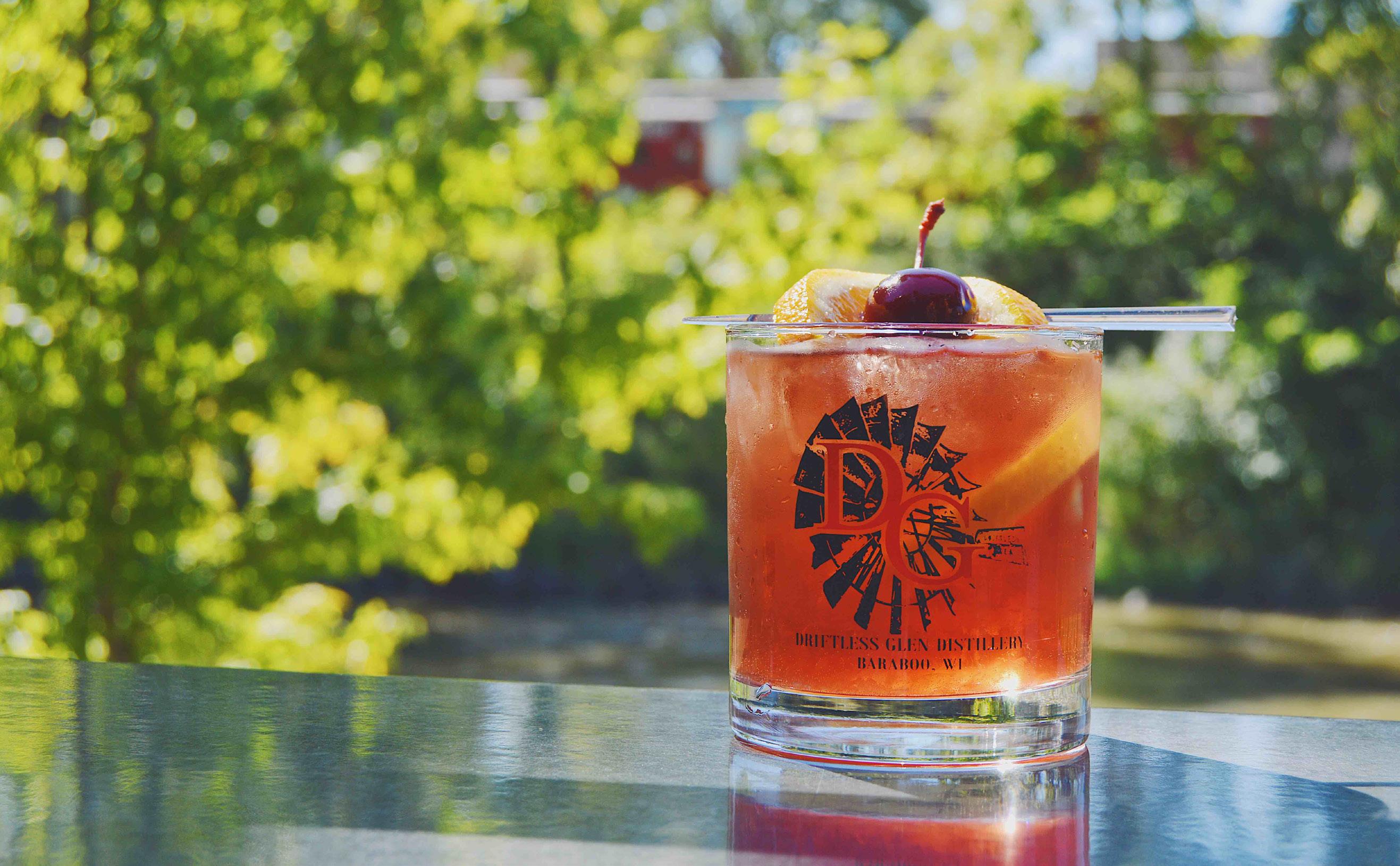
The Driftless Old Fashioned pays homage to the surrounding unglaciated area that Baraboo, Wisconsin-based Driftless Glen Distillery calls home. This twist on the classic cocktail features the distillery’s brandy instead of the typical bourbon but still makes for the perfect sipper.
Ingredients
2 ounces Driftless Glen 5 Year Reserve Brandy
1/2 ounce simple syrup
1/2 ounce cherry juice
1/4 ounce Reneé Black Cherry Balsamic
2 dashes of Fee Brothers Old Fashion
Aromatic Bitters
Sprite or Sour
2 orange slices
1 cherry
Directions
Add the cherry juice, bitters, balsamic, simple syrup and one orange slice into a glass and muddle. Top with ice, brandy and Sprite or sour to taste. Garnish with an orange slice and cherry and enjoy.
Dazed & Infused
This cocktail is a unique riff on the classic French 75 from Pollyanna Social located in Lemont, Illinois. Well rounded with floral and earthy notes, subtle sweetness and a hint of carbonation, this cocktail offers layers of flavor perfect for brunch on the patio or a night out with friends.

Ingredients
2 ounces Pollyanna Corvair Vodka Infused
1/2 ounce lemon juice
1/2 ounce honey syrup
Prosecco
Directions
Shake Infused Vodka, lemon juice abd honey syrup with ice. Strain into a Nick & Nora glass. Top with Prosecco. Garnish with a fresh lemon wheel.
Plum Fairy
This cocktail from Oakland Park, Florida-based ChainBridge Distillery features the distillery’s Plum Brandy. The recipe calls for plum jam, which ChainBridge makes with the same plums used to make the brandy, but you can substitute with your favorite brand.
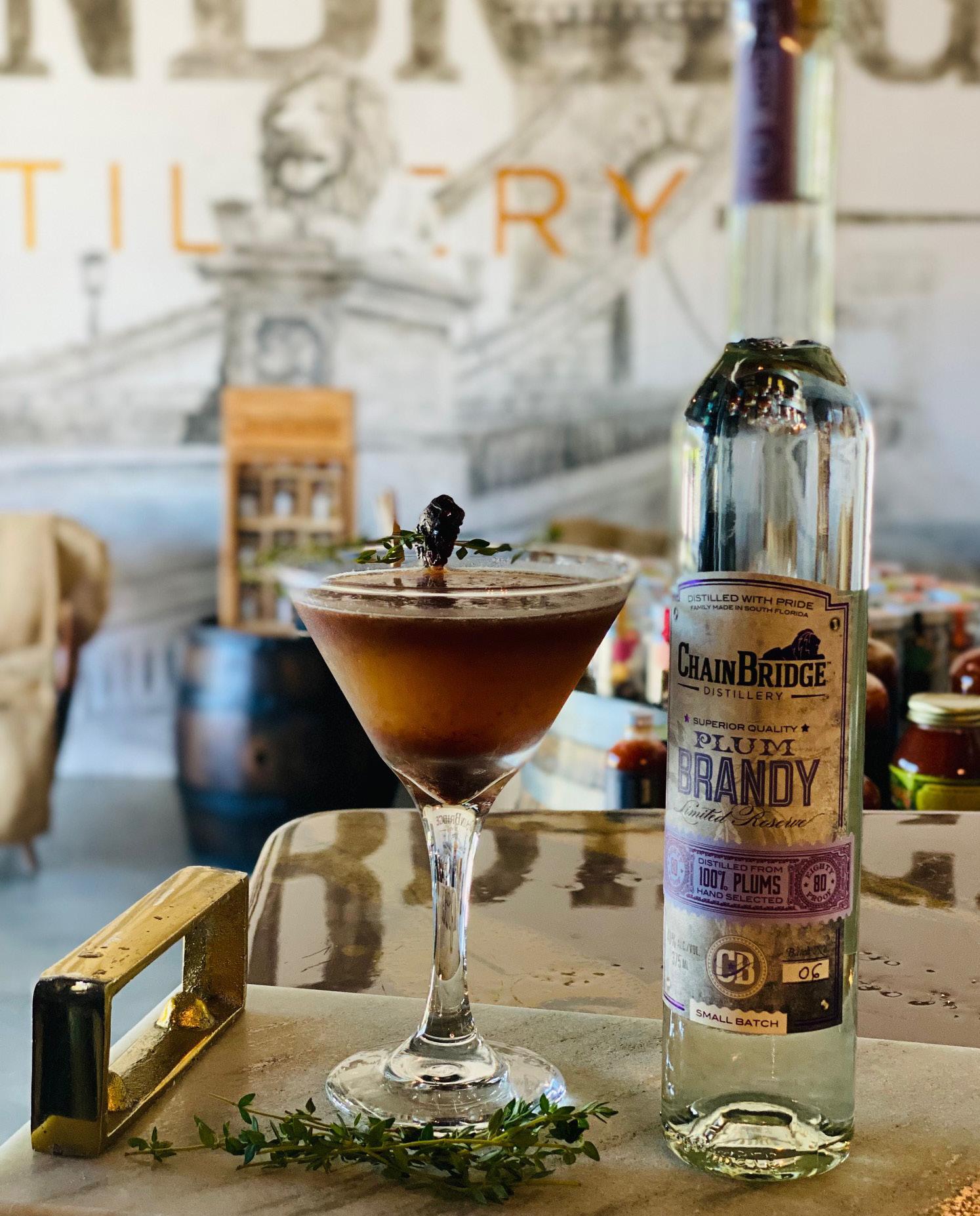
Ingredients
2 ounces ChainBridge Plum Brandy
3/4 ounce fresh lemon juice
1/2 ounce thyme simple syrup
1 bar spoon plum jam
1 1/2 ounces pear juice
Directions
Pour all ingredients into a shaker glass and shake. Strain to a chilled martini glass. Garnish with fresh thyme and prune.
THE WAY TO DISTILL WITH WHEY
The owners of Wisconsin’s Copper Crow Distillery break down the steps to working with the state’s plentiful cheese byproduct.
BY JERRY POLING AND STEVE NOLD
With more than 6,000 dairy farms, 100 cheese factories and the No. 1 national ranking in cheese production, Wisconsin earns its license plate moniker as America’s Dairyland.
As a result, the state also leads the nation in the production of whey, a byproduct of the cheese-making process. When not dried for human consumption, whey often goes into the waste stream or on farmers’ fields as a fertilizer. There’s more than enough to go around.
Whey, however, is a low-cost, organic raw material loaded with energy and possibilities, as the owners of Copper Crow Distillery near Bayfield in northern Wisconsin discovered prior to opening the first distillery in the U.S. owned by Native Americans in 2017. Owners Curt and Linda Basina began looking into whey when Curt, a former State Patrol officer, met master distiller Rusty Figgins at a conference. Figgins suggested they create something with a Wisconsin twist.
Using whey as the foundation for its ethanol, Copper Crow has been making wheybased spirits including vodka, gin, amaretto and aquavit, and growing its sales ever since.
As a relative newcomer to the spirits world, whey remains somewhat shrouded in mystery. What is required to
turn whey into ethanol?
What extra steps are needed?
The Basinas are sharing their process to help expand distilling and sustainable opportunities in other regions where whey is plentiful. According to a calculation by Brian Teague, assistant professor of biology from the University of Wisconsin-Stout, if just 10% of the cheese whey produced in Wisconsin were turned into ethanol, the state would produce about as much ethanol as the entire country does annually.
“My end goal is, let’s share this information to help others do their own scientific experimentation,” Curt says.
FINDING THE WHEY
Turning whey into ethanol begins with a truck. When the distillery needs whey, Curt drives 140 miles from Bayfield to Grantsburg in northwestern Wisconsin to pick up 3,000 liters in large plastic totes from Burnett Dairy, a cheese-maker.
This whey is special. Straight from cheese production, whey has a 5% concentration of lactose, the fermentable sugar. Burnett Dairy whey has been concentrated through reverse osmosis, bringing its lactose concentration to 18-20%, sufficient for cost-effective ethanol production. Before fermentation the Brix is approximately 23.
Insoluble milk proteins have also been removed from the whey through ultrafiltration. Without this step, the suspended milk solids will cook onto the sides of the distillation vat, creating a gummy mess that requires timeconsuming cleaning. Ultrafiltration removes these proteins for a cleaner distillation.
Once back at the distillery, Curt ferments right in the totes. Since bacteria like lactose as much as yeast do, he lowers the pH to around 5.0 using citric acid. This lower pH inhibits the growth of bacteria and their unwanted by-products (think stale milk).
Then, Curt adds an enzyme to break down
the lactose into two simple sugars, glucose and galactose. This enzyme, called lactase (or b-galactosidase) is added at a concentration of 12 milligrams per liter once at the beginning of the fermentation.
Initially, Copper Crow found the enzyme cost-prohibitive but soon learned of other suppliers that brought down the expense.
Having experimented with various yeasts, Copper Crow found that Red Star Distiller’s Active Dry yeast works best with whey. Curt pitches his yeast at a concentration of 200 mg per liter.
Room temperature in Bayfield is cooler than in most parts of the U.S. Ideally, whey ferments best at 86°F, but the lower temperatures in the Copper Crow distillery (more like 64°F) work just fine for making ethanol. After fermentation the brix is approximately 14, with an ABV of 5%.
Fermentation takes a little longer than normal because brewer’s yeast can’t ferment lactose, the main carbohydrate in whey. “The galactose doesn’t like to ferment,” Curt says.
Maybe that’s a good thing, creating a vodka that has a “softness and a sweetness,” adds Curt. “I think it’s because the galactose is not fully fermented. It’s just an amazing vodka.”
The exact process is distinctive to the whey Copper Crow uses. Other distillers likely would have to increase or decrease the enzyme, and the pH level will vary based on where their whey originates, Curt says.
“When you get right down to it, it all depends on the season and what the cows happen to be eating,” Curt says.
STUDENT SUPPORT FROM UW-STOUT
The general process used by Copper Crow was initially developed by Curt with assistance from Rick Erickson, a Bayfield High School science teacher and distilling aficionado. These efforts were supported by
56 | SEPTEMBER/OCTOBER 2023 CRAFTSPIRITSMAG.COM Raw Materials
As a relative newcomer to the spirits world, whey remains somewhat shrouded in mystery.
research at University of Wisconsin-Stout microbiology labs.
Although the Basinas and Erickson had figured out the science behind it, Steve Nold, a microbiologist at UW-Stout (and co-author of this article), set up experiments to test as many variables as possible and make sure nothing was overlooked.
“We needed to find the most efficient means to distill, and Stout was instrumental in helping with that,” Curt said.

“Steve helped to create a legitimate experiment to follow, one variable at a time at how best to produce ethanol from this whey,” Erickson said. “If we’d not had Steve and UW-Stout, we’d still be out there searching. The whole process was exactly how science should work.”
Close to 150 students from a general microbiology course have been involved over several years. They created ethanol samples in the lab, testing a half-dozen yeasts and a similar number of fermentations at different temperatures from 68°F to 113°F; when to add the enzyme; different food-safe acids, with citric working best; lactose concentration experiments, with water-diluted whey producing slightly more ethanol; and various pH ranges, with the yeast performing better at lower levels, Nold and his students determined.
They tried adding nutrients, but “it turned out that simpler was better,” Erickson said. After all the experiments, Curt and Erickson’s original recipe was deemed the best way to make ethanol from cheese whey.
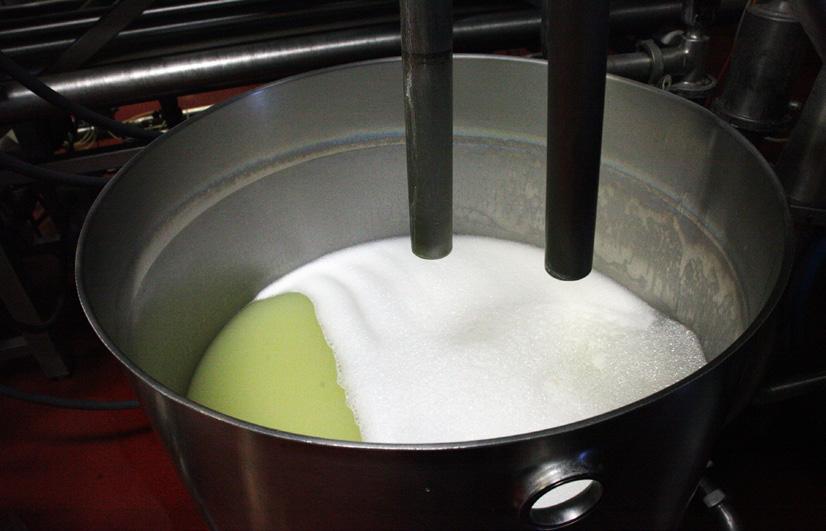
Now, students are working on DNA constructs to create a genetically modified yeast strain that would allow distillers to ferment lactose—and bypass the enzyme pretreatment. Students Myles Chung and Gavin Robinson are working on a study called “Cheesy Booze: A Wisconsin Approach to Genetic Engineering.”
If the research is successful, it could open the doors to using significantly more whey around the country and world. This is Curt’s goal; to improve the environment while creating delicious distilled spirits.
Copper Crow also recently received a $77,000 state Dairy Business Initiative grant to make new spirits. Bayfield County and other areas of Wisconsin are big fruit producers, and Curt plans to use local harvests to make even more products. ■


CRAFTSPIRITSMAG.COM
Jerry Poling is director of communications at UW-Stout in Menomonie, Wis., and Steve Nold is a microbiology professor at UW-Stout.
“My end goal is, let’s share this information to help others do their own scientific experimentation.”
—Curt Basina of Copper Crow Distillery
FROM THE GROUND UP
The founders of pod architecture + design of Chapel Hill, North Carolina, offer key considerations for building a distillery.
BY DOUG PIERSON AND YOUN CHOI
Distilleries are labors of love. They must be. What other reason is there for sane people to take on such a complicated, often frustrating and always expensive enterprise both willfully and cheerfully? Having had the pleasure of working with many intrepid entrepreneurs in the industry, I’m now convinced that a driving passion for the distillery process and product is the key to coping with all the complexity.
In Louisville, Kentucky, Kaveh Zamanian, a
courageous client of ours, decided to leave a successful career as a clinical psychologist and psychoanalyst. His purpose: In the heart of that city’s NuLu district, he would build, own and operate a new 55,000-square-foot bourbon distillery that would “challenge the status quo and offer a new vision of what an authentic whiskey can be.” He calls his decision to abandon an established, lucrative career to risk everything for a dream “diving
down the rabbit hole.” And he named that dream Rabbit Hole Distillery.
Whether you envision a large, urban distillery as Zamanian did, or you’ve got your eye on a 3000-square-foot warehouse circa 1930, know this: The top contributor to the success of the building portion of your future distillery is starting the process as early as possible, beginning with what architects call the Program.

58 | SEPTEMBER/OCTOBER 2023 CRAFTSPIRITSMAG.COM
Business Sense
According to the American Institute of Architects, there are five fundamental design phases of an architect’s services: (1) Schematic Design (2) Design Development, (3) Construction Documents, (4) Bidding and (5) Construction Observation. Some would add Conceptual Design to the top of the list.
The Program precedes the Schematic Design phase when the tools for developing a concept are established. This involves a full understanding of the building’s use requirements, associated spatial needs, and the people, or “users” who will engage with the building. For a distillery, the Program is generally composed of production/ manufacturing; building core elements (stairs, shafts, utilities); transitional spaces (lobbies, corridors); bathrooms; service spaces; hospitality spaces (examples: event/reception spaces, a tasting room and/or a public bar); and the size expectations for all the above. Distillery “users” are: the owner(s); the distillery workers and master distiller (at one of our craft distillery projects, the owner is also the master distiller); the distillery’s executive and support staff members; the janitorial staff; at many distilleries, tour guides and the tour-goers themselves; and also at many new distilleries, the tasting lounge and/or cocktail bar servers, retail staff, and marketing and sales teams.


An experienced architect is uniquely qualified to help you establish your program and stay true to your budget allocations later.
An architect knows that what may seem insignificant to the point of ignoring it now—a utility closet or a tote storage room, for example—will impact your plan later if it’s not recognized in your program. It’s always better to be over-conscious of details than the opposite.

CRAFTSPIRITSMAG.COM
An architect’s experience in designing and completing distillery projects should be a key factor in your decision to hire one architect over another, but not the only factor.
With a fully realized program in hand, you will be ready to determine your actual square footage needs (vs. initial “guesstimates”) and start projecting costs based on market values.
Another vital aspect to consider at the beginning of the project is how your site will serve the manufacturing and distribution process. Distilleries are logistics-oriented enterprises. The moment a truckload of grain arrives on the property while another truck backs into a loading dock, logistics are in play. Make sure inbound and outbound freight and their loading docks are accounted for as site development gets underway.
What about ample space on site for the outdoor-process equipment—the silos, stillage tanks, water tanks, etc.? Will your site accommodate all of them? If you’re not sure, consult your architect.
Another crucial exterior component is the main entrance. No matter what size, your distillery’s physical structure speaks volumes about your brand and is as important to your distillery’s identity, marketing-wise,
as the product(s) you produce. Talk with your architect about creating a unique main entrance that commands immediate attention in an intriguing and tasteful way. Idea: You may want to bring in a graphics/experiential designer who can perform the work alongside (or by) your architect to integrate your logo into the design of the main entrance. At Rabbit Hole Distillery, a pod a+d designed lenticular front entrance sign was integrated into the building’s structural steel, tying together identity, building, process, all in one design gesture. At Widow Jane Distillery in Brooklyn, New York, the unique heirloom corn used in each batch influenced the pod a+d’s design of color and pattern in the distillery. Because distilleries are complex buildings, a strong argument for an all-new, fromthe-ground-up structure is that it lets your architect address the building’s form, footprint, and floorplan to meet your programmatic needs. At Rabbit Hole Distillery, we took full advantage of that concept by amending the “form follows function” edict
to “form follows process.” The structure took shape in direct response to the bourbon production process, showcasing the journey from grain to bottle as well as the physical beauty of the 48-foot-tall copper still and the gleaming steel equipment.

BUILDING A DISTILLERY IN AN EXISTING SPACE
Nothing is “greener” than giving an existing building new life with a new purpose—known as adaptive reuse.
If you share our enthusiasm, please take our advice: If you want to turn an old building into your new distillery with all the necessary equipment, you must take the time to understand what can and cannot be adaptively reused within that specific building. To do that, you’ll need the invaluable assistance of a structural engineer.
Along with the exposed brick walls, heavy vertical timber, and other elements from the past that intrigue us in older urban structures, existing buildings come with their
60 | SEPTEMBER/OCTOBER 2023 CRAFTSPIRITSMAG.COM
own orders and idiosyncrasies, which may require you to adjust your thinking. The very place where you’ve been thinking of locating heavy equipment may not be adequate. The solution: With a structural engineer’s help, you can establish certain areas as “heavy” vs. “light” and consolidate the retrofitting into specific zones. The result is a newer, safer method for organizing your distillery.
A client of ours found a brick, circa 1930 industrial building in downtown Durham, North Carolina, in which to establish her new craft distillery. She fell so deeply in love with the building, in fact, that she asked us to touch the original surfaces as lightly as possible. Yet the program called for dividing the open interior between the distillery in the back portion and a public cocktail bar with tasting room in the front. Our solution: a custom-designed, multi-functional “furniture bar” that defines her new cocktail bar, accommodates a host of other needs, and provides a state-mandated physical separation between customers in the bar and the working distillery—all with little to no impact on the original walls or floors.

BASIC FACTORS TO CONSIDER WHEN WORKING WITH OR SELECTING AN ARCHITECT
An architect’s experience in designing and completing distillery projects should be a key factor in your decision to hire one architect over another, but not the only factor. For example, over the course of several early discussions, your architect should be able to discern a sense of place unique to your distillery. But along with that qualification, a distillery architect should demonstrate deep knowledge of the product (bourbon, for example); the equipment needed to manufacture, bottle and distribute that product; and the spatial needs that the specialized equipment requires.
You’ll also want to know the architect’s fee structure, stylistic leanings (modernist? traditionalist?) and communication preferences (email vs. phone calls, for example). You should also make sure you’re on the same page concerning deliverables expectations. Ultimately, however, you’re probably going to hire the architect whose previous work you admire; who listens to you and offers excellent ideas; who seems to truly care about the outcome of your project; and who strikes you as someone with whom you’ll enjoy collaborating for a long time.
Remember: With distilleries, the time between your initial conversations (concept) and grand opening (completion) can seem

interminable. A good working relationship is vital.
Another key consideration: How does the architectural candidate work with a process engineer?
Process engineering is the branch of engineering concerned with industrial processes, especially continuous ones such as manufacturing of distilled products. The design phase is a very collaborative effort among the owner, architect, and process engineer. Process planning starts early. Architectural candidates must demonstrate that they can establish process goals and guidelines.
COMMON MISTAKES IN PLANNING A FACILITY
1. Holding off on safety issues and critical equipment and processing decisions—a common mistake. Process engineering is a unique consultant group in that they are not part of the typical building engineer package of civil, structure, mechanical, electrical, plumbing. The process engineer works with the owner and architect to develop the allimportant (and secret) P&ID (piping and instrumentation diagram), but this is only the beginning. They share in the safety design approach for explosion proofing, dust hazard mitigation and aggressive ethanol exhaust evaluations. And, since they liaise directly with the equipment manufacturer and rely on them for their documentation, their deliverable documents are not complete until they have coordinated with the manufacturer’s shop drawings, which require owner fabrication contracts in advance. So, the process engineer needs to be fully engaged with the architect to ensure coordination occurs prior to these late arrival documents. Limiting or waiting too long on any of these important process engineering steps can result in costly delays and possible re-engineering and design.
2. Underestimating the value of the construction administration phase. Construction administration is a series of administrative tasks performed by an architect to help oversee the construction phase of a project. As the construction administrator, the architect liaises with the general contractor to facilitate the timely execution of every stage of construction and every detail involved, and ensures construction follows the design direction provided in the project documents. Often, mistakes arise when craft distillery owners assume the role of the construction administrator. The follow-through in con-
struction is a key element to realizing a successful project, and it is best achieved with the group responsible for coordinating the project documents. Though the architect’s CA fee is not insubstantial, this soft cost is always less than the unforeseen hard costs of construction and schedule changes when the architect is not part of this key phase.
3. Schedule time for your projects big picture design intent. With any project, including spirits distilleries, it’s easy to lose sight of the forest for the trees. To avoid such mental confusion, think of a main idea that aligns with your project vision.
Then continue to ask yourself throughout the design process if your directions match your main idea. If they don’t, it might be a good idea to pause, redirect or even alter your main idea. The result can be a sense of order that permeates through the cloud of complexity and turns a good distillery into a great one.
Allow your vision, and the architect’s design, to percolate throughout the project duration. There may be myriad tasks to complete, but remember, your labor of love will be all the better for doing so. ■
CRAFTSPIRITSMAG.COM SEPTEMBER/OCTOBER 2023 | 61
It’s always better to be overconscious of details than the opposite.
THE SOPs OF OND
Distillers and distributors share advice on navigating the months of October, November and December.
BY JOHN HOLL
The holidays seem to come earlier every year and as producers and retailers seek to make the most out of consumer spending, focusing on the months of October, November and December (OND) is seen as critical to success.
“For me, it’s actually SOND, because we start in September. The last quarter of the year is where everyone becomes profitable, hopefully,” says Cheryl Murphy Durzy, the founder and CEO of LibDib, a wholesale distribution company. “This time of year is do or die in terms of being a profitable supplier.”
Durzy says this sales season is about both on- and off-premise and more and more about online sales. While much of the focus will start with Halloween and then lead into Thanksgiving—and of course Christmas, Hanukkah and New Year’s Eve—there are endless opportunities for purchases and being in front of consumers for all occasions will boost the bottom line.

As craft distilleries continue to grow in the
marketplace and look for ways to connect with customers, this season of giving and receiving is crucial for long-term success and industry veterans are well aware of its importance.
Scott Blackwell, the founder and co-owner of High Wire Distilling in Charleston, South Carolina, says the OND period is a chance to connect with consumers who have the holidays on the mind.
“It’s also a time when people are back in their routines after summer vacations are over and schools are back in swing,” he notes. “We start earlier and earlier planning for all of our fall releases. This year we started in January so that we could have necessary packaging, marketing materials and registrations done in time for selling season. We start earlier and earlier planning for all of our fall releases. So start early and while the previous fall is still fresh in your mind.”
For Richard Patrick, the co-founder of Cathead Distillery in Jackson, Mississippi, the importance of OND cannot be overstated as it usually represents a quarter of the distillery’s business. Still, there is often a balancing act and to be ready for changing conditions.
“There’s never a perfect crystal ball on forecasting; however we try to have all standard programming completed before the start of a new year,” he says. “Inventory and strength of supply chain have always been very important. We make sure to have enough padding in our inventory and finished goods in an effort to prevent against the unexpected.”
So, for newer distilleries who are still balancing all of the machinations that come with running a small business and often find themselves looking just week to week, when is the ideal time to start thinking about the final three months of the year?
“Planning for OND should begin at least six months in advance, ideally in April or May. This is when we start to look at our inventory, identify any gaps, and plan our production schedules to meet the increased demand,” says Renee Bemis of Driftless Glen Distillery in Baraboo, Wisconsin. “For newer distilleries, my
advice would be to start planning as early as possible to avoid any last-minute surprises.”
Bemis says that based on previous experiences, Driftless Glen Distillery realized that maintaining a close relationship with its distributors and retailers was crucial for success.
“By keeping them informed about our
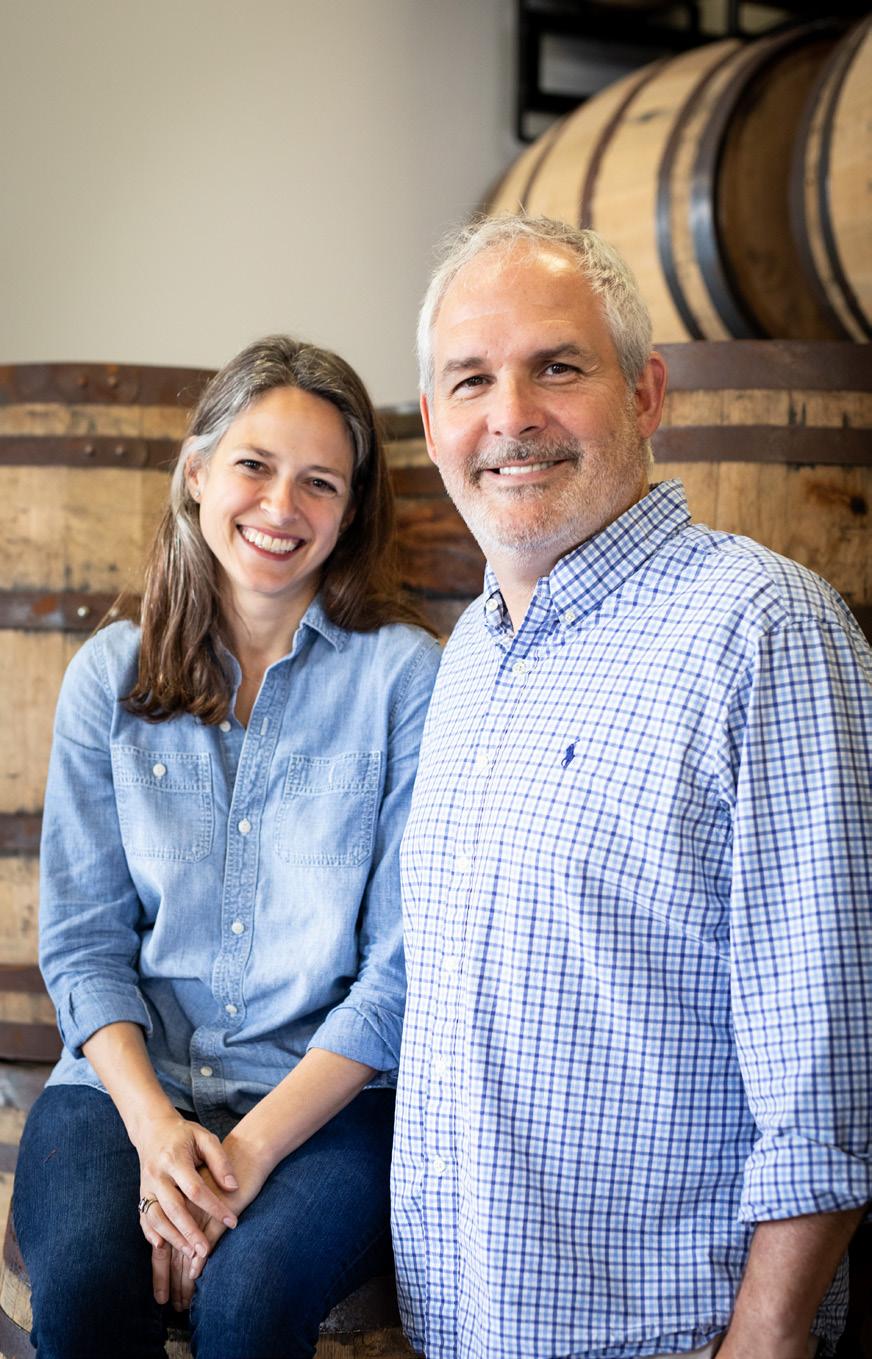
Distribution & Logistics
“We start earlier and earlier planning for all of our fall releases. So start early and while the previous fall is still fresh in your mind.”
—Scott Blackwell of High Wire Distilling
John Oliver of Breakthru Beverage
Ann Marshall and Scott Blackwell
program schedule, inventory levels, and any potential new products or incentives, we’ve been able to ensure a smooth flow of products during the high-demand OND season,” she says. “Additionally, we are keen on staying up-to-date with industry trends to ensure that our brand remains relevant in the market.”
John Oliver, the national trade marketing director for Breakthru Beverage Group’s Trident Division agrees with that point.
“There always should be room for chasing trends,” he says. “We try to stay ahead of them. We have a key group of blogs and newsletters that we look at. We have local bartenders in network that stay in touch with what’s pulsing, and we’re attending a lot of different conventions to understand what’s going on and then translating that to suppliers.”
Trend chasing cannot be done overnight, he says. A lot happens six months out from the OND season and often the focus has to be hyper local.
He suggests that emerging brands go “deep, not wide. … That’s how we get a lot of learnings on how the brand is connecting with consumers in a market and suppliers understand how to build a brand in a market. Then little by little you can add resources in that market, like ambassadors or a dedicated person.”
That approach isn’t necessarily best during the thick of OND, he says. Emerging brands really have to get the basics right first. That means being in the right accounts and having core consumers. Then activating the brand with samplings and demonstrations.
“Nothing over the top that would require more resources,” Oliver says. “Focus on driving the basic blocking and tackling.”
While larger retailers are looking for inventory months in advance there are some benefits for the smallest of distilleries, says Durzy. “If you’re looking at big, giant volume, those decisions were made months ago. But if you’re small, and want to put together a threebottle gift pack and have 50 of them, you can do that.”
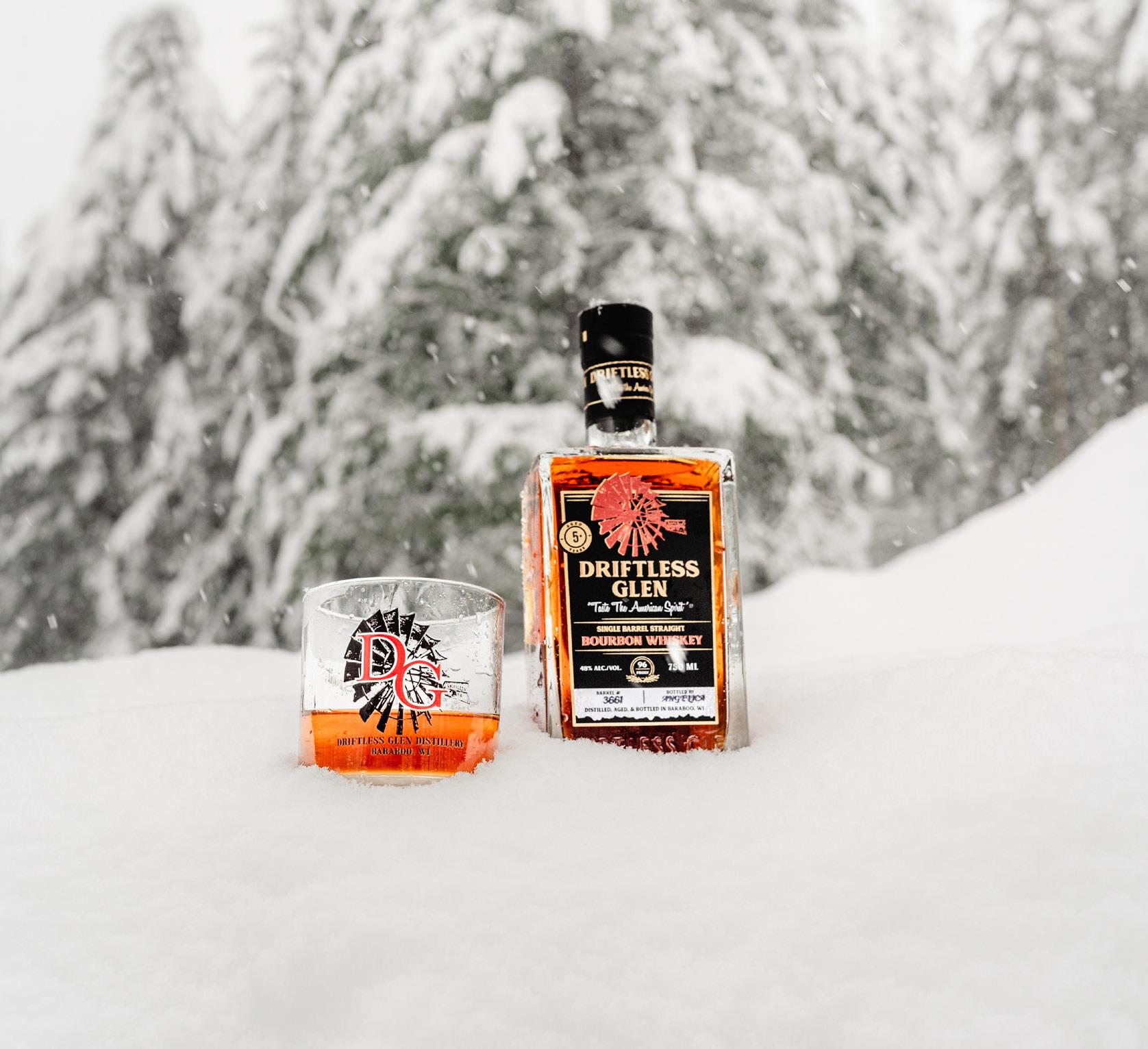

Remember that there is a lot of competition and a lot of sellers trying to get in with buyers. It can be difficult to get retail placement, but Durzy encourages friendly persistence and a human touch.
“Even if something doesn’t come through right now, we always tell people it’s just a good time to reach out, not necessarily to sell something but to check in and say hello,” she says. “And maybe you’ll be top of mind for later.” ■
CRAFTSPIRITSMAG.COM
“For newer distilleries, my advice would be to start planning as early as possible to avoid any last-minute surprises.”
—Renee Bemis of Driftless Glen Distillery
SOCIAL MEDIA FOOTPRINTS
Where are you leading the government and others?
BY TERI QUIMBY
It’s going to happen. With our phones attached to our hands and head, we now live in an Instagram, Facebook, Twitter, LinkedIn kind of world. Something may be posted on social media, by you or others, that impacts your business—either positively or negatively. And unlike footprints in the sand that wash away with the tide, digital ones are traceable and here to stay. Maybe forever. We already know that employers, both public and private, have used online searches as informal background checking tools for a while now. Social media has permanently changed the information landscape.
A post may be a quick, inexpensive way to promote your brand or business. Or it could work against you, triggering a possible inquiry
or violation from a government agency. It’s never been easier for regulators and others to look for public information. Within seconds, a post or comment can travel around the world, becoming publicly available. If you don’t communicate your own business story, someone else will provide a version of it. So, what story do others read from your digital footprint?
GOVERNMENT & OTHERS LOOK AT SOCIAL MEDIA POSTS
News reports confirm this. According to FedScoop, in 2022, the FBI purchased 5,000 licenses for a social media platform allowing deep searches. Now you might be thinking that it’s unlikely the FBI will focus on your craft distillery or spend valuable employee
time and effort that could be used elsewhere. And you might be right. But that’s not the point here. Technology innovation brings new tools to enable public sourced searches, including searches by location. The fast finding of information by government agencies is happening. With text analytic tools, it’s happening with fewer people needed to cover the ground of millions or more social media posts.
Colleges and universities provide another example of social media monitoring. Public posts by students are monitored to help maintain safe communities. While this activity is carried out to watch for warning signs about self-harm with hopes of timely intervention, there are other issues involving health, safety and welfare that can easily fall

64 | SEPTEMBER/OCTOBER 2023 CRAFTSPIRITSMAG.COM
legal corner
under the “safe communities” objective such as alcohol beverages.
For other reasons, such as possible Federal Trade Commission alcohol advertising and marketing violations, various interest groups monitor posts. Alcohol “ads” on social media became a newsworthy discussion topic a few years ago when DJ Khaled’s activity was highlighted. Being one of social media’s most famous influencers, his posts about alcohol beverages didn’t appear to disclose whether they were paid advertisements. Moreover, minors made up much of his following. Who is watching? Maybe minors, but interest groups are too. This case became a concerted effort between Mothers Against Drunk Driving (MADD) and Truth in Advertising (TINA). It started as a general look into advertising practices, with the alcohol posts quickly coming into view by these groups.
Also, public health interest groups have noted remarkable findings about advertising to minors in the beer industry. While that industry’s voluntary code prohibits content appealing to youth, beer brands preferred by that age group are accused of being the “most egregious violators” of the code, according to a report by Boston University School of Public Health. Researchers explored the relationship between popular youth brands and the content of ads by those brands, finding a closely linked relationship. It’s notable that this research, using a systematic study approach, purports to be the first investigation to do so. And it’s not likely going to be the last one.
Whether it’s traditional ads like television or print, or posts on social media, information is abundant and publicly available to research and review. Given that the government is looking at it, as well as interest groups, it’s a wise decision to spend adequate time planning posts and monitoring user-based comments and content. Doing this with intention assists with voluntary code compliance and mandatory regulatory compliance. Just like writing a book takes time and effort, so does telling an accurate story about your business on social media. Considering how your digital dialogue will affect or engage minors, for example, is a subject area worth spending time on. Being able to demonstrate your due diligence in decision-making for the critical industry issues associated with alcohol beverages is part of your business story. While the use of social media platforms for advertising and marketing is exciting on one hand, it can also have other consequences.
TRACKING SOCIAL MEDIA USE BY MINORS
As you can see from the influencer example, it is very important to know who your audience is. Alcohol marketing to minors is obviously prohibited for public policy reasons involving health, safety and welfare. Keeping track of trends for media choices seems never-ending with the ever-changing channels of communication. For teens, YouTube ranked highest followed by TikTok in a recent research survey. The results continue with Instagram next, then Snapchat, Facebook, Twitter, Twitch, WhatsApp, Reddit and Tumblr. Perhaps due to the race to keep up with the latest and greatest social media choices, teens now use Facebook less, causing it to fall in this teen survey ranking.
ACSA’S CODE OF RESPONSIBLE PRACTICES
Guidelines for advertising and marketing alcohol are established by the industry as well as the government. Whether found on social media or elsewhere, association codes are significant. Last adopted by the ACSA Board of Directors in 2022, its Code for Craft Spirits Advertising and Marketing is applicable to all members. Activities for craft distilled spirits advertising and marketing are subject to it, with complaints handled by the Code Review Panel. ACSA publishes any decisions or actions by this Panel on its website. Further, this code incorporates the ACSA Responsible Digital Marketing Guidelines adopted in 2021. With the constant evolution of digital communications, ACSA sets forth principles for members.
If you have questions, the ACSA Code Review Panel accepts inquiries. You may find that taking the extra step to make an inquiry is worth the time and effort. Further, this may persuade regulators that you tried to do the right thing, especially in those ever-increasing gray areas of regulatory uncertainty.
MAKE SURE TTB LIKES WHAT YOU “LIKE”
What to post, and where, is very much an intentional business decision to make. Placement and marketing decisions are guided in part by population data. Prevention of marketing to minors is a concerted industry effort. The adult demographic placement standard is frequently updated in industry advertising and marketing codes of conduct to reflect new information. The American Craft Spirits Association, the Distilled Spirits Council of the United States and other industry members have these types of codes. When new U.S. Census data is released, the age 21 and over population percentage is adjusted in the codes. For example, the 2020 data showed 73.8 percent of the population is “of age.” In the alcohol beverage industry, this type of information is useful for projecting the advertising and marketing reach for the appropriate age groups. It’s worth the extra time and effort to focus on those consumers who can legally buy and drink products with alcohol. Another chapter to write in your business story is about the steps taken to understand and comply with the ACSA Code.
Yes, you can get in trouble for “liking” something. The U.S. Alcohol and Tobacco Tax and Trade Bureau (TTB) Industry Circular (2022-2) makes that clear. Prohibited practice provisions include an industry member either reposting or liking advertising content created by another party. It’s important to remember that on social media, both member- and user-created content can find its way into unlikely audience feeds, providing food for TTB’s thoughts. If it ends up on, is connected to, or shows up in the feed of followers for an industry member’s social media page, TTB may consider it advertising. Also, anything posted to an industry member’s page or site, or to a third-party site, is considered advertising. All these things are subject to prohibited practices provisions.
The ongoing birth of new social media channels has paved the way for the evolution of creative connections and interactions not previously possible in advertising and marketing. For example, a print ad could be seen but not really generate user engagement and excite others to comment or reshare everywhere. This extended chain of distribution can easily be attributed back to an industry member if prohibited practices are involved. Again, be cautious and aware of the story you are creating for your business; TTB and others
CRAFTSPIRITSMAG.COM SEPTEMBER/OCTOBER 2023 | 65
Considering how your digital dialogue will affect or engage minors, for example, is a subject area worth spending time on.
will be reading it.
The usual advertising concerns remain in social media, like providing consumers with adequate and accurate information on the advertised product, identifying the person responsible for the ad, disclosing alcohol content for spirits (and neutral spirits if used). The Circular is clear that it isn’t just the obvious modes, like LinkedIn or Facebook, that are included in TTB’s review. Media sharing sites, blogs, crowdfunding sites, comment sections and even mobile device apps can create concerns over content creation and sharing.
Suggestions by TTB include the following if social media outlets are involved:
TTB considers the entire home page or site as a single advertisement. This is a good thing because mandatory statements by advertisers only need to appear once on the site or page.
Mandatory statements, though, need to be placed where consumers are likely to see them. TTB suggests that information sections for “profile” or “about” is a good place for statements, since consumers would reasonably expect to find information there.
Providing links to mandatory information is allowed. If space is restricted by the platform, then direct links to the information can be used. This option, however, cannot get around the need for certain statements directly on the ad, such as composition (“product, with natural flavors”) to prevent misleading statements to consumers.
Mobile versions of websites also need to comply with advertising regulations. While mobile sites may display differently, compliance concerns still exist.
Posts by others may be considered advertisements. This is especially true with influencers on social media, although others could also post something rising to the level of an advertisement, which requires mandatory statements.
TTB is generally very accessible, as seen from the availability of employees, to interact with licensees and potential licensees at the agency and industry events. If you typically walk by and pass up these opportunities for TTB interaction, think about stopping and talking next time! TTB’s Market Compliance Office is also there to answer questions. As social media modes continue to evolve, TTB’s review over these potential public advertising areas can be expected to increase. New options almost seem endless for consumers to engage with advertising, marketing and other social media content.
COMMENTS POSTED BY PUBLIC: HELPFUL OR HURTFUL?
Certainly, good reviews and customer testimonials about products and services can help build brands. Showcasing great customer experiences is a key component of success. But in the alcohol industry, public comments can also create havoc.
What may start out as a post providing photos of fun at licensed establishments, or comments about businesses or events, can quickly change into areas of concern for government agencies or others viewing publicly available social media content. Without context, these posts or comments may appear to include activity out of regulatory bounds. Like the saying goes, a picture is worth a thousand words—or more. Trying to explain why something isn’t really the way the post appears can be a difficult task; it burdens a business with defending its practices. It’s a chapter best left out of the business book that others read. Again, others will tell your story if you aren’t carefully cultivating it yourself. Letting the social media comment garden grow on its own can turn into an unattended patch of unwanted weeds. As the ACSA Code discusses, it is important to monitor and moderate membercontrolled platforms, and to quickly address inappropriate user-generated content.
Social media is a business tool that needs to be used carefully and intentionally. With the intertwining of advertising and marketing on social media platforms, great responsibility falls on alcohol licensees to comply with laws and regulations. As members of the alcohol beverage industry, craft spirits distillers also have guidance to consider with trade practice codes of conduct. The use of social media is proactive, requiring diligence with monitoring content generated, reposted, and commented on. ■
66 | SEPTEMBER/OCTOBER 2023 CRAFTSPIRITSMAG.COM
Social media is a business tool that needs to be used carefully and intentionally. With the intertwining of advertising and marketing on social media platforms, great responsibility falls on alcohol licensees to comply with laws and regulations.


THERE IS STRENGTH IN MEMBERS The American Craft Spirits Association (ACSA) is the only national association of craft distillers created and governed by craft distillers. We Are Craft! Our mission is to elevate and advocate for the community of craft spirits producers. WHY JOIN? • Build long-term relationships and enhance industry connections • Help cultivate a competitive landscape for craft distillers • Learn from industry thought leaders • Increase market access TAKE ADVANTAGE OF MEMBERSHIP ONLY OPPORTUNITIES BY JOINING TODAY! A: P.O. Box 470, Oakton, VA, 22124 E: membership@americancraftspirits.org W: americancraftspirits.org
THE E-COMMERCE ECOSYSTEM
A Bar Convent Brooklyn panel ponders the digital marketing landscape.
BY JEFF CIOLETTI
There are a lot of moving pieces in the rapidly evolving e-commerce realm, so it’s key to take a multi-disciplinary approach to understanding it and optimizing any opportunities that it may present. Park Street provided just that with the multi-faceted lineup for a panel at this year’s Bar Convent Brooklyn.
“Cracking the Code: Adapting with E-commerce,” part of the Park Street University track, featured a slate of experts offering insights on the tech, marketing and compliance sides of the online sales landscape, to help the beverage alcohol industry audience make sense of this new-ish frontier. Here are some of the key takeaways from the session:
THE DTC MARKET IS SURGING
Ryan Malkin of Malkin Law noted that the overall beverage alcohol direct to consumer (DtC) revenue is estimated at $17 billion for 2023 and is expected to reach $20.4 billion by 2027.
But, as we all know, spirits’ ability to benefit from what Malkin called “pure DtC” is very limited. “Pure DtC is the supplier selling directly to the consumer,” Malkin noted. “By and large, spirits don’t do that because of the laws. Pure DtC is what you might think of as [what] a Napa winery is doing.”
He also distinguished between “shipping” and “delivery,” two terms that are sometimes incorrectly used interchangeably. “Think of shipping as FedEx, UPS, whereas you’re going to think of a retailer taking it that last mile,” he said. Most online ordering platforms create the perception that they’re the ones fulfilling the order and executing its delivery, but they’re really working through wholesaler and retailer partners.
“Here’s [the platform’s] retail partner in New York,” Malkin explained. “Then you tell the wholesaler, ‘sell XYZ to the retailer, in this amount of product.’ … The way that it works is you feel like you’re buying from the brand, but you’re not because you can’t.”
DIGITAL MARKETING IS ABOUT CLOSED LOOPS AND THE NUMBER SEVEN
So, now that the basics are out of the way, it’s time to talk marketing.
“There’s not really any such thing as an e-commerce marketing strategy,” revealed Kiowa Bryan, on-trade and marketing director for Caribbean rum company Spiribam. “Every single one of those platforms that you use work together.”
She also touted the rule of seven.
“There are seven touch points of the
customer,” Bryan noted. “Someone needs to see your brand seven times before they make the purchase. Have as many opportunities to see your product.”
Marketing across digital platforms needs to be consistent. For one of Spiribam’s own brands, Rhum Clement, the marketers use one hero image across platforms.
“Yes, of course, on social media, you want to mix things up and have a variety,” she said. “But store displays, e-marketing newsletter, etc., use the same image. Find that image that really identifies with your brand and reuse that image and rewrite the copy. When your brand is new, when your spirit is new, they will see that image and every ad and it will really resonate.”
With digital marketing, she added, brands have the opportunity to analyze data, determine how consumers are behaving and tweak the campaign as necessary.

And then there’s the notion of “closed-loop” marketing.
“Nothing is linear in marketing, everything is connected,” Bryan explained. “It’s not point A to point B. Your sales team and marketing team work together, it’s not marketing that makes sales happen, it all works in a circle. You need to talk about that in your marketing
68 | SEPTEMBER/OCTOBER 2023 CRAFTSPIRITSMAG.COM
Technology & E - Commerce
strategy so you never have any loose ends.”
Everything in social media and all of your digital channels needs to lead back to your website or online store.
Video, she pointed out, will get a brand more marketing play. “Even a two-second video will get you more bang for your buck than still images,” she said.
Social platforms come and go—the importance of marketing on Facebook has diminished and the site formerly known as Twitter is barely functional these days—but one digital element that has remained constant is email marketing. “Email is not really going anywhere,” she said.
IT’S ALSO ABOUT EXPERIENCES
One area where beverage alcohol marketers have been slow to adapt has been in relation to a major shift in consumer behavior, particularly since the pandemic. Josh Jacobs, CEO of alcohol e-commerce and fulfillment platform Speakeasy, reported that 59% of consumers are drinking more at home now than they were pre-pandemic. And only 5% more are drinking in bars and restaurants. In addition, 40% of elder millennials are drinking more at home and spending more on beverage alcohol than boomers. They feel as though they can treat themselves after surviving a pandemic. “When we’re talking about premiumization, it’s not just price of product or how long in barrel,” Jacobs said. “Consumers, young consumers in particular, they crave an experience.”
Those trends all have coalesced and the question spirits producers should be asking themselves is “how do we make the at-home experience next-level?”
E-commerce, Jacobs said, presents an unparalleled opportunity to deliver on that while
employing three strategies:
• Unique and exclusive product bundles— enabling the consumer to access products that aren’t available at their local liquor store—perhaps with a special, online-exclusive package—while bundling them together with swag like a branded hat, for example. Brands also can craft experiences around special occasions, like their consumers’ birthdays.
Jacobs pointed to a premium that Villa One Tequila developed for its fans: a bundle that included a guitar signed by brand founders Nick Jonas and John Varvatos.
“It has to be authentic,” Jacobs advised.
• Collaborations with influencers and other brands—“They’re particularly appealing because they present an opportunity to tap into an existing audience,” Jacobs said. “You can do so incredibly quickly and move the needle overnight.” Knobel Tennessee Whiskey, for example, teamed with Mike Rowe of “Dirty Jobs” fame and sold out of their limited-edition collaboration whiskey in eight days.
“Influencers are certainly all the rage right now, but it’s not all about influencers,” Jacobs added. “Who sells brands all day, every day? Other brands.”
Eastside Distilling in Portland, Oregon, partnered with Frito-Lay on a Lays potato chip-branded vodka, for instance.
• Limited time Offers—“It’s about creating scarcity and capitalizing on impulsivity,” Jacobs noted.
DON’T FORGET ABOUT B2B E-COMMERCE
Up to this point, the panel had been speaking primarily about B2C. Equally important is B2B e-commerce. According to a study by McKinsey & Company, B2B e-commerce will

likely reach one-third of all sales. “Most B2B businesses follow the rule of thirds and our industry is on the same track,” said Michael Boswell, VP of digital and e-commerce at Breakthru Beverage. “That’s billions and billions and billions of dollars of growth.”
If a producer isn’t thinking about its B2B strategy, it could be missing out on its share of those billions.
Boswell promoted Breakthru Now, the mega-distributor’s proprietary, “immersive e-commerce platform to help manage your business anytime, anywhere.”
“B2B experiences should be relevant,” Boswell said. “If you’re a bar, it should be showing you the leaders and the highest-selling products. Then, it should be personalized to each customer … if you’re a craft spirits account, you’re going to see a lot more craft spirits in your search … you should be tailoring the content.”
The first phase of e-commerce, Boswell noted, was about getting products out the door. “Now, what it’s becoming, is how do we make it easier for the customer to purchase. We want to get them in, create an account, find what they’re looking for and then get out and get moving with the rest of their day.”
While they’re there, the buyers are going to respond to high-quality content. In addition to bottle shots, brands should be providing lifestyle and other engaging images. “Make sure you have content promoting your brand [and] hand-send it in big bunches every time you update your content.”
Every order a sales rep has to punch in takes about five minutes, Boswell noted. “Just based on that five minutes,” he said, “we’ve saved 26,000 hours, which means more time to sell your brands.” ■
CRAFTSPIRITSMAG.COM SEPTEMBER/OCTOBER 2023 | 69
“There’s not really any such thing as an e-commerce marketing strategy. Every single one of those platforms that you use work together.”
—Kiowa Bryan of Spiribam
Park Street’s Emily Pennington, Malkin Law’s Ryan Malkin, Speakeasy’s Josh Jacobs, Spiribam’s Kiowa Bryan and Breakthru Beverage’s Michael Boswell
TOTC ’23
New Orleans was once the place to be in late July when Tales of the Cocktail returned for its 21st edition. The event featured nearly five days packed with education sessions, spirits tastings, Spirited Dinners, and, of course, parties.

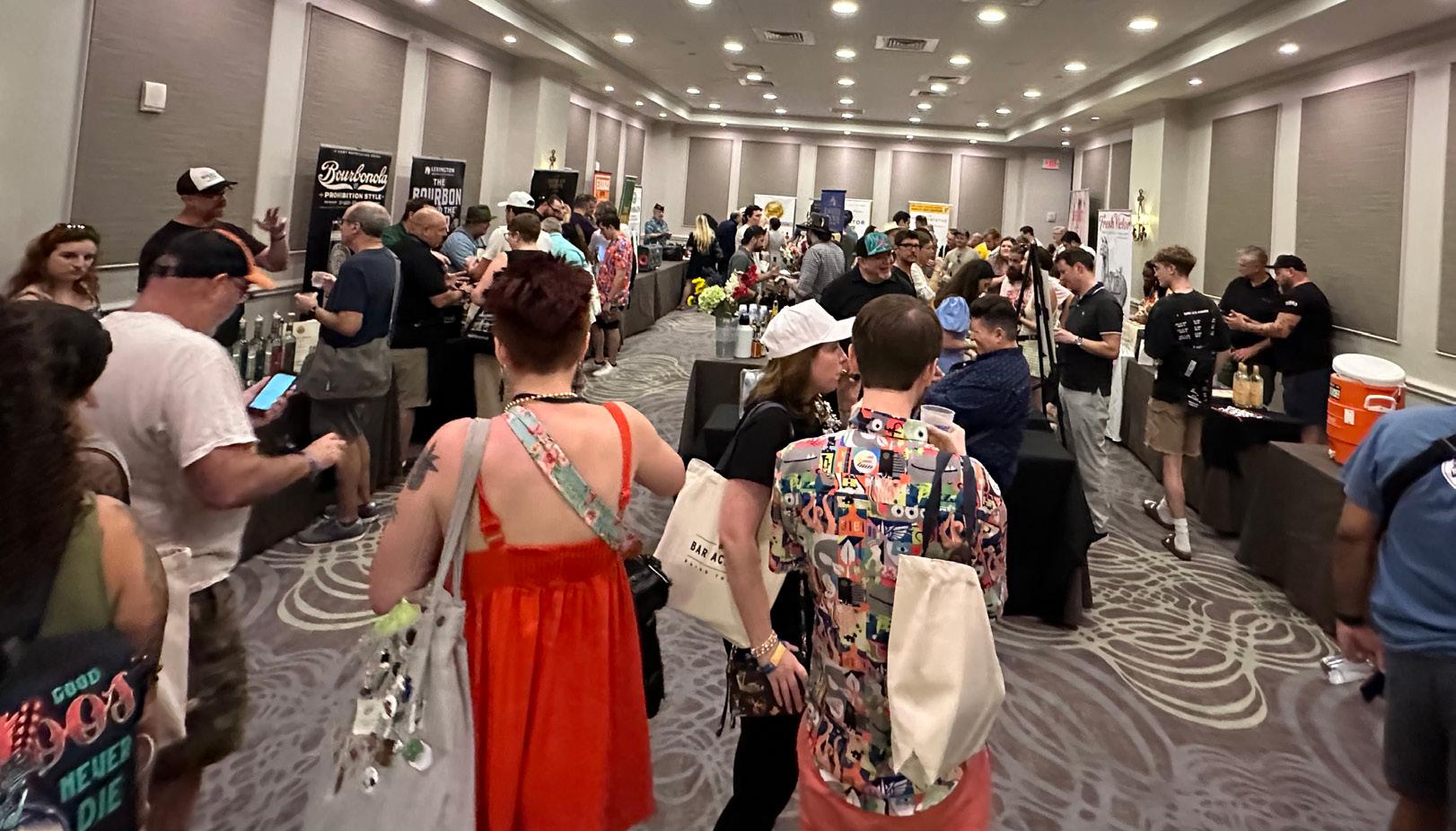


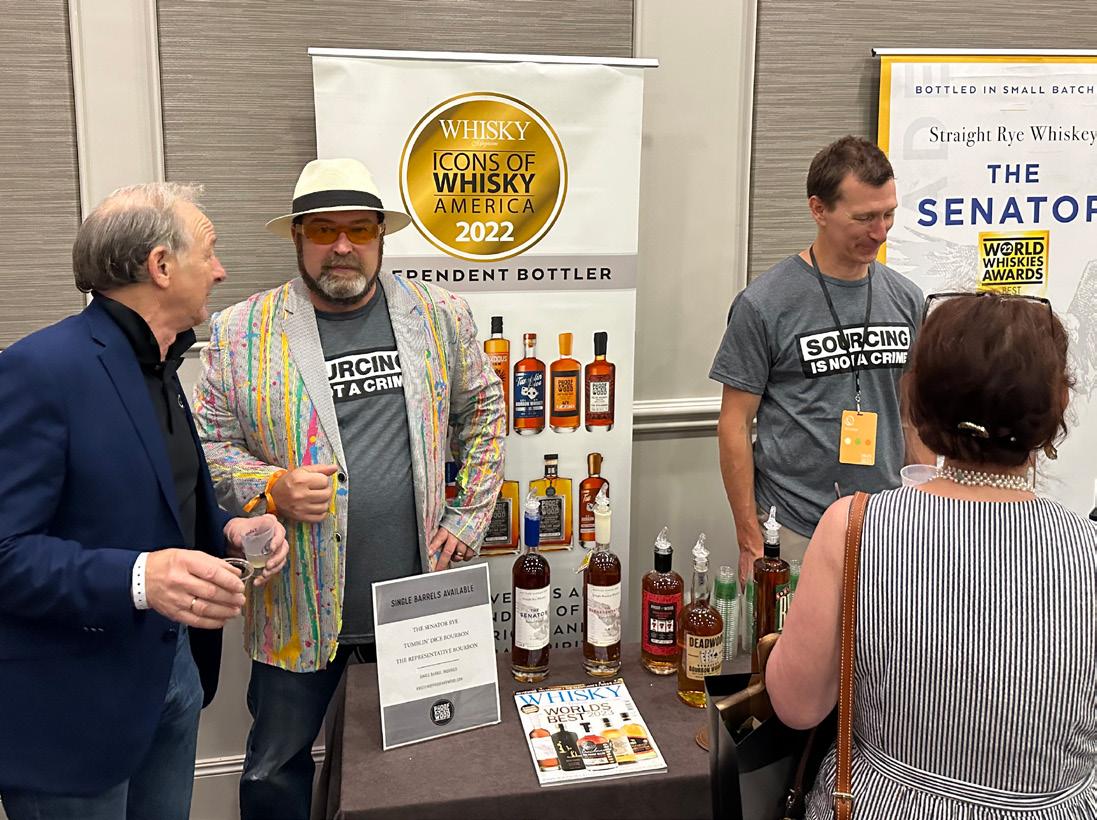
70 | SEPTEMBER/OCTOBER 2023 CRAFTSPIRITSMAG.COM snapshots
Golden Moon Distillery’s Stephen Gould at Indie Spirits That Rock
Dave Schmier of Proof and Wood Ventures (in the white hat)
Christopher Pellegrini of Honkaku Spirits at a happy hour hosted by the Japan Society of New Orleans at Banana Blossom Thai Restaurant
Michael Holiday of Chocolate City’s Best & 600T, Pronghorn’s Jomaree Pinkard & Catoctin Creek’s Becky Harris talk equity in the drinks industry


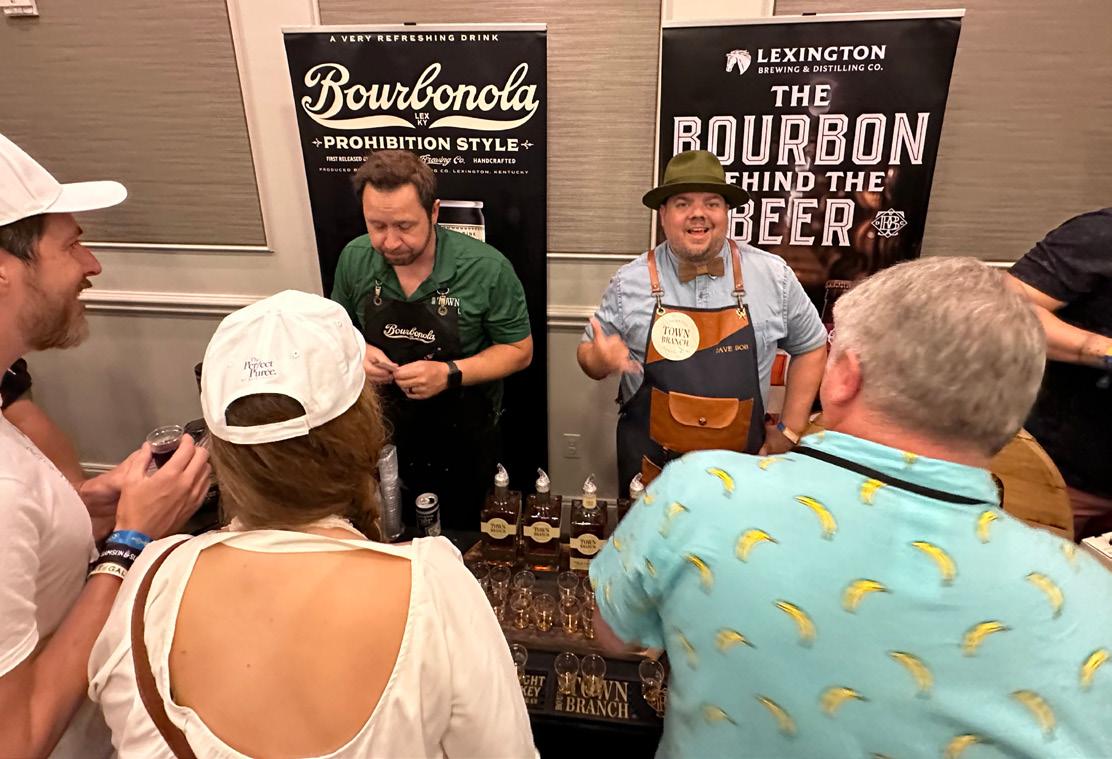



CRAFTSPIRITSMAG.COM SEPTEMBER/OCTOBER 2023 | 71 snapshots
Lexington Brewing & Distilling Co.
Keeper’s Heart Irish + American Whiskey
Ragged Branch Distillery at Indie Spirits That Rock
The Stonewall Inn Gives Back Initiative, The Lesbian Bar Project & Jägermeister urged bars & industry-affiliated businesses & organizations to become a certified Safe Space for the LGBTQIA+ community.
“Outlander” star Sam Heughan (left) was in town to promote his brand, Sassenach Gin. Tales Bookstore & Bitters Market

SAVE THE DATE ACSA’S 11TH ANNUAL DISTILLERS’ CONVENTION & VENDOR TRADE SHOW DENVER, COLORADO FEBRUARY 26-28, 2024

 BY JEFF CIOLETTI
BY JON PAGE
BY JEFF CIOLETTI
BY JON PAGE


 BY JOHN HOLL
BY JOHN HOLL



 BY DOUG PIERSON AND YOUN CHOI
BY DOUG PIERSON AND YOUN CHOI
 BY JOHN HOLL
BY JOHN HOLL




















































































































 BY JEFF CIOLETTI
BY JEFF CIOLETTI









 Christian, Ted and Blake Huber of Starlight Distillery
Christian, Ted and Blake Huber of Starlight Distillery



 STORY BY JON PAGE | PHOTOGRAPHY BY KATY BIRCKHEAD
STORY BY JON PAGE | PHOTOGRAPHY BY KATY BIRCKHEAD






















































